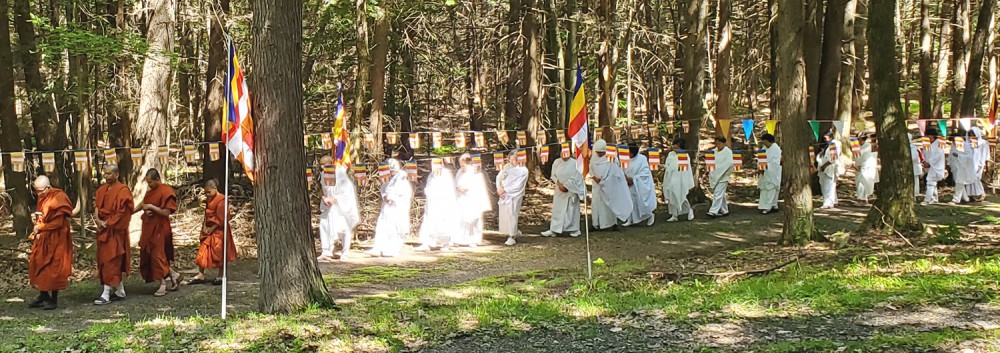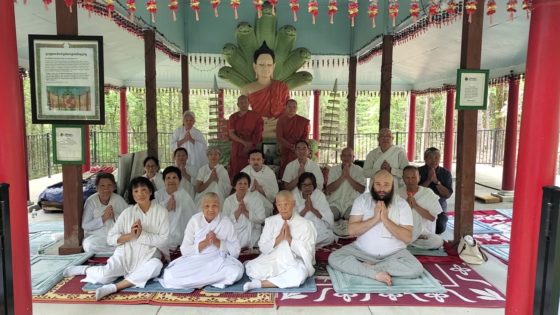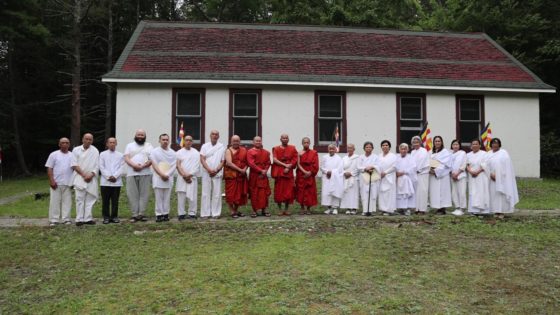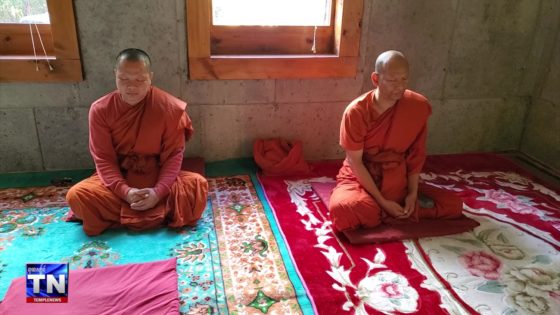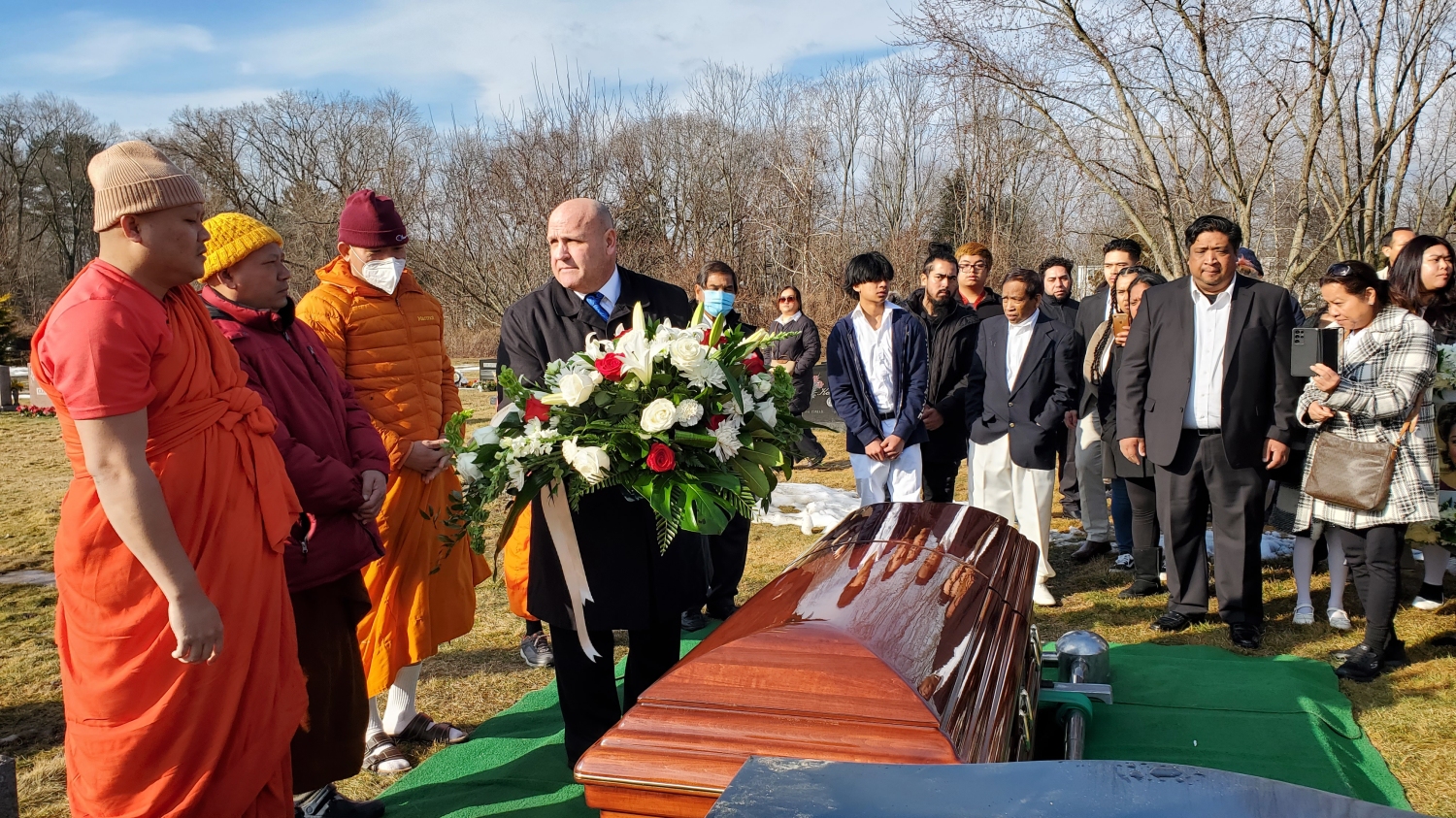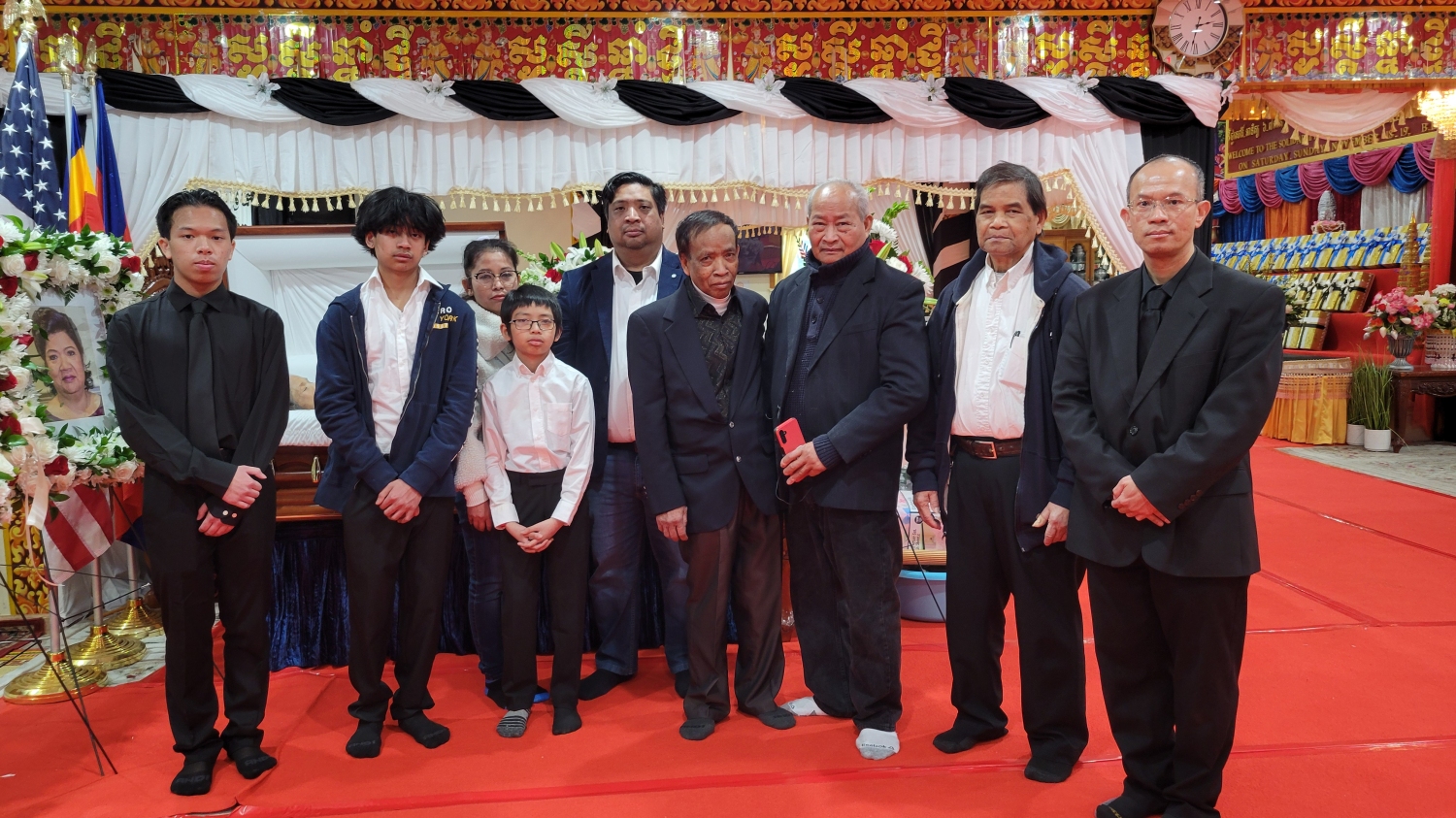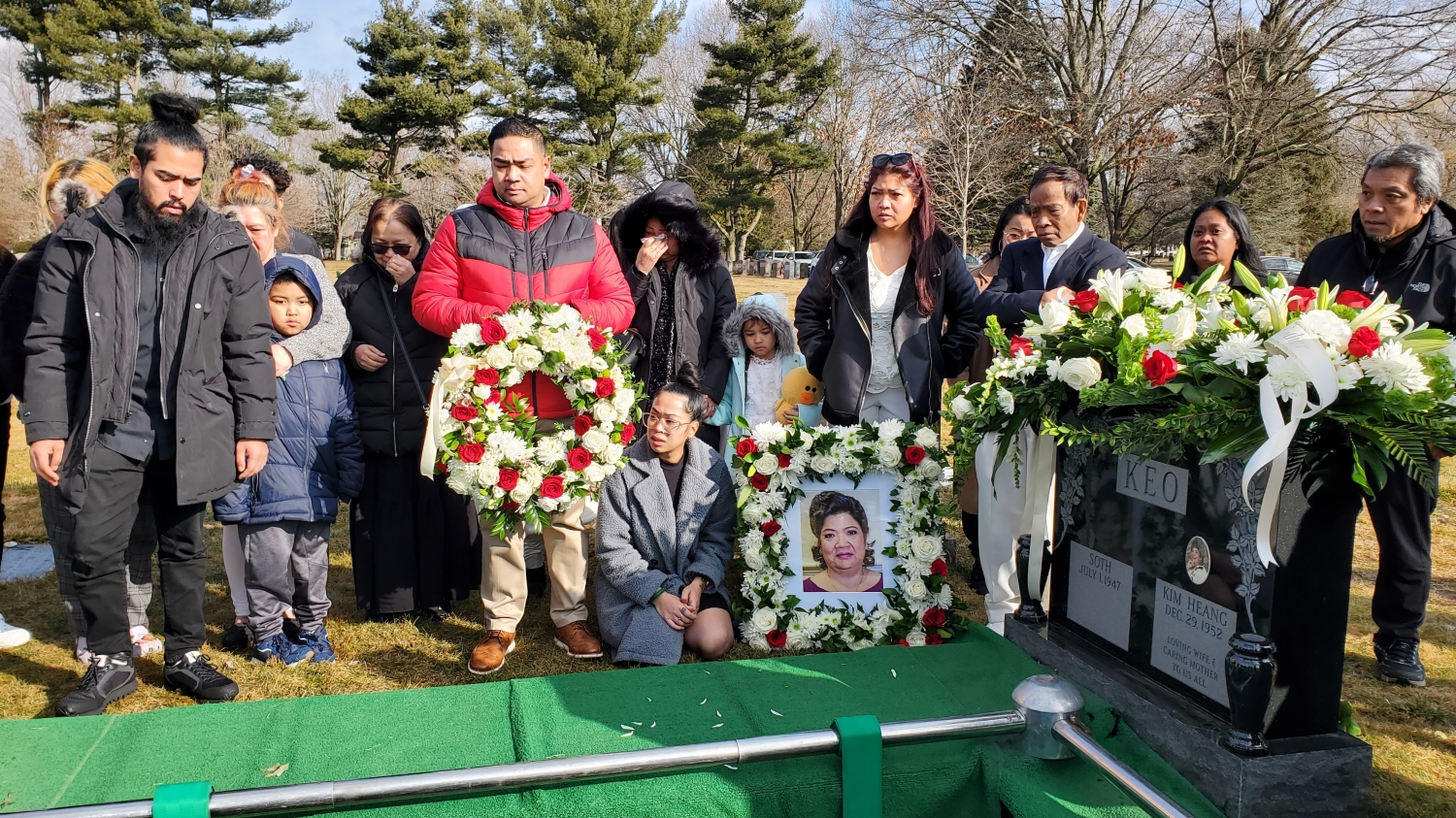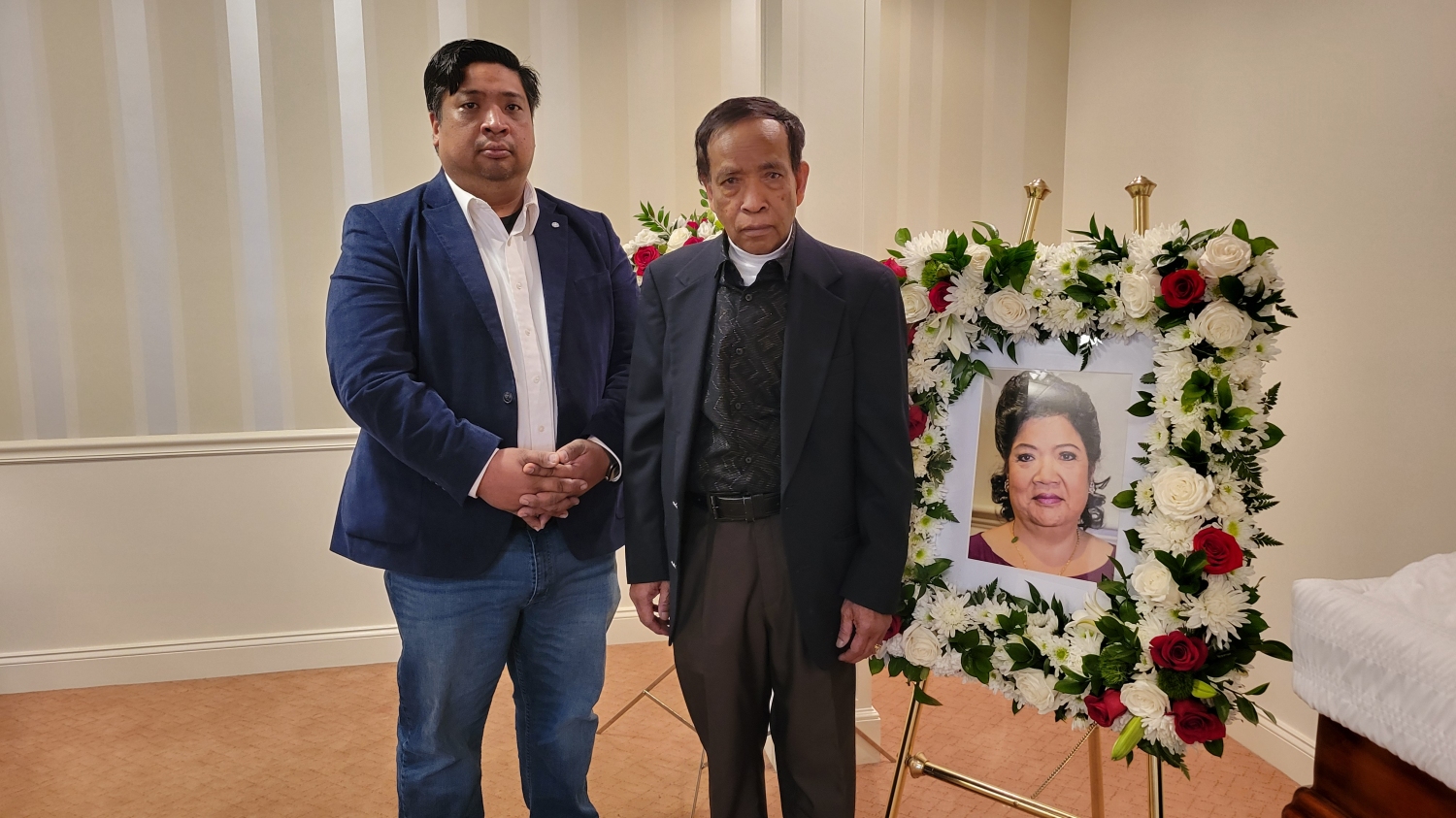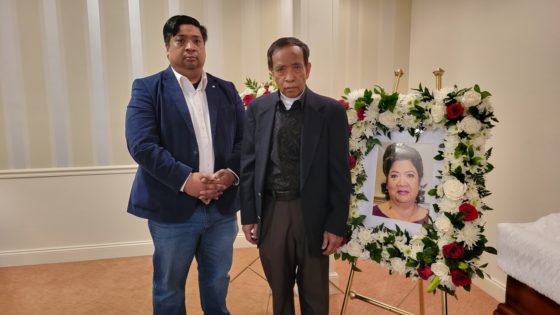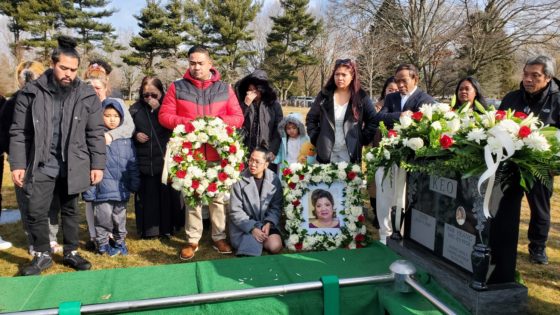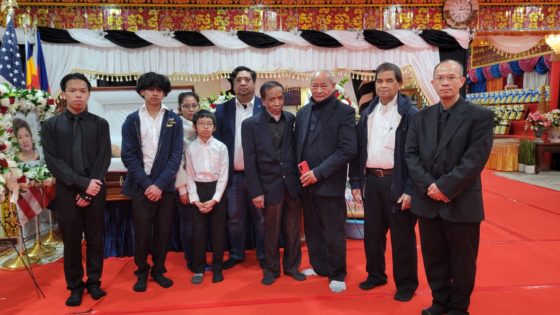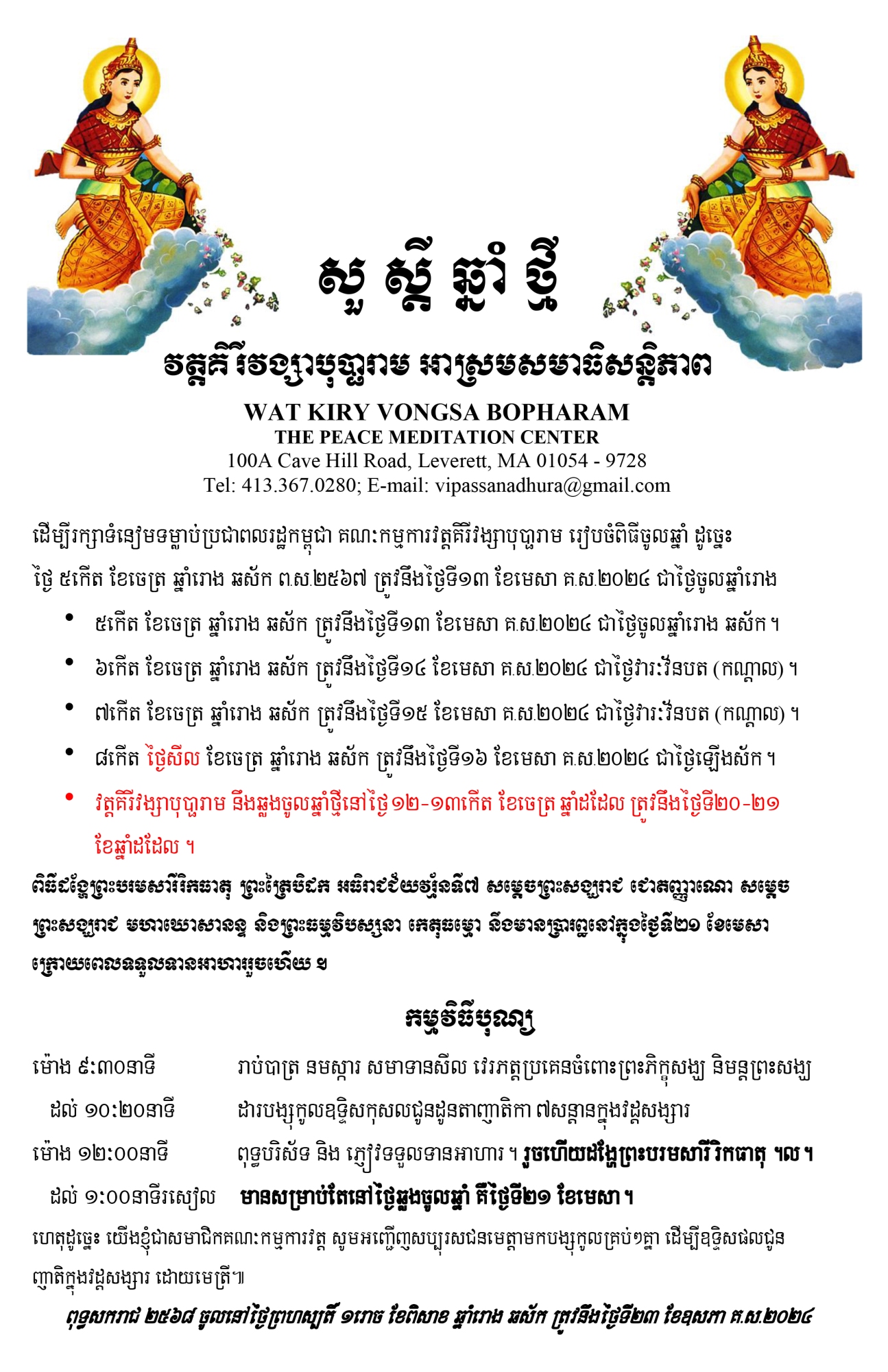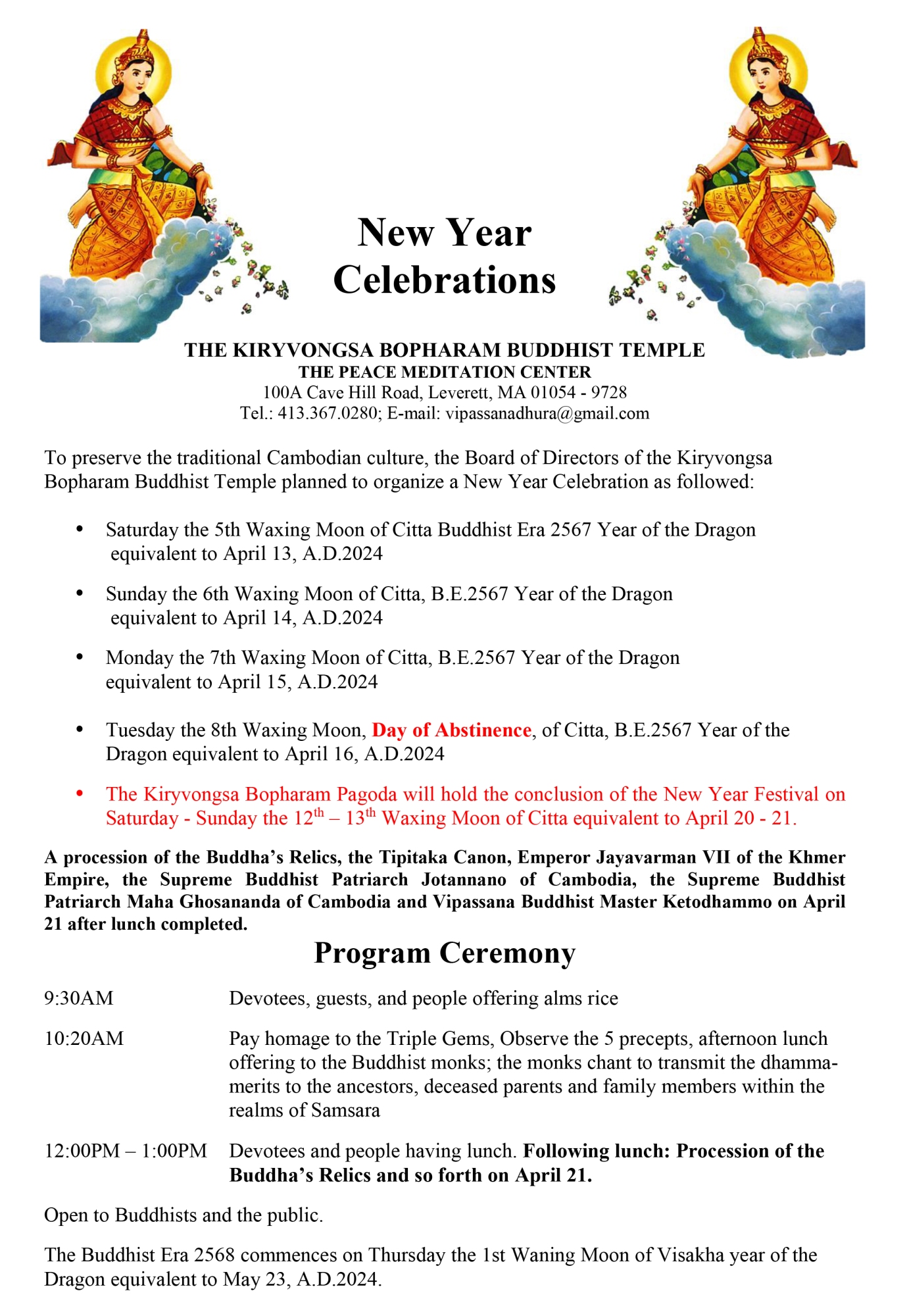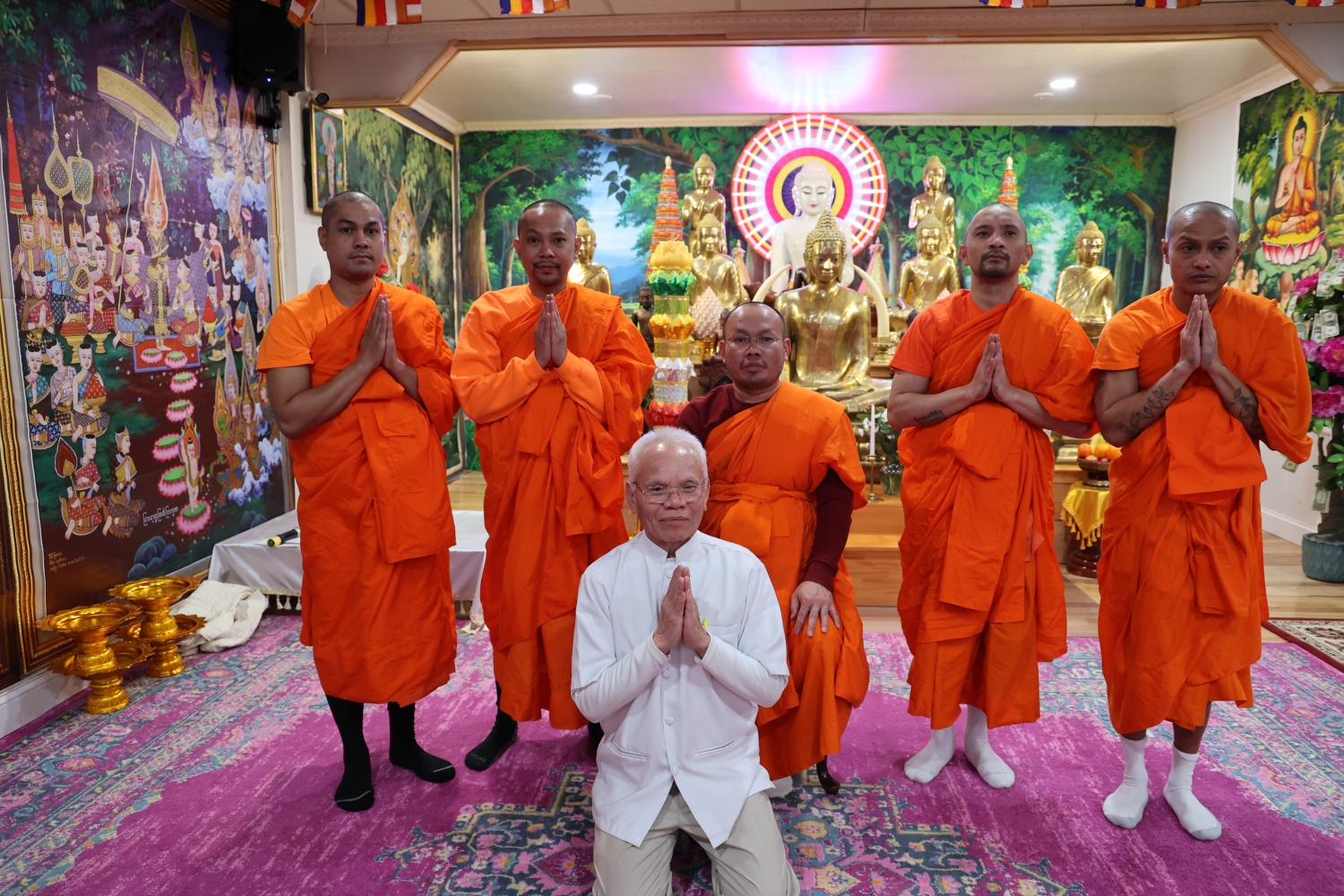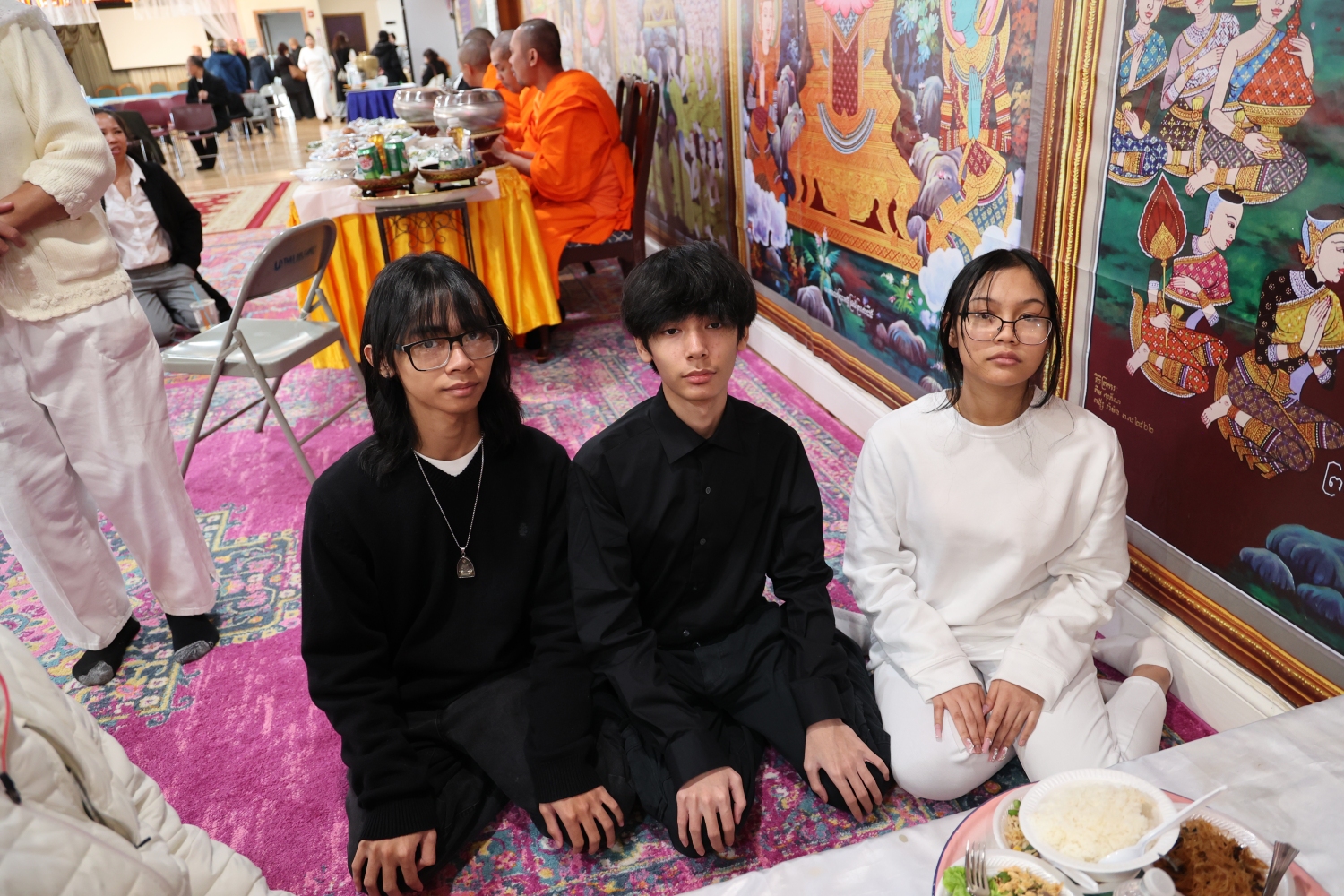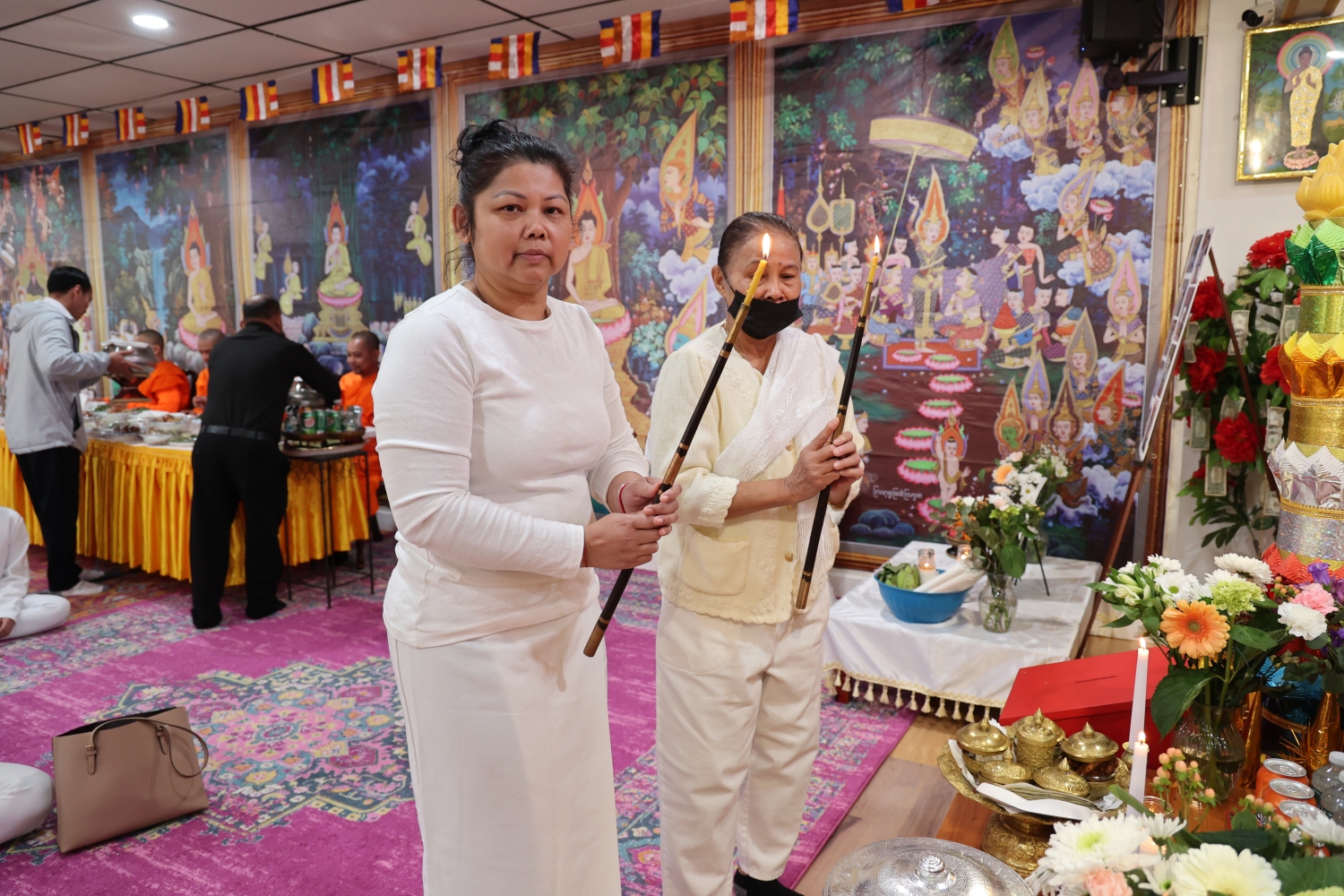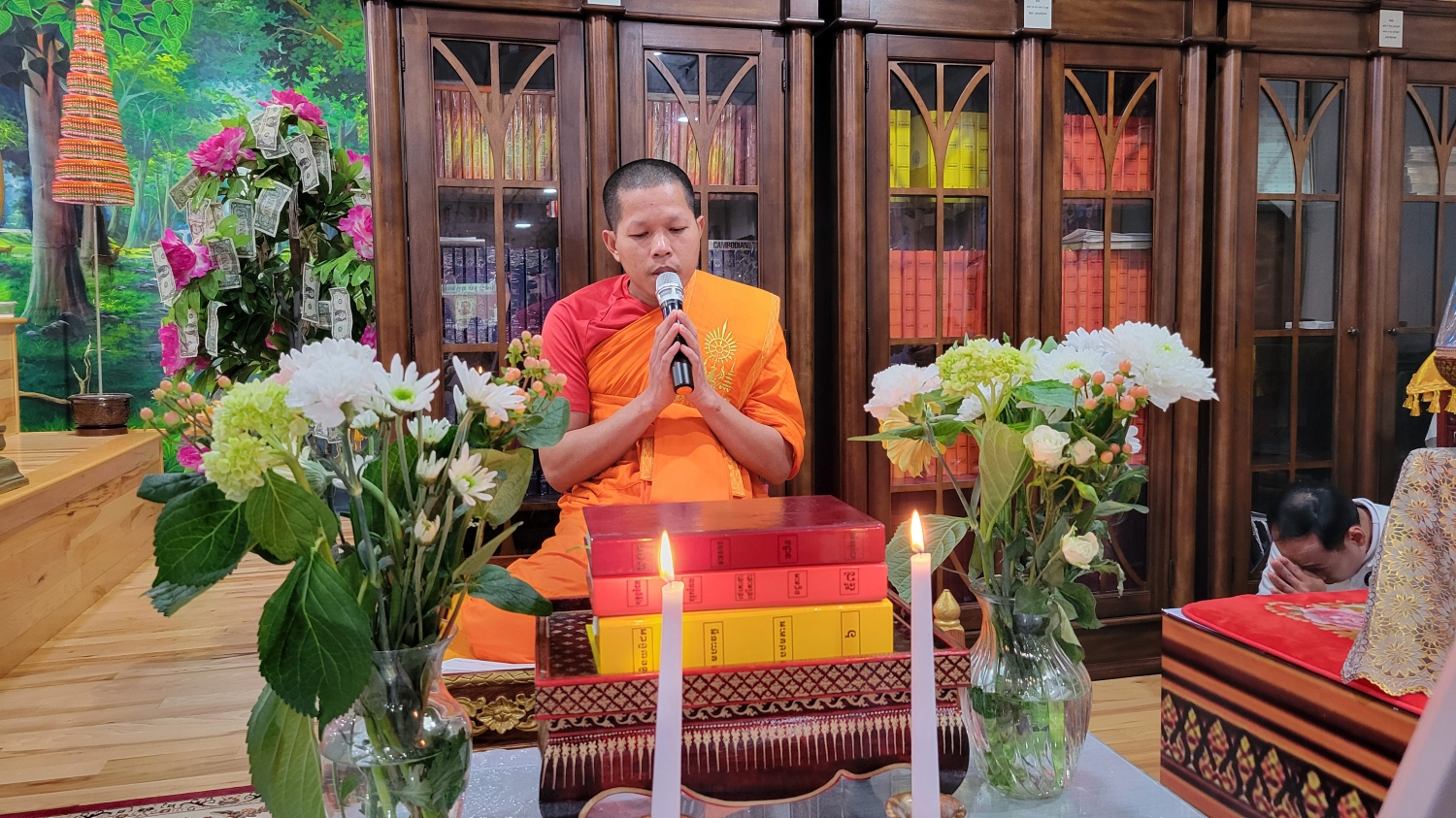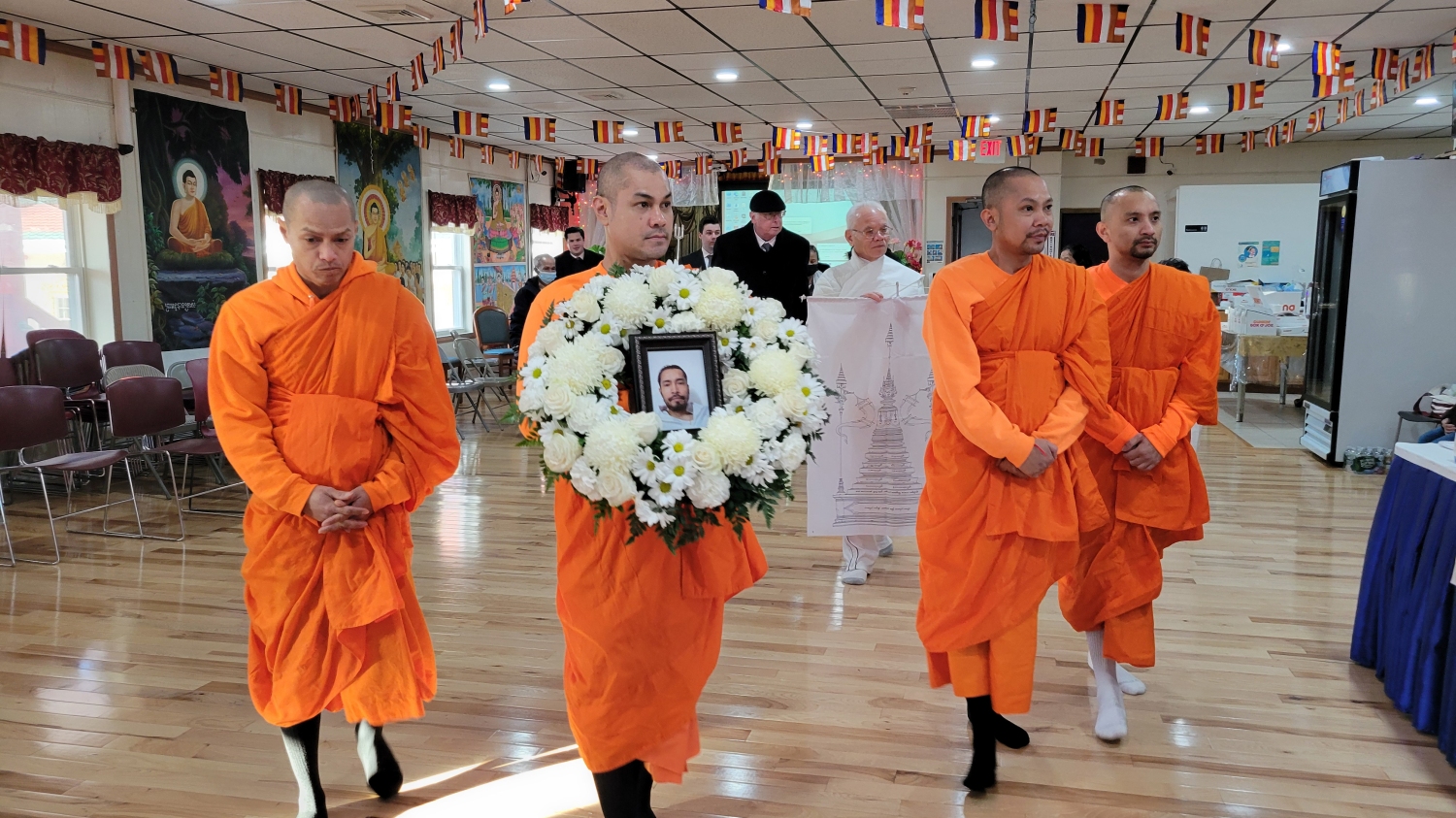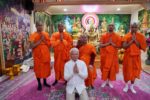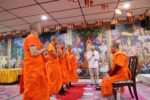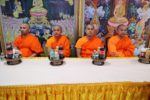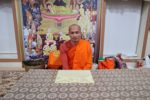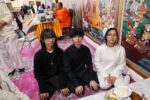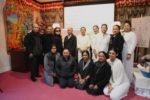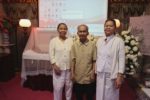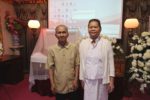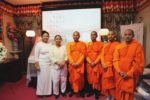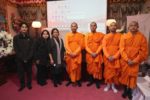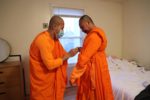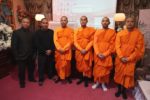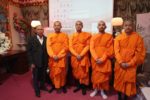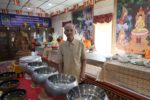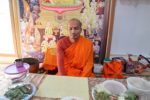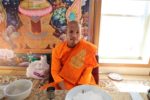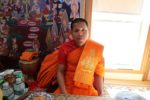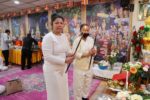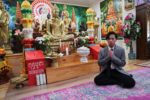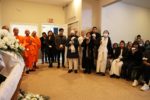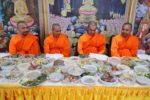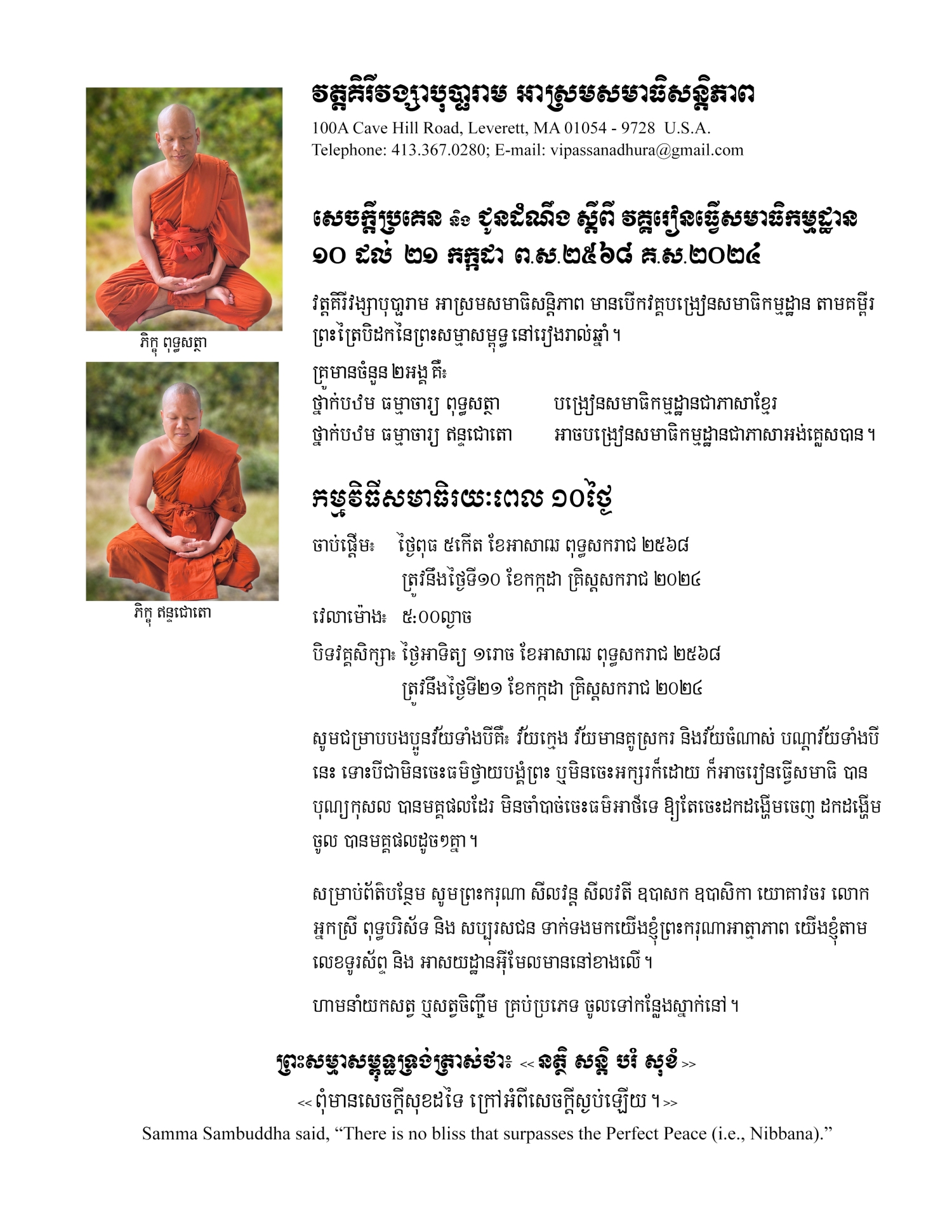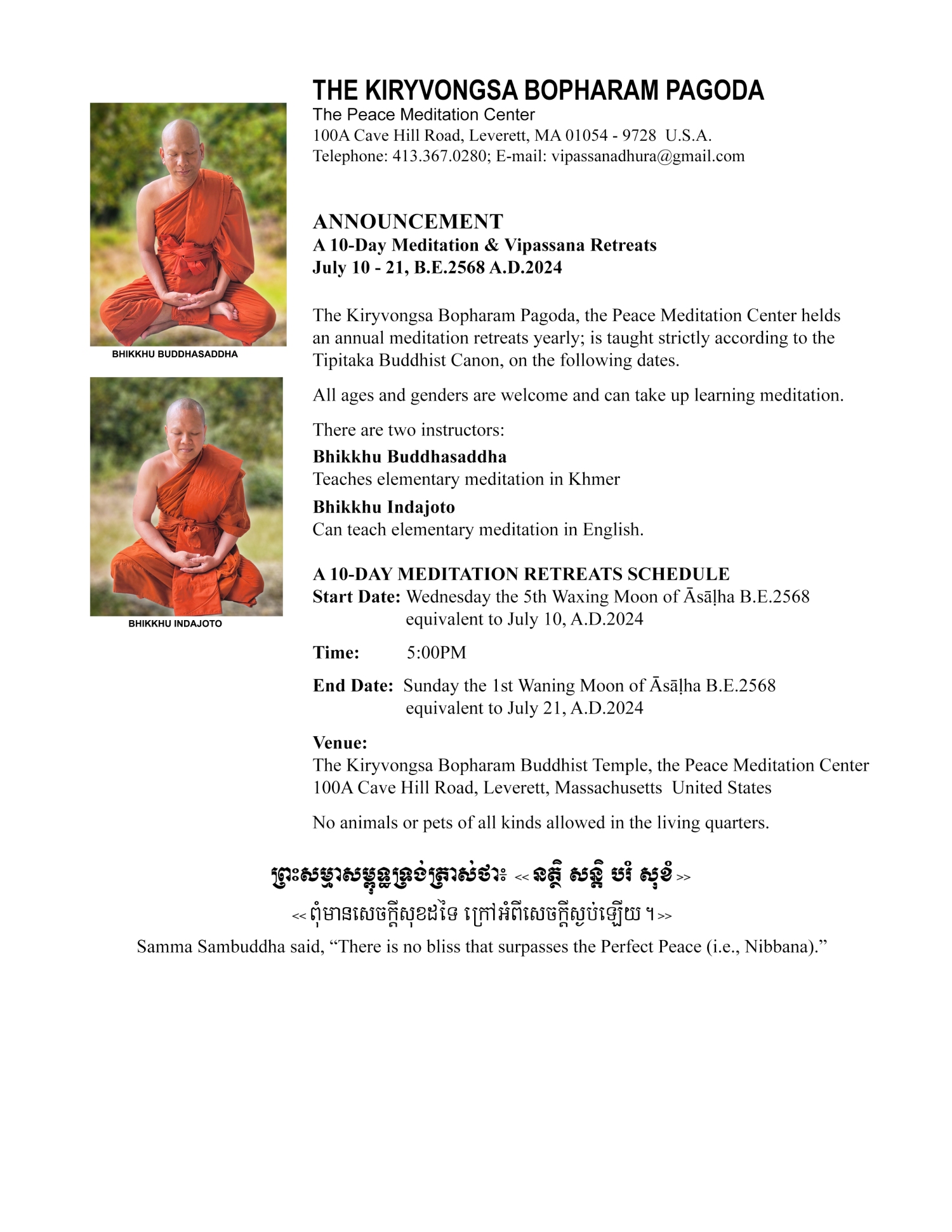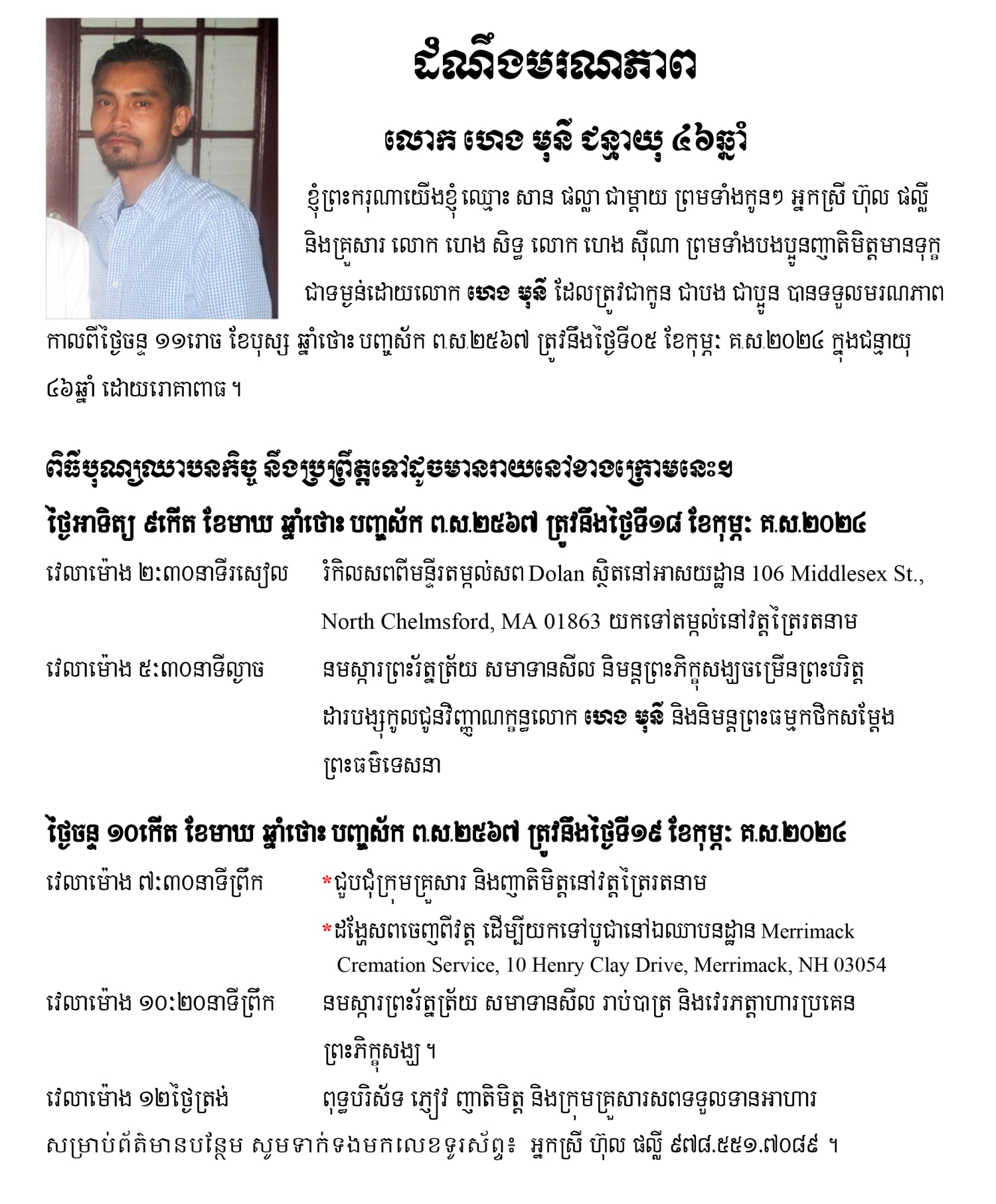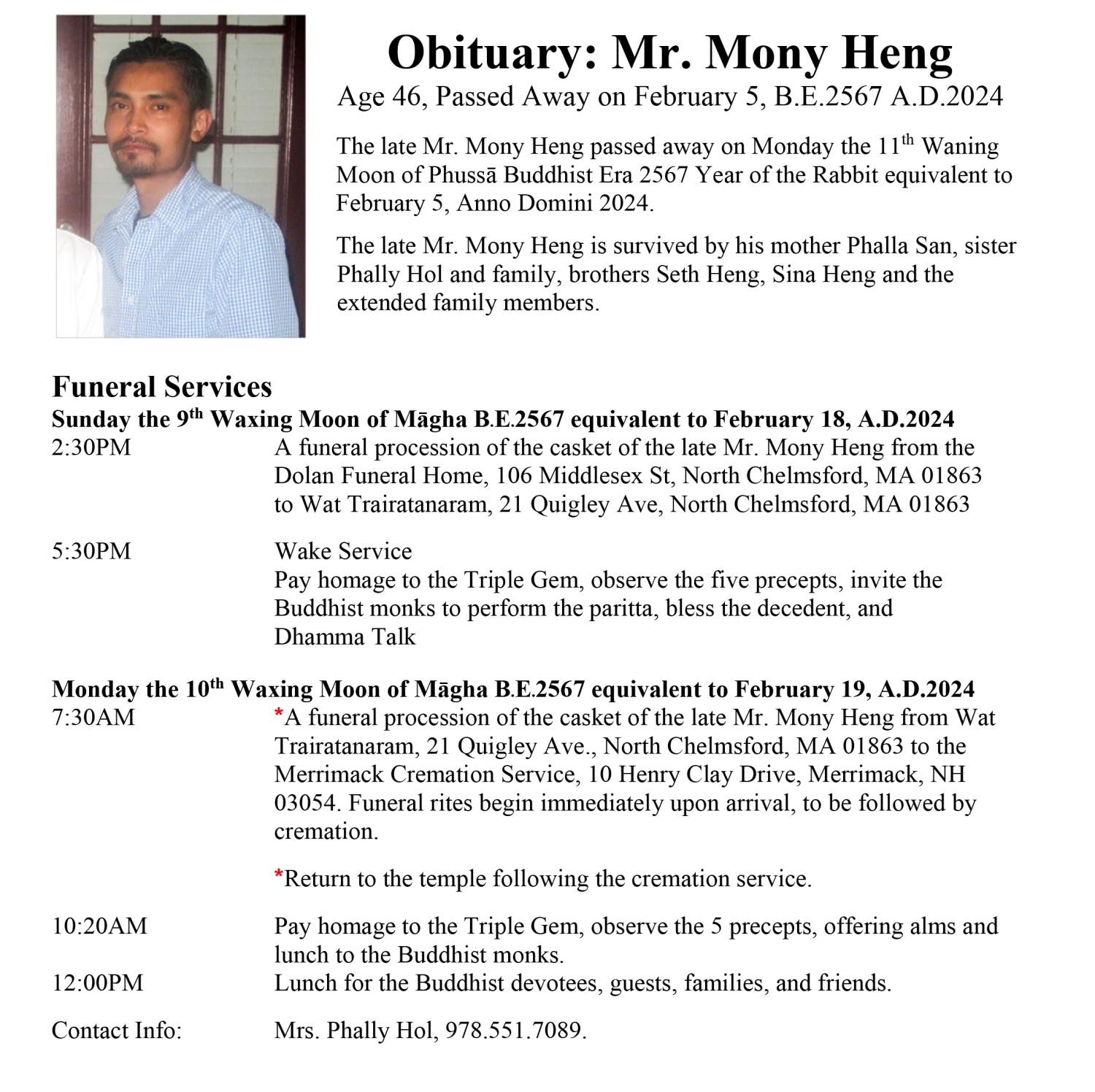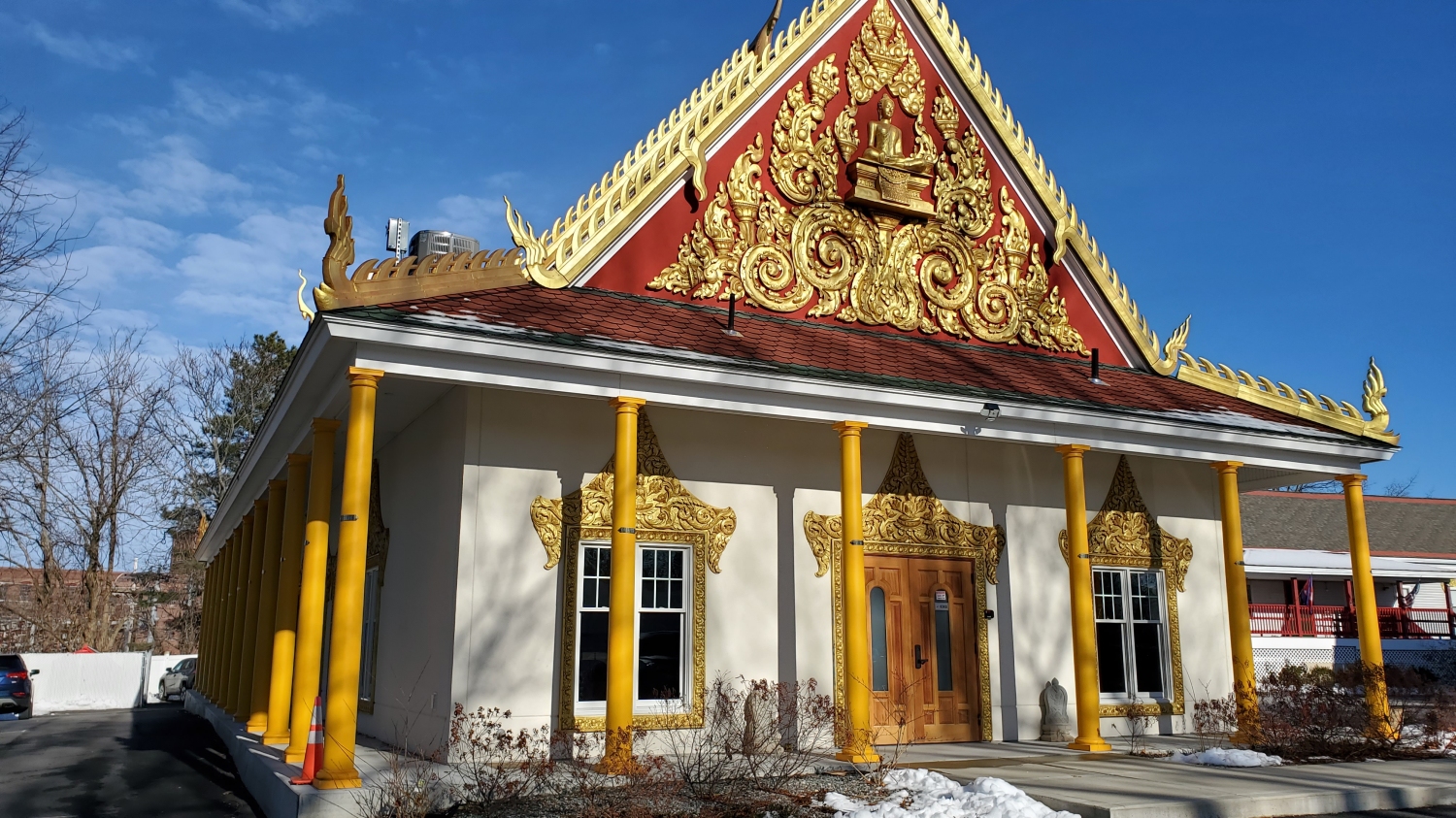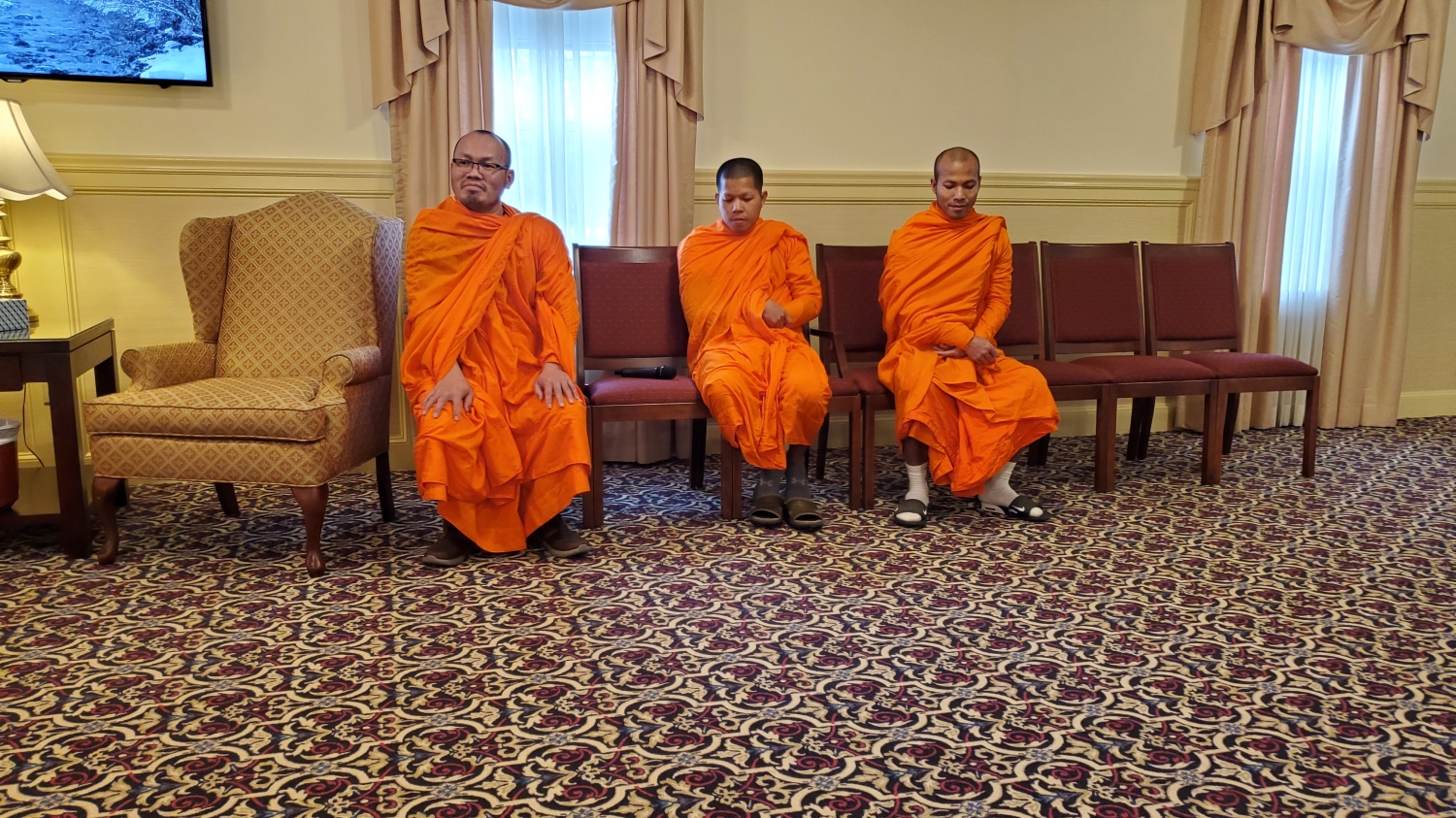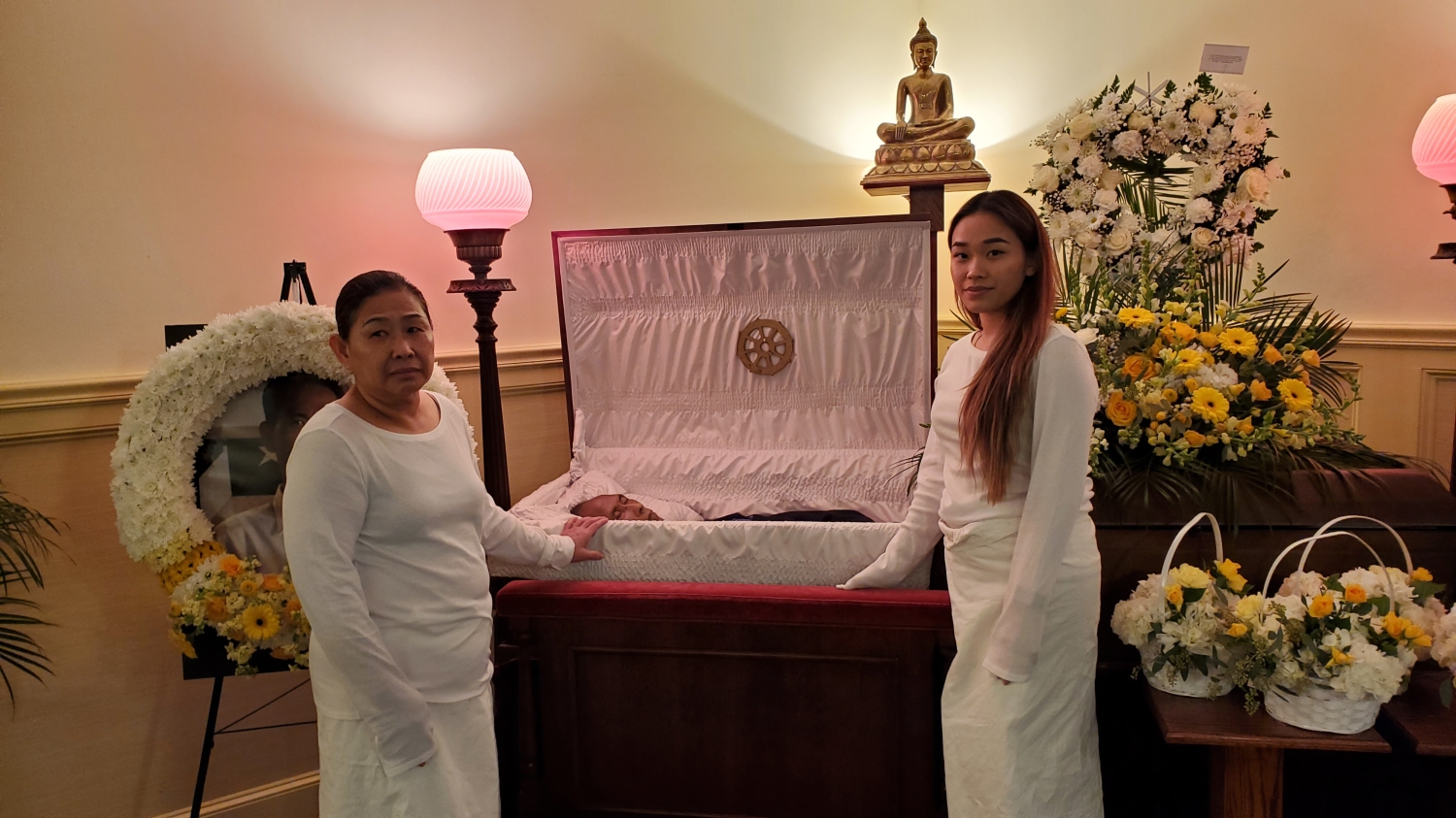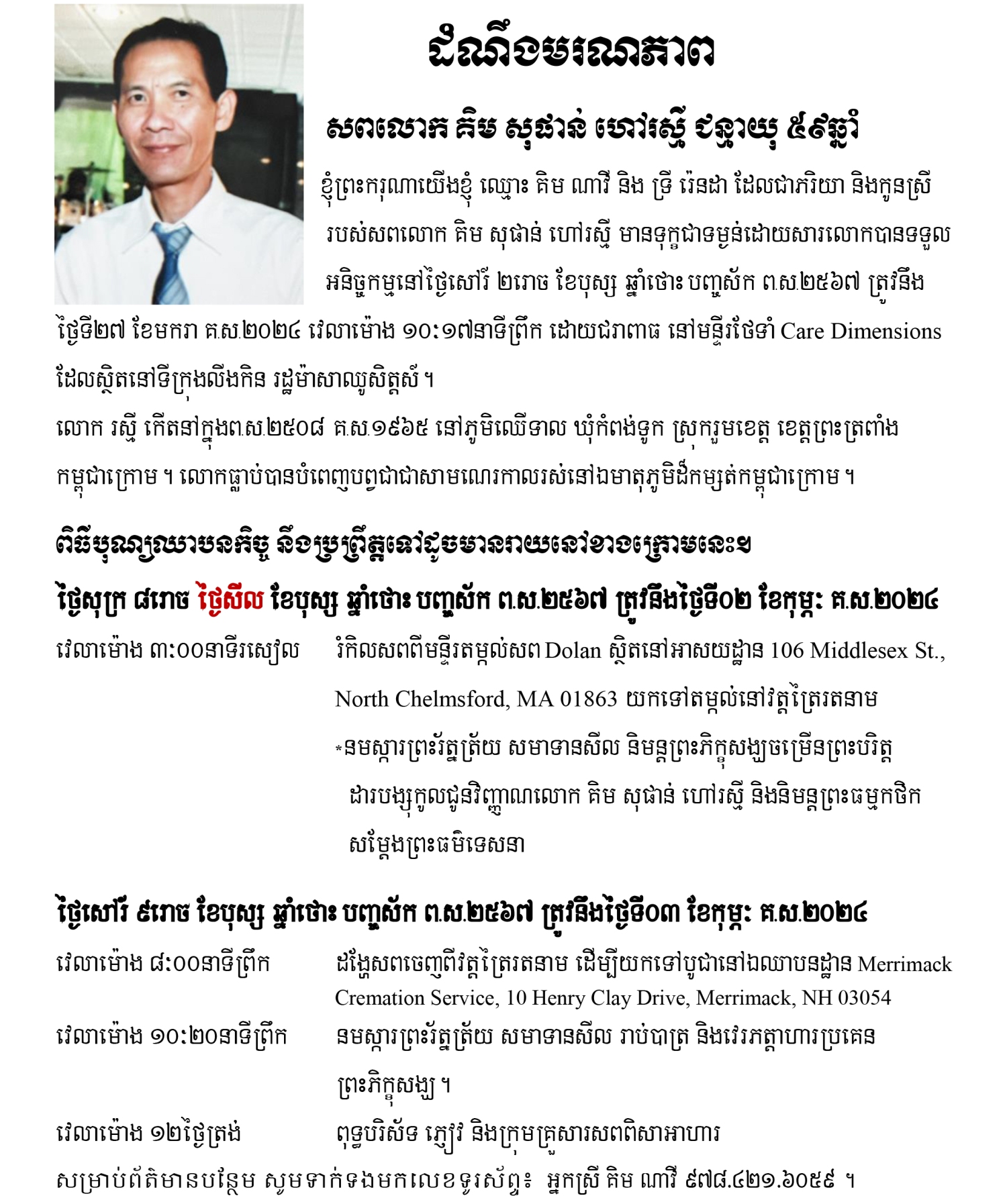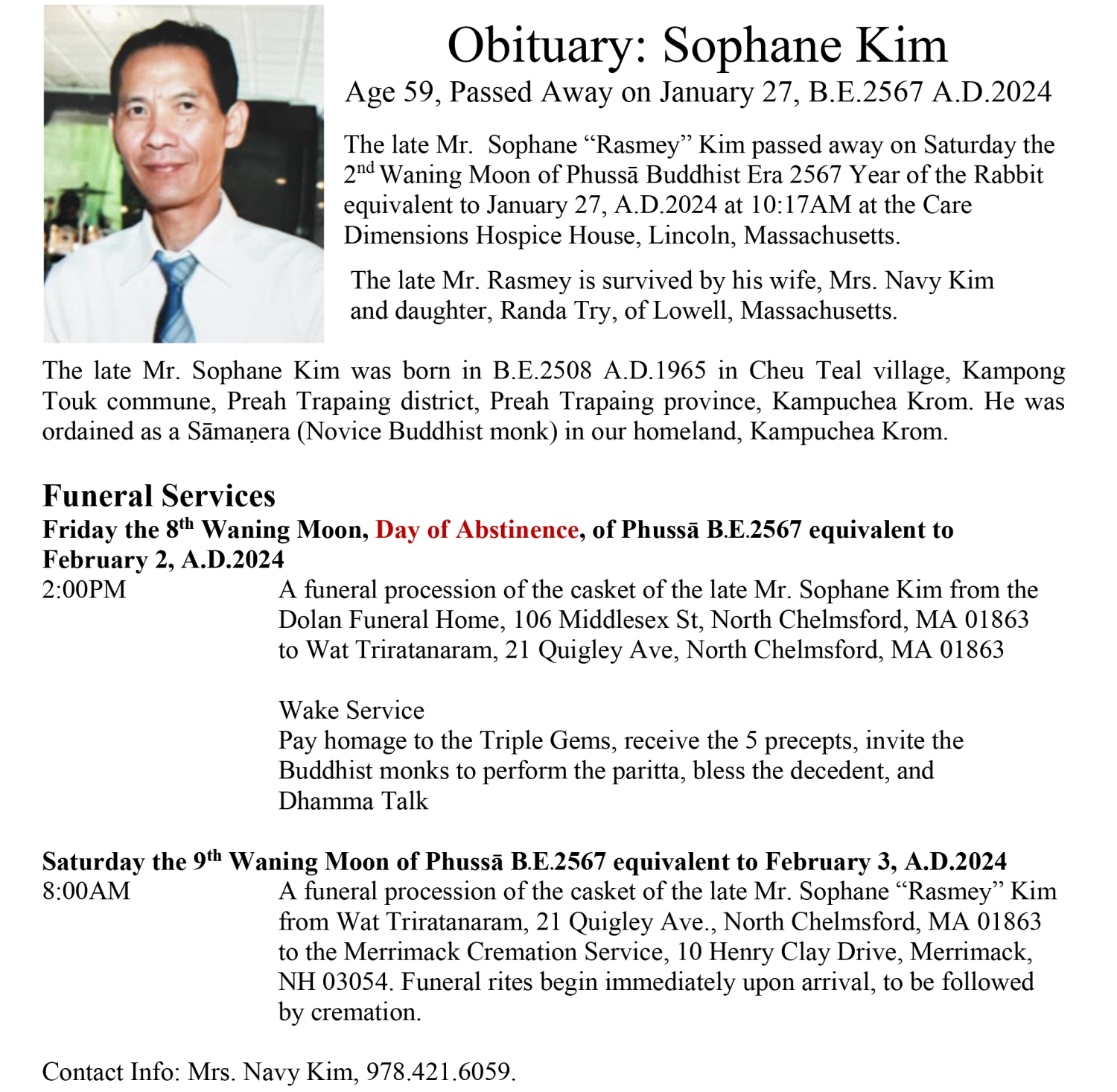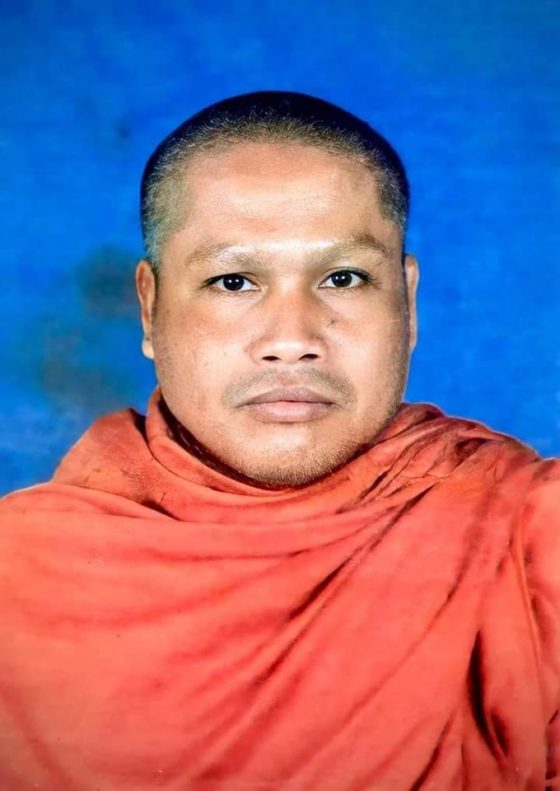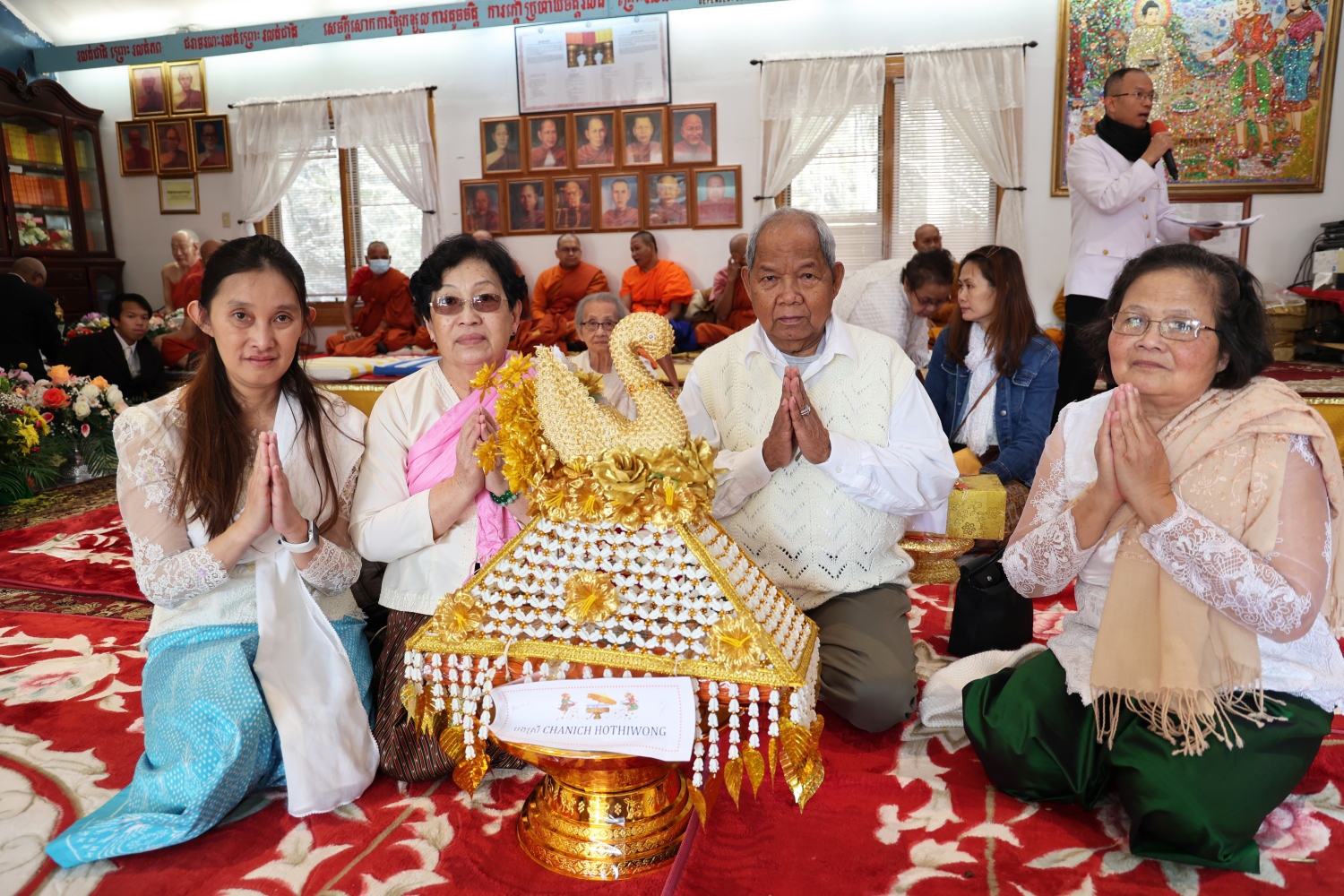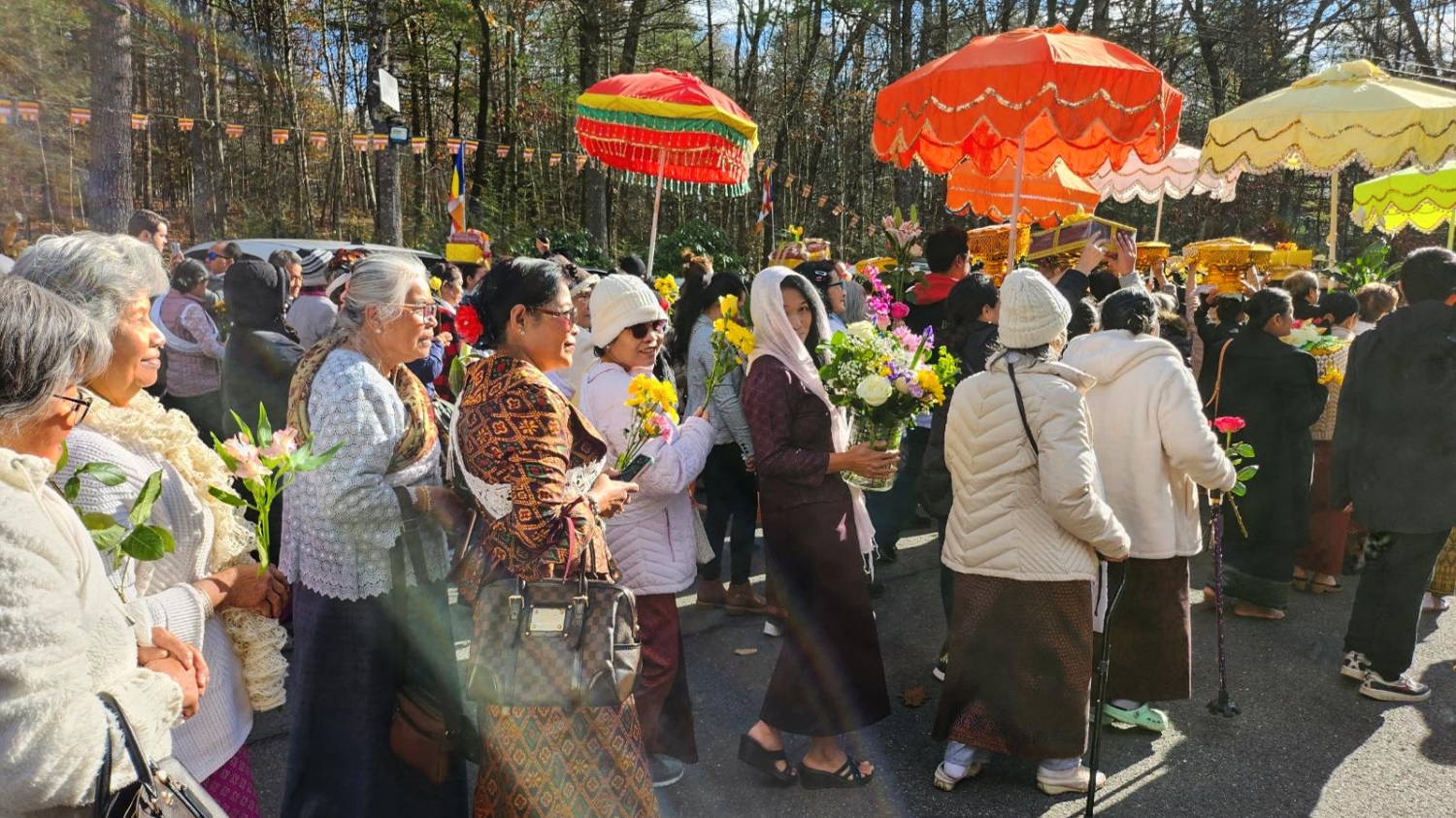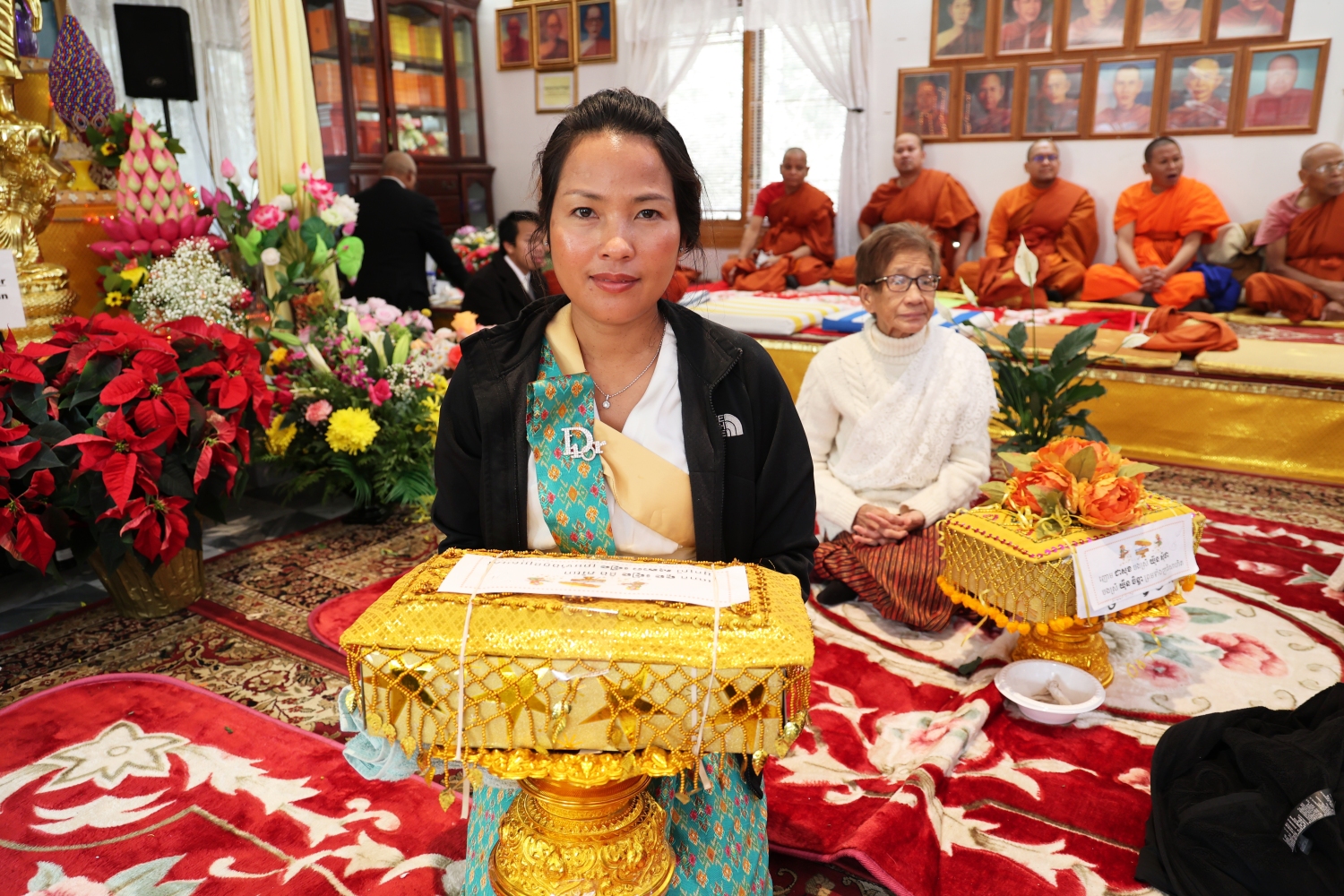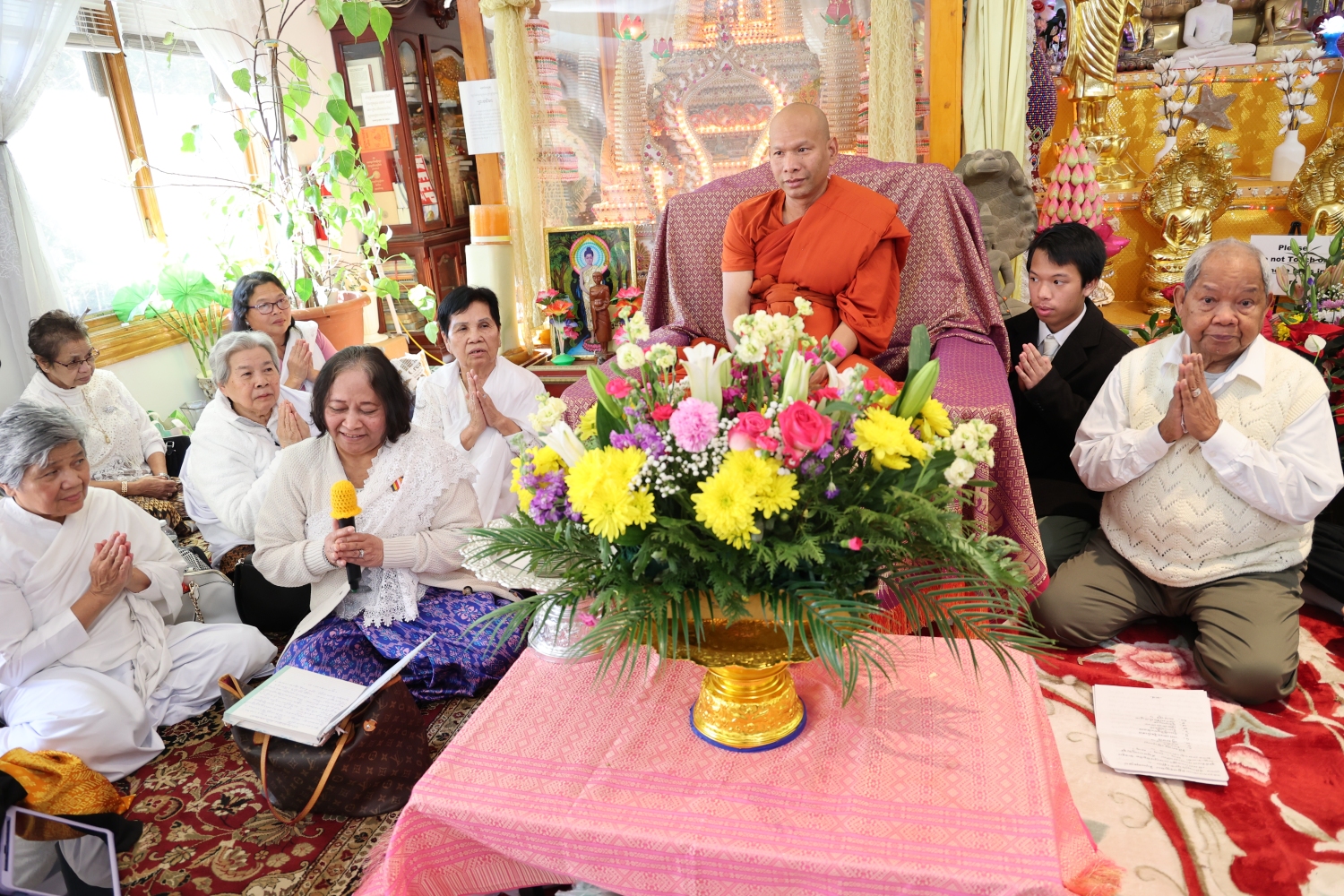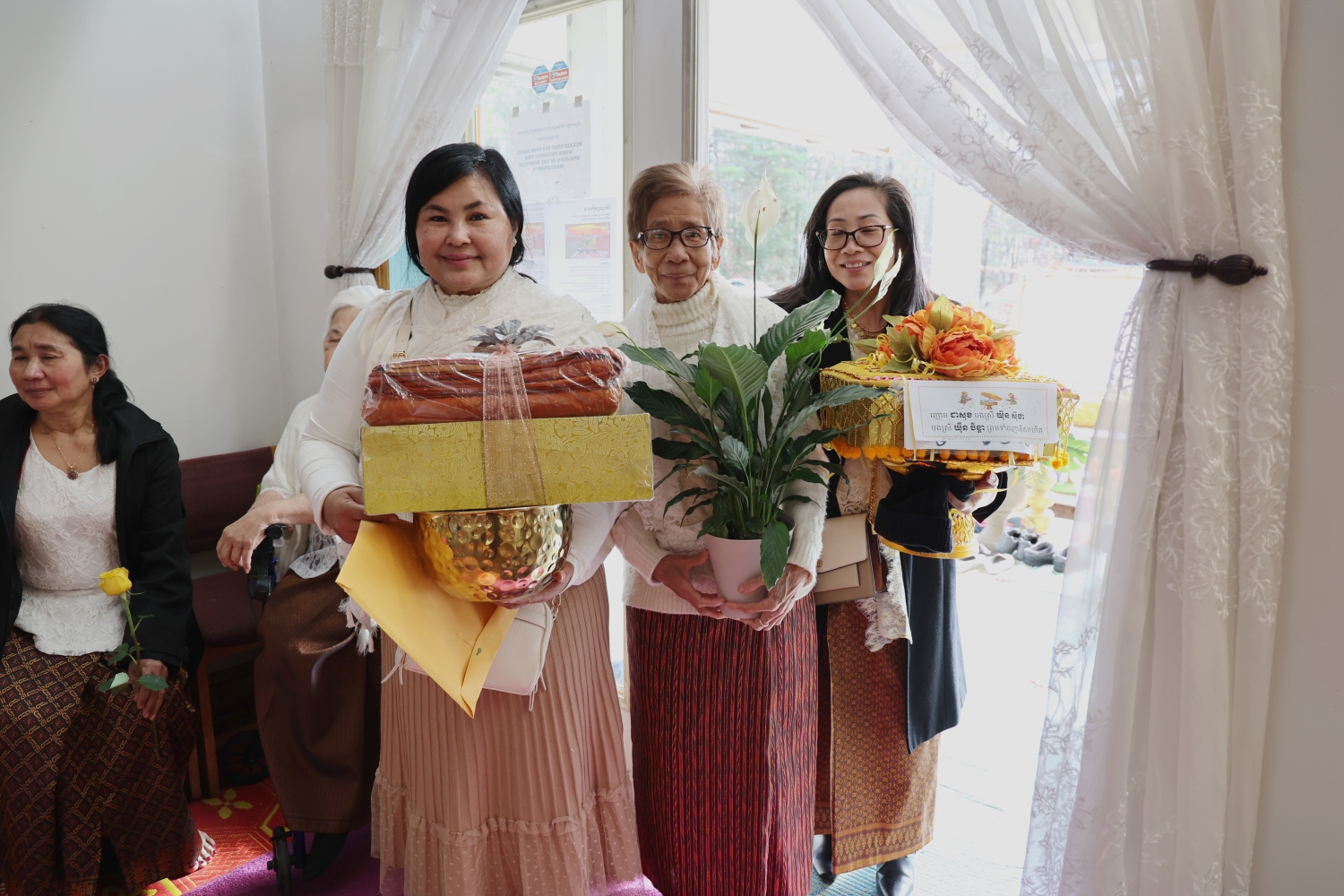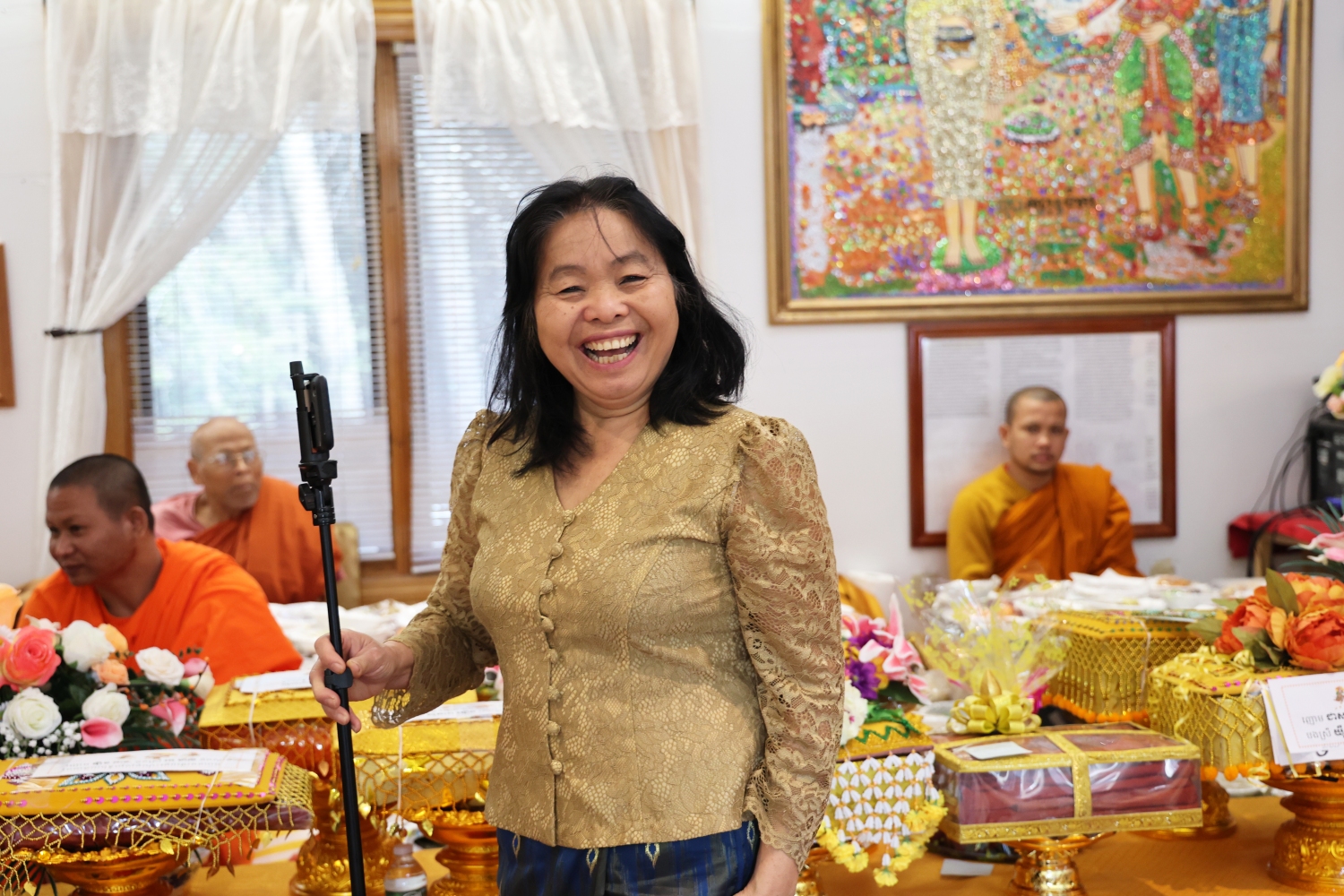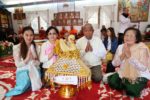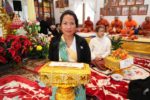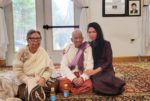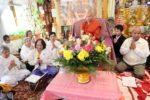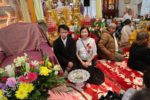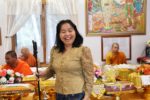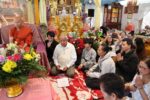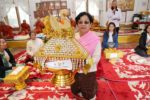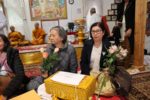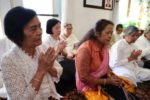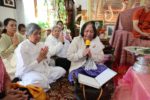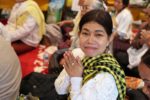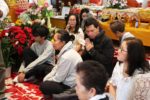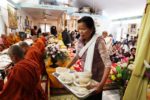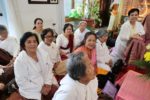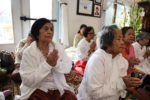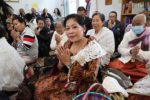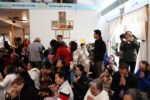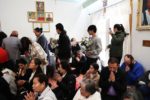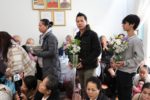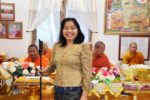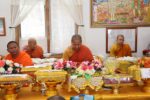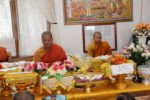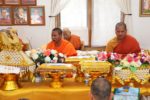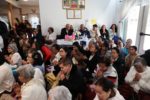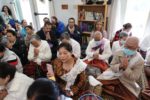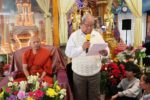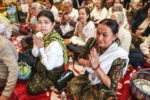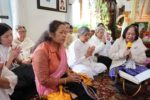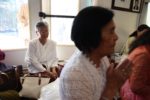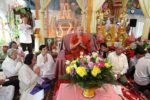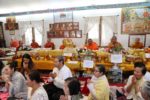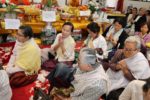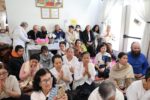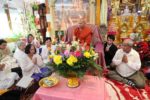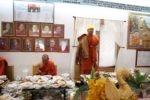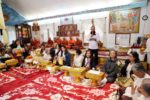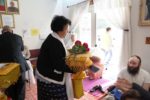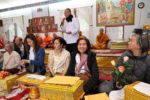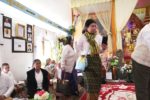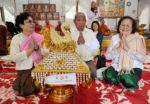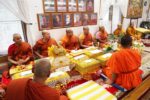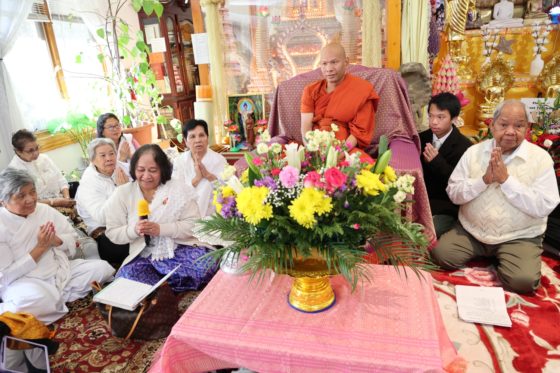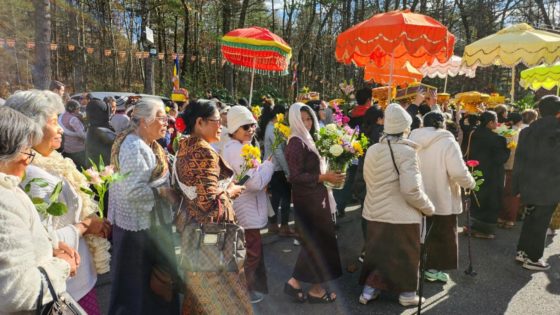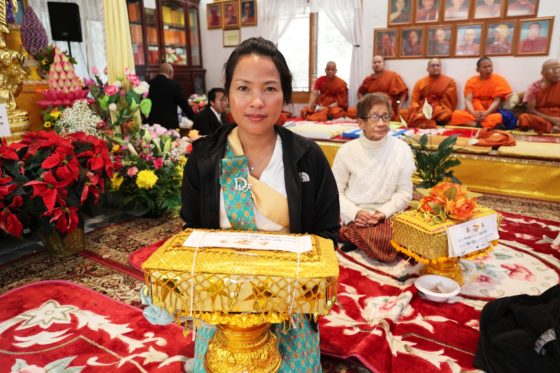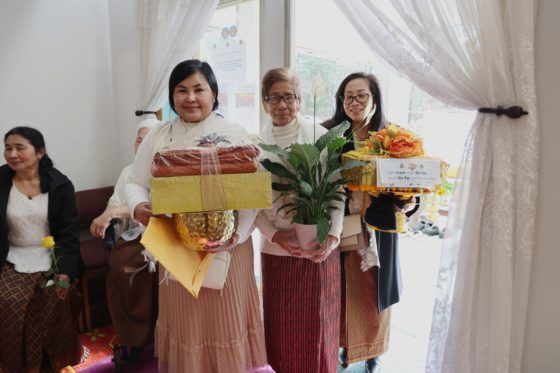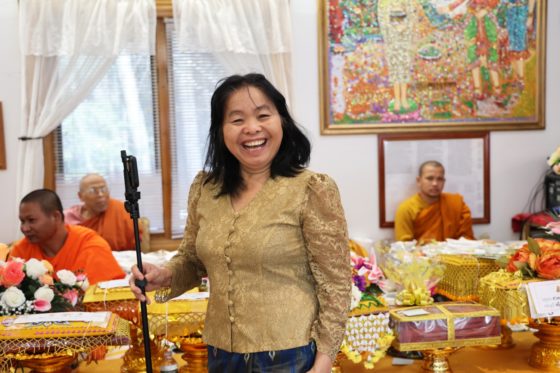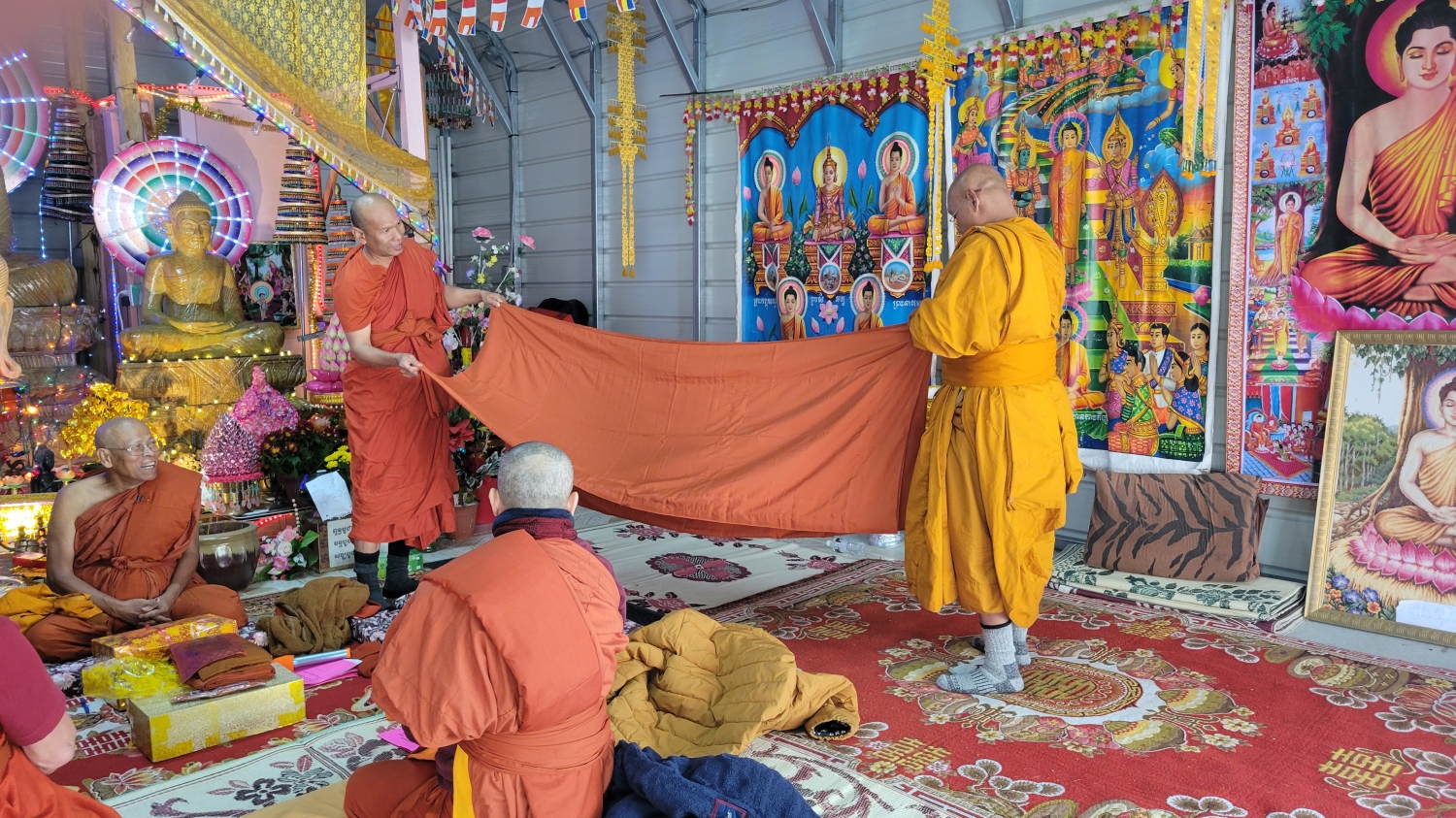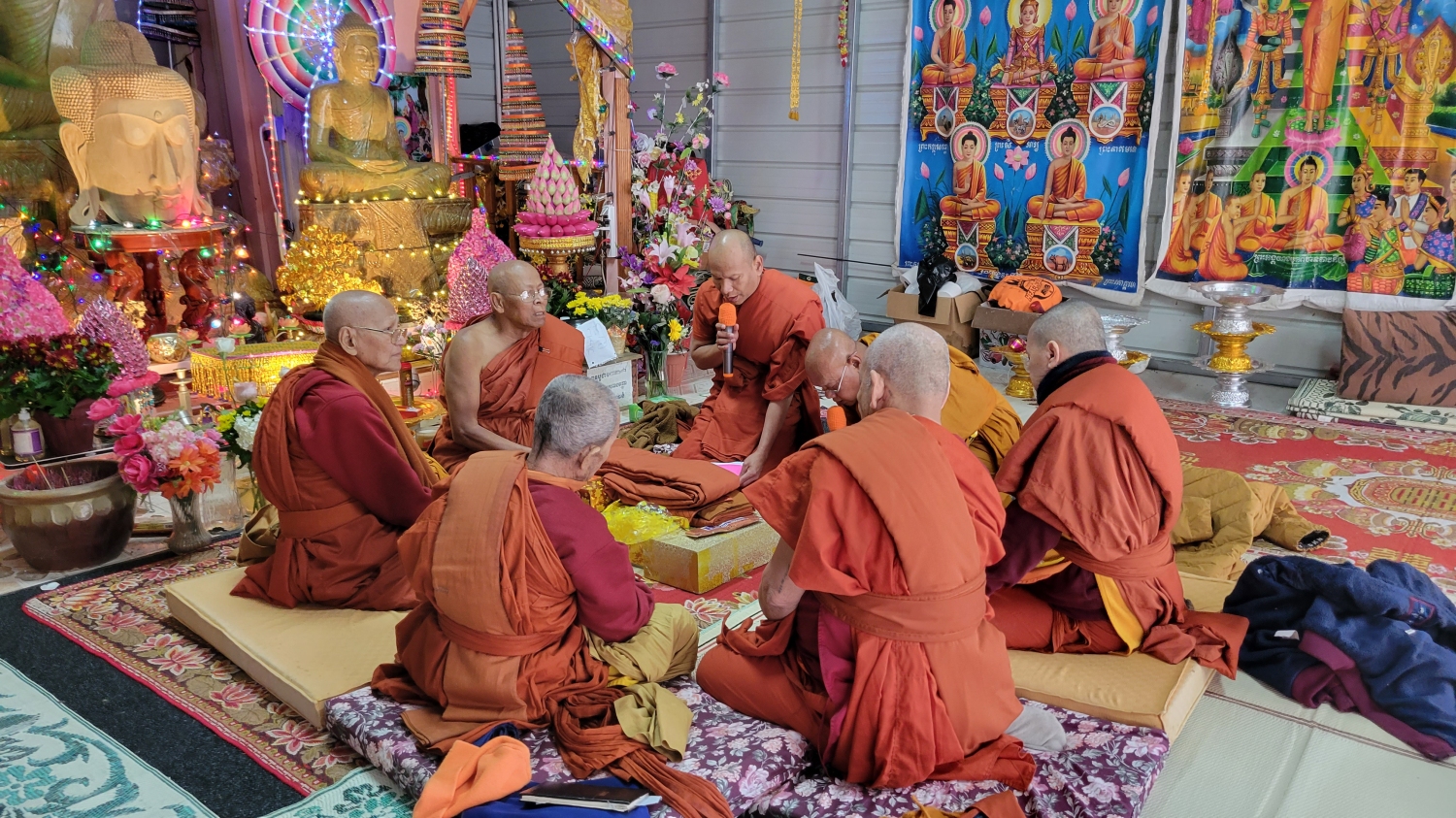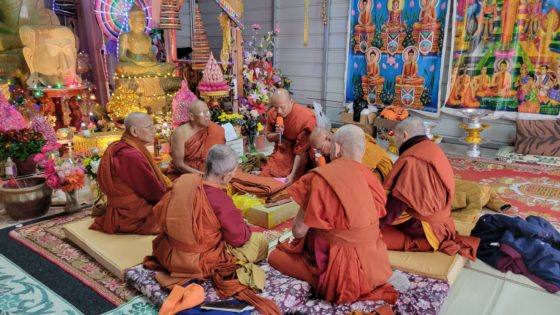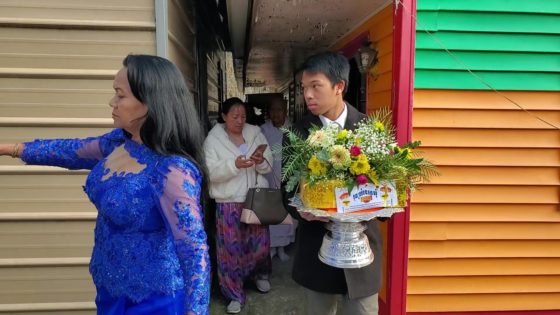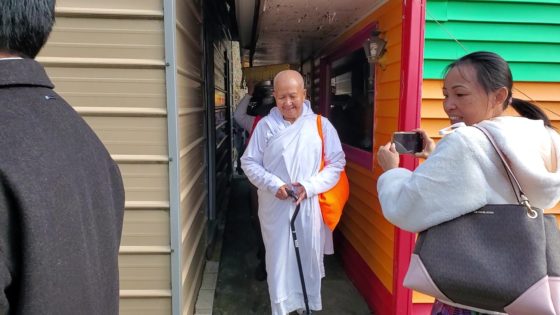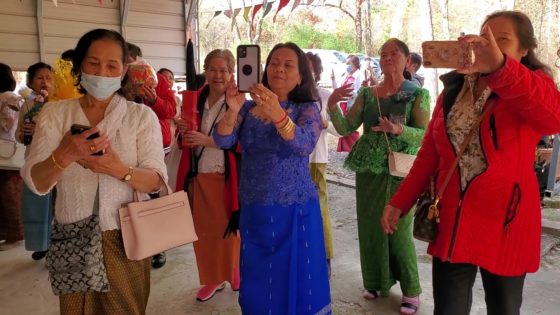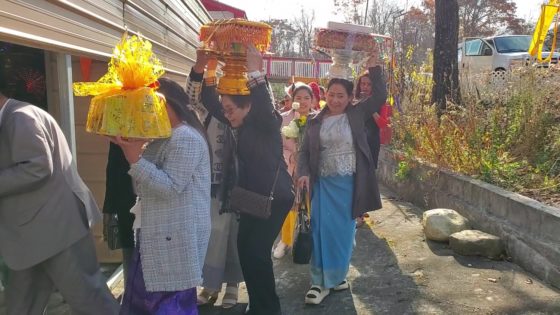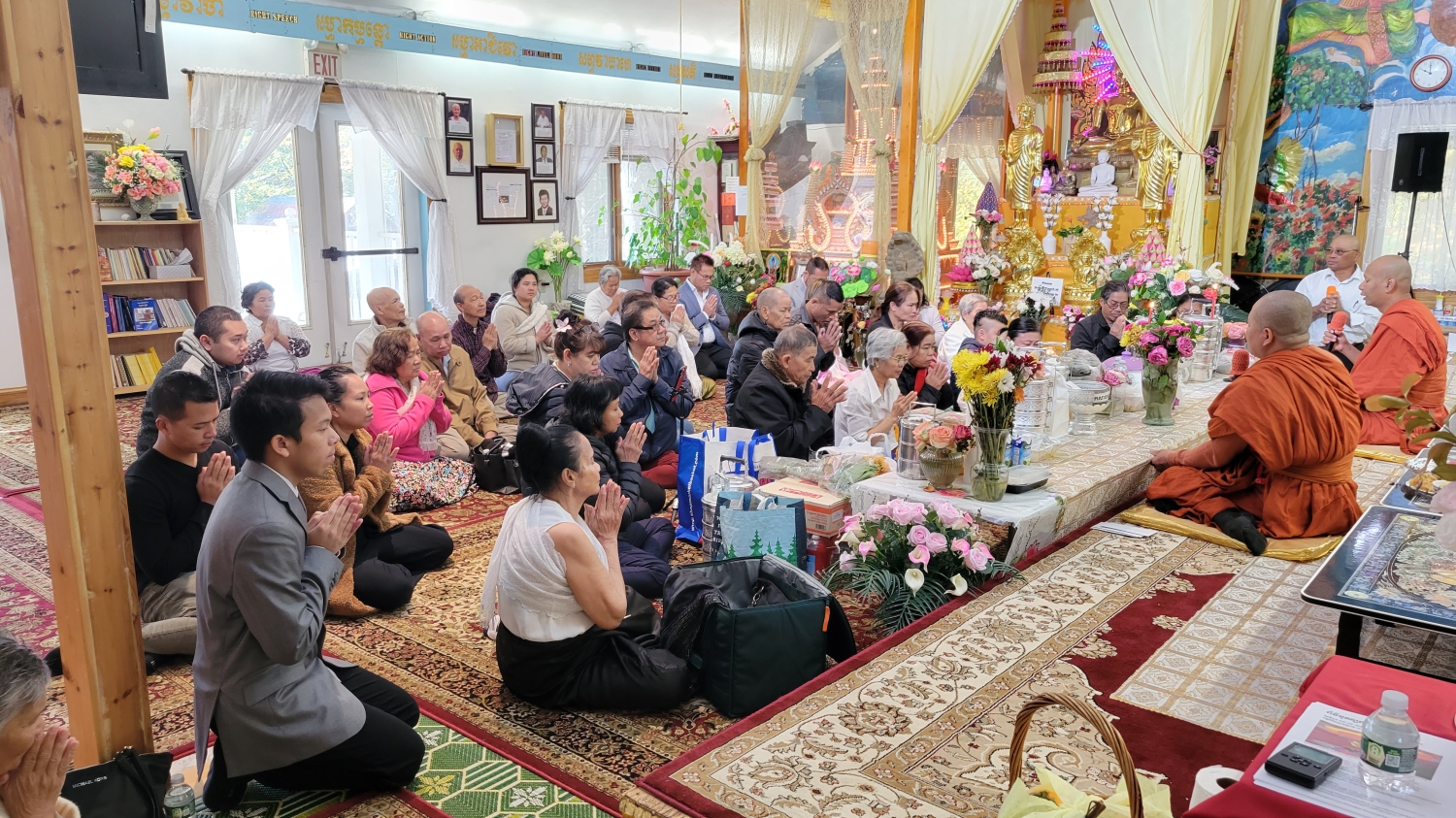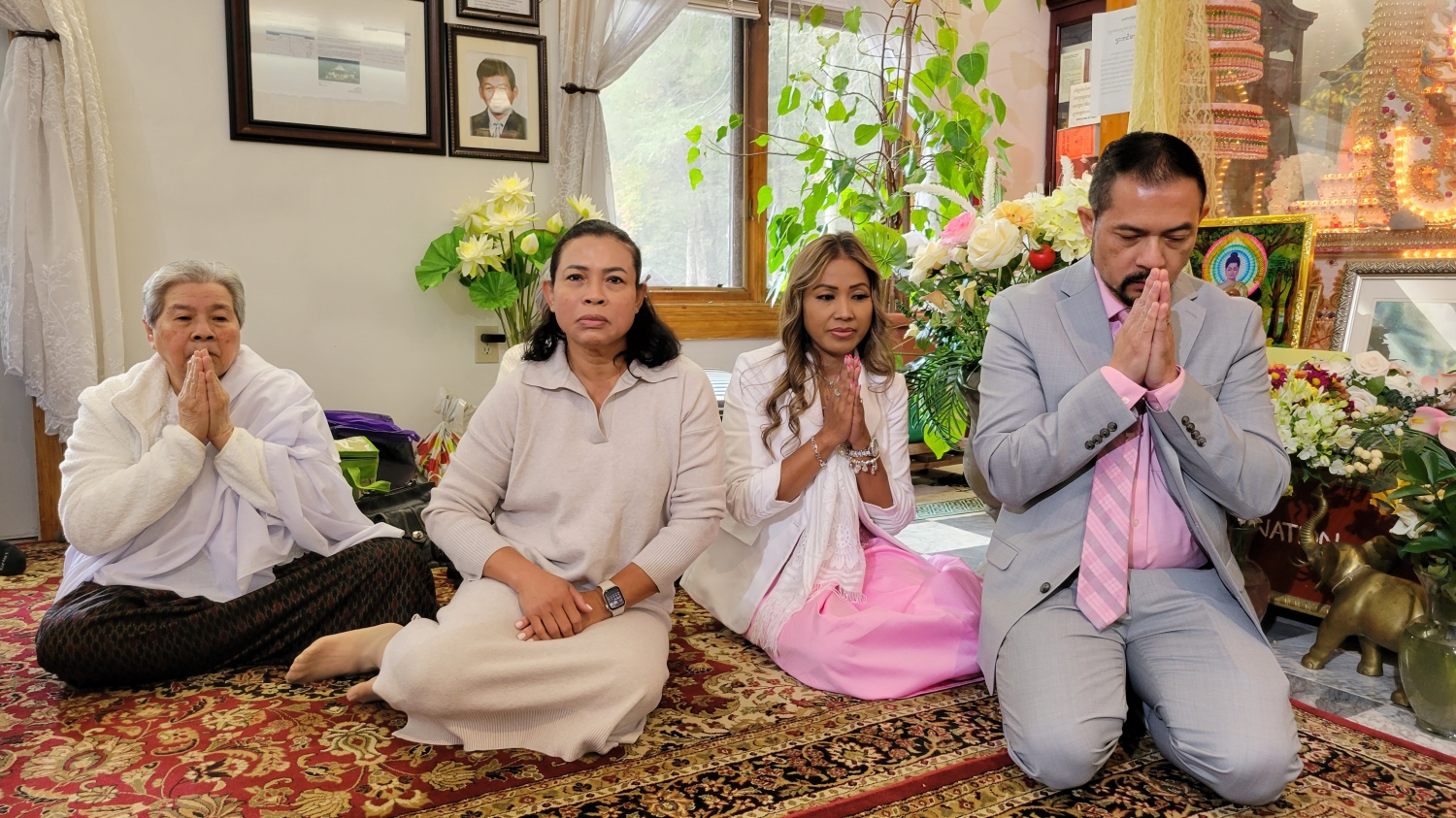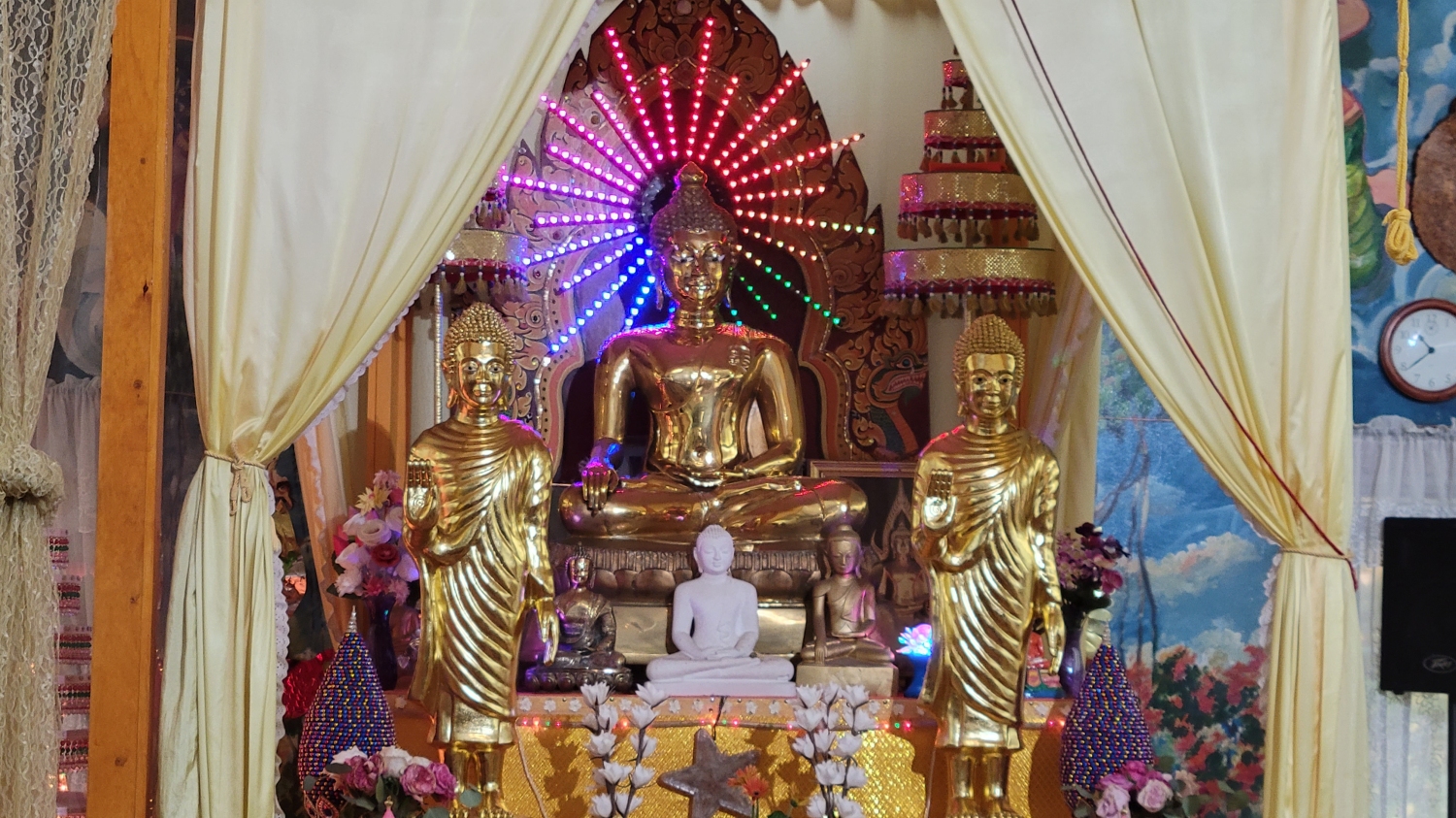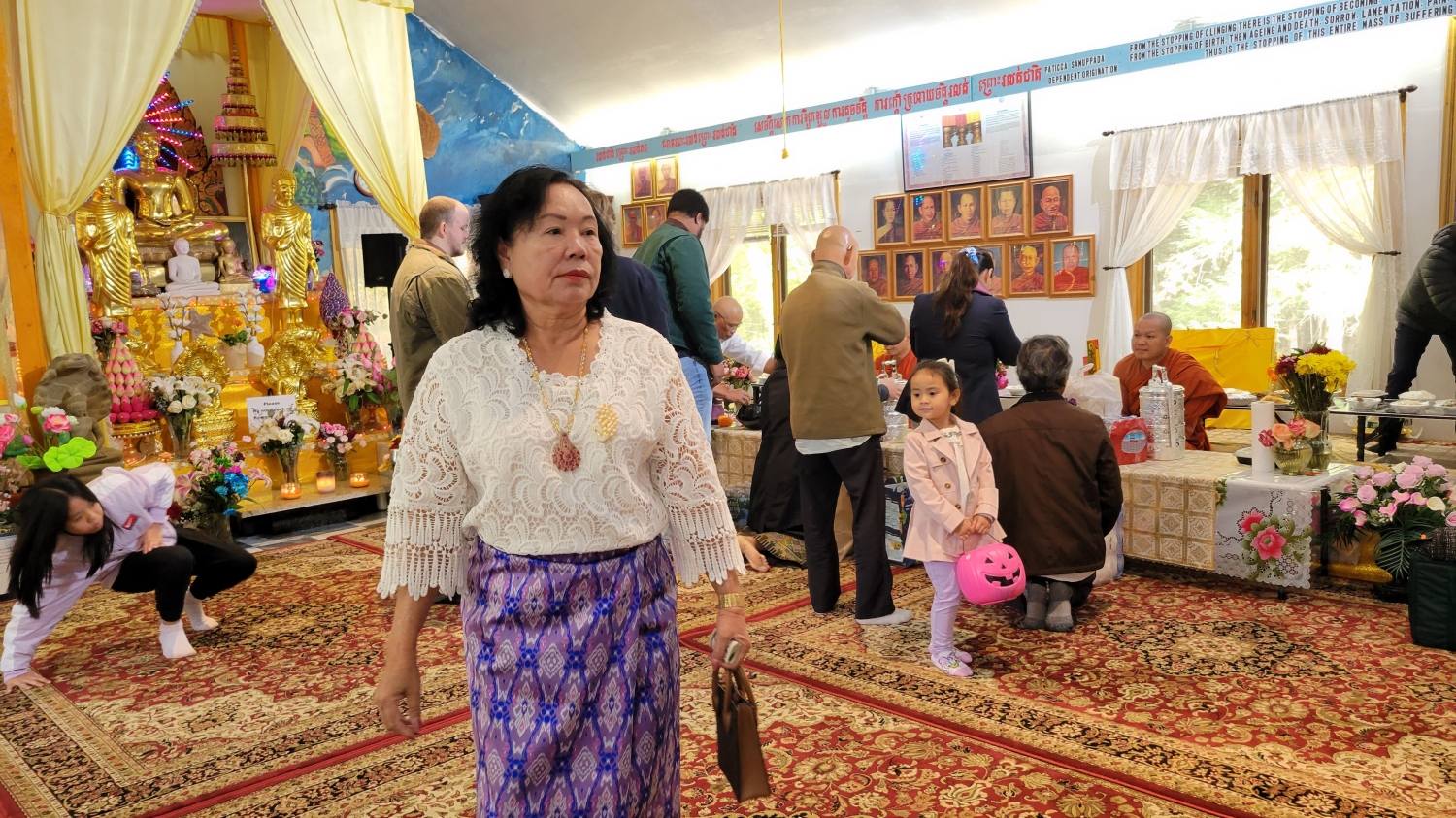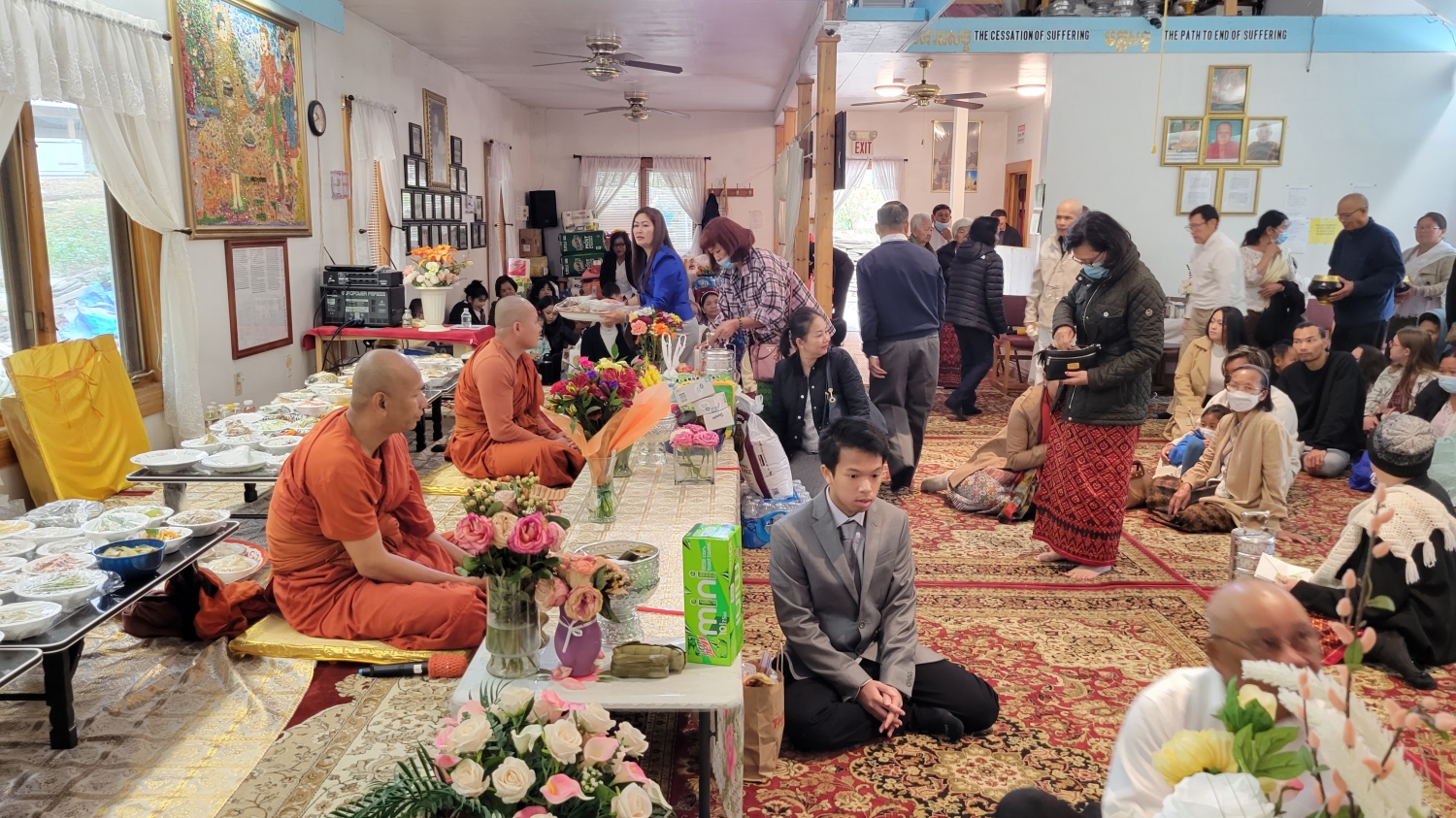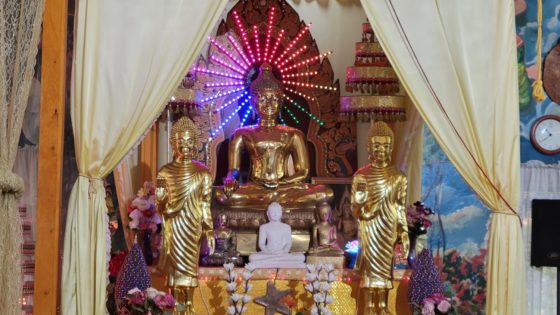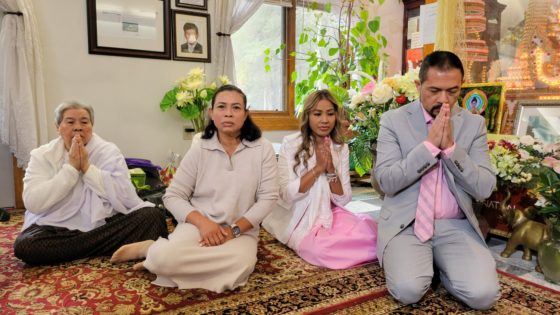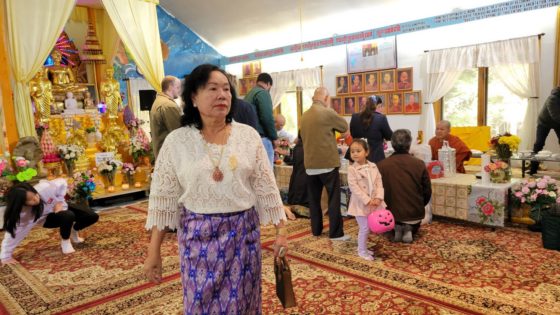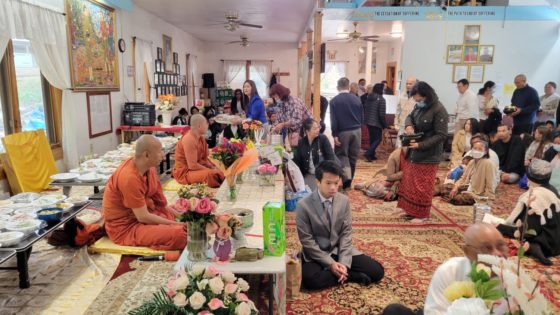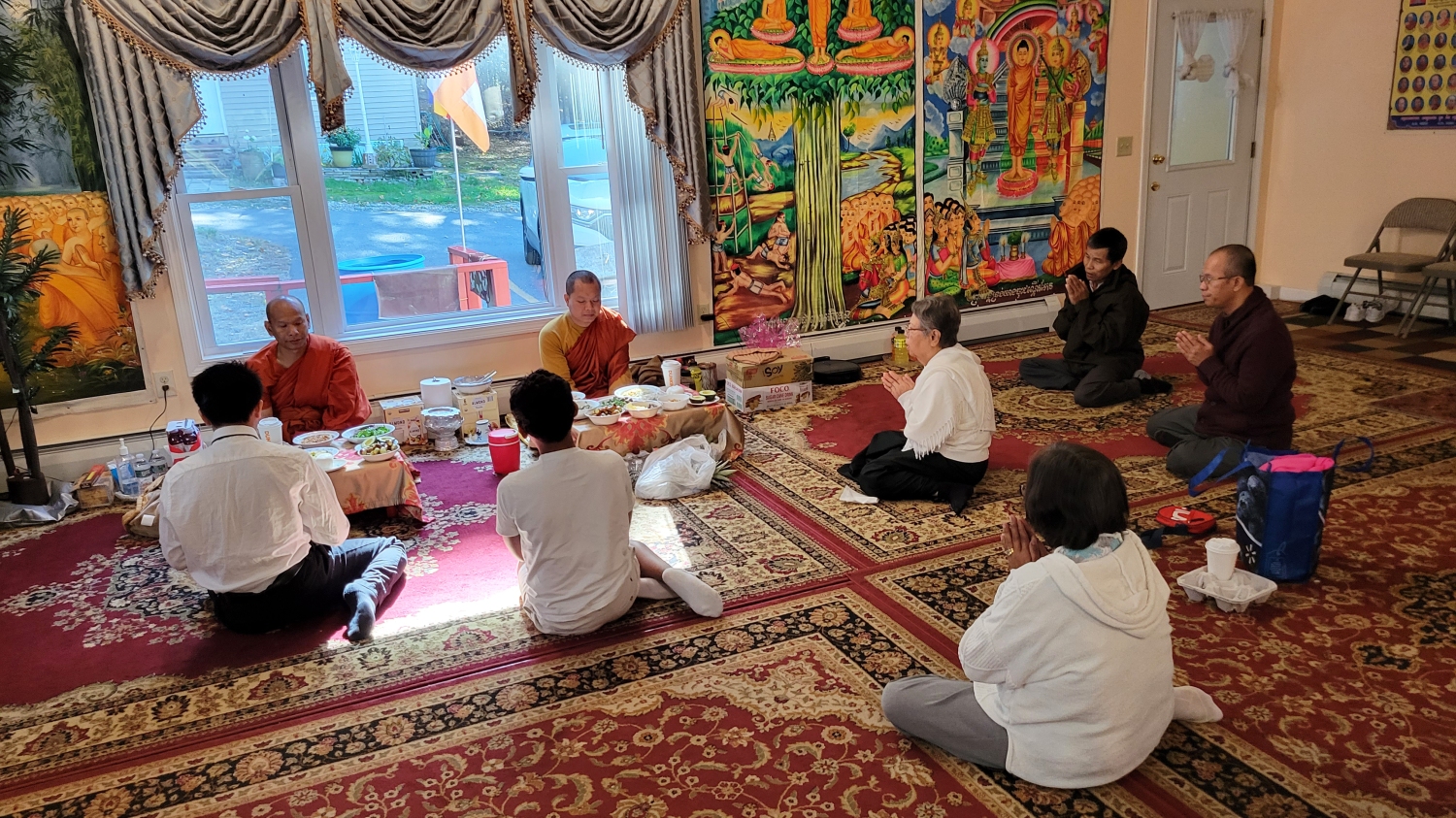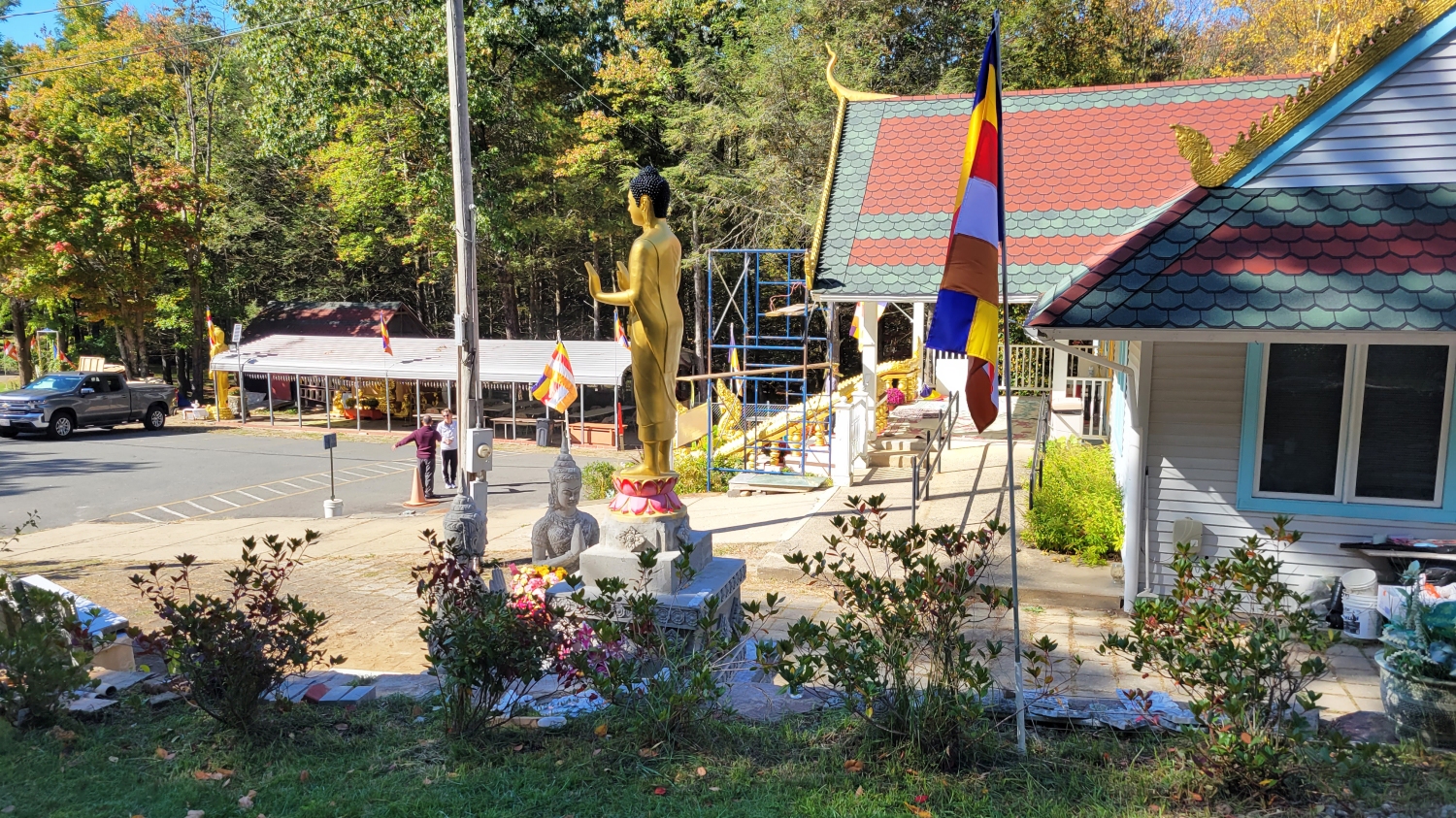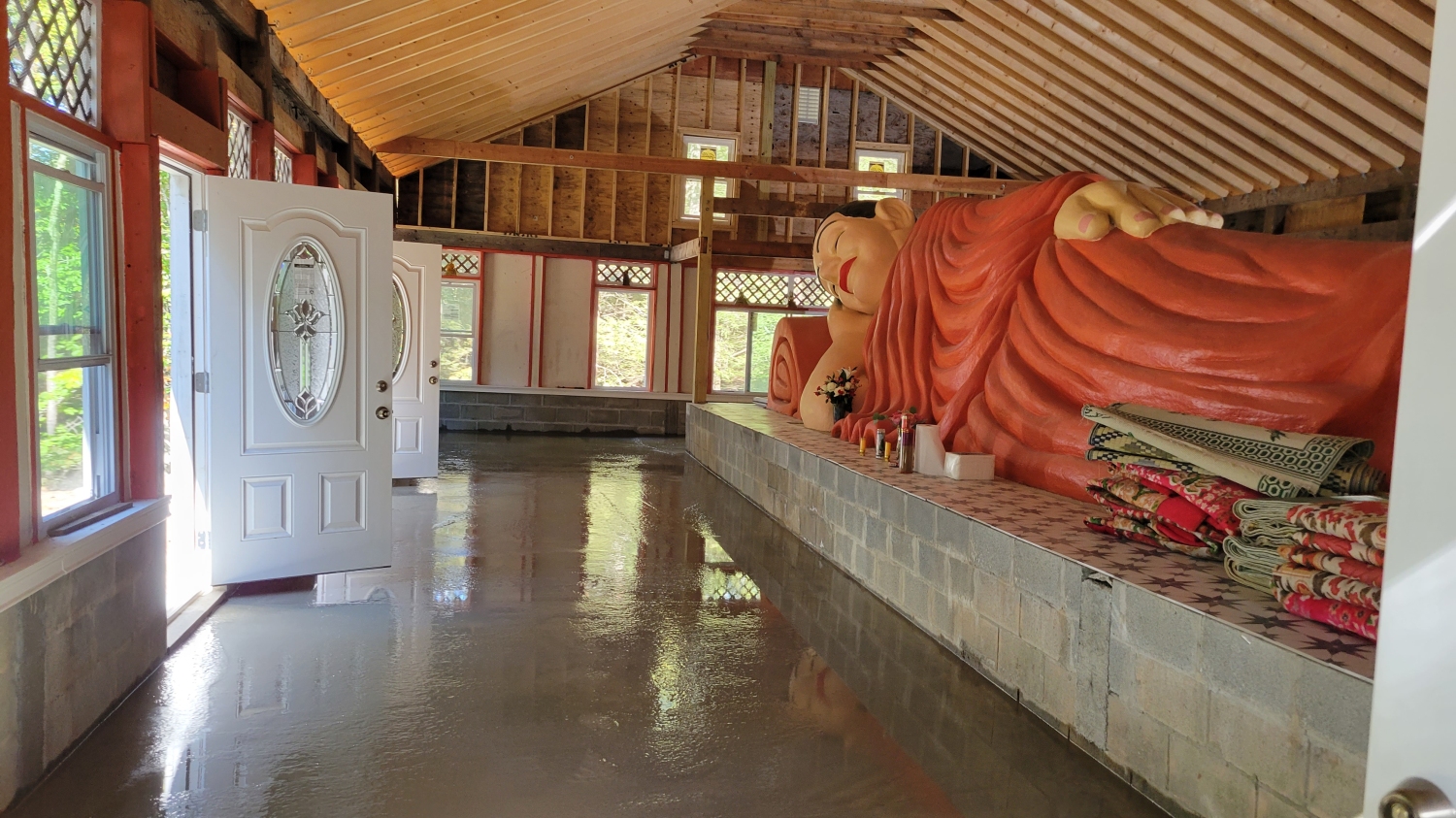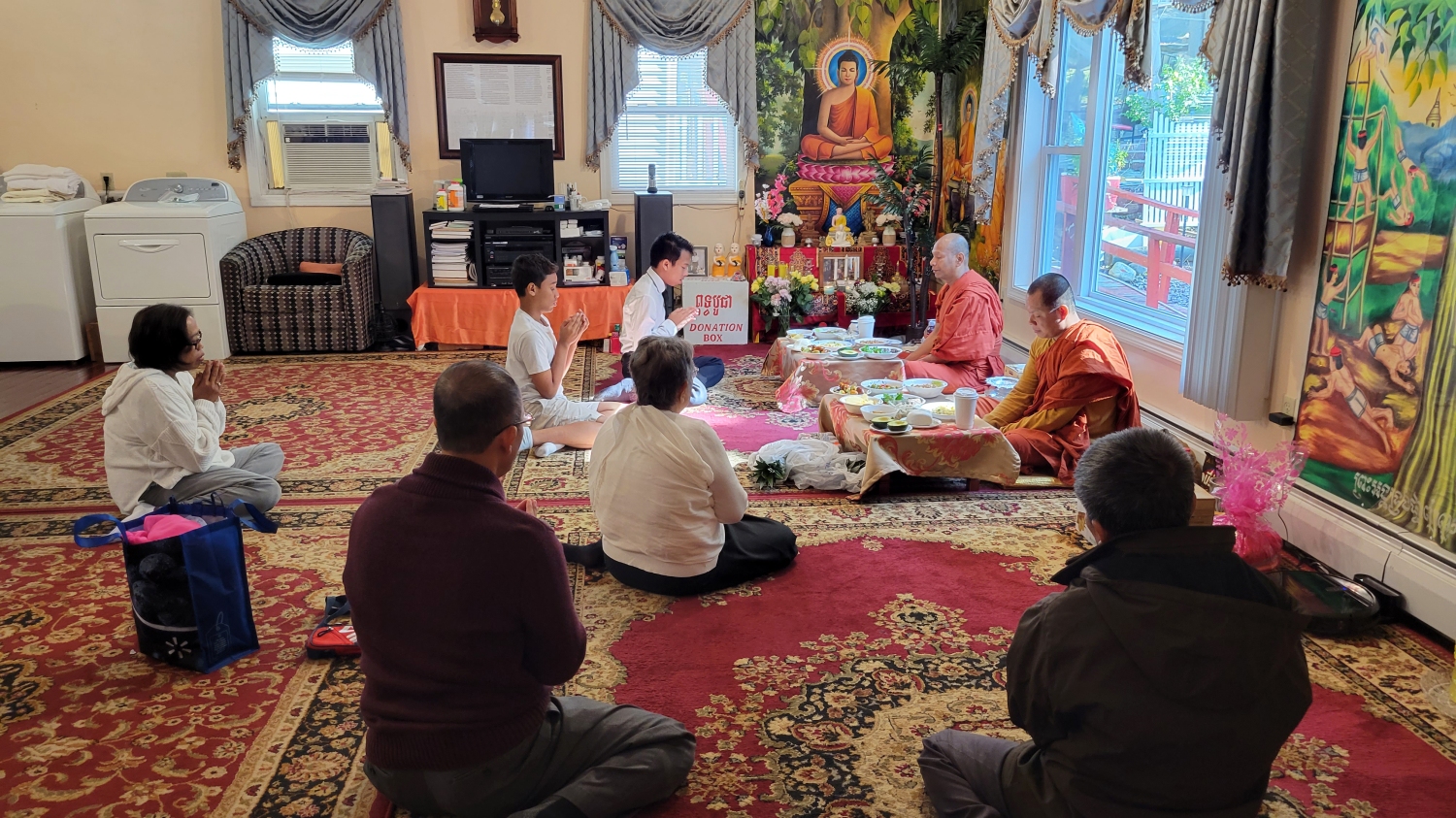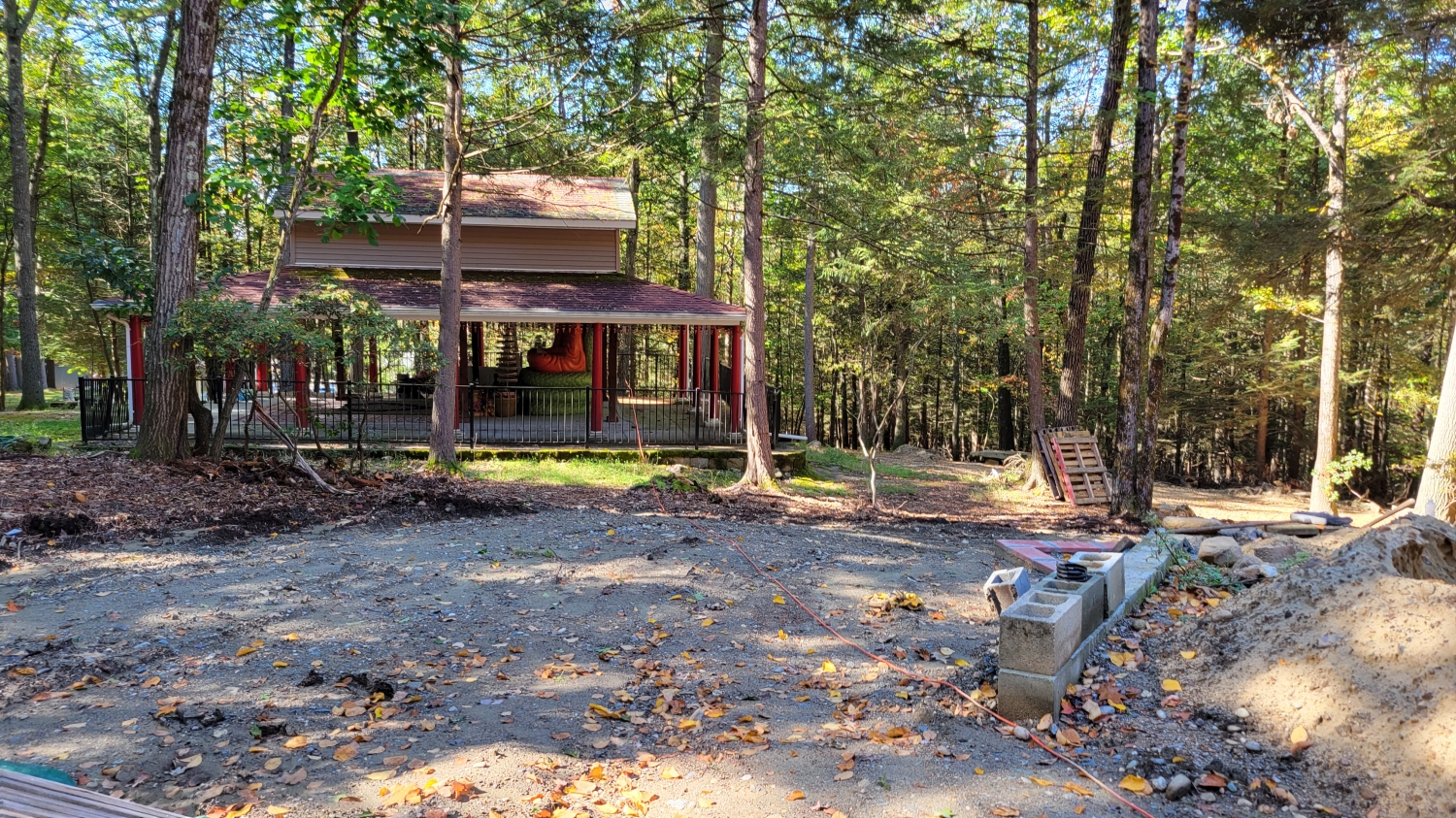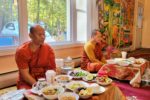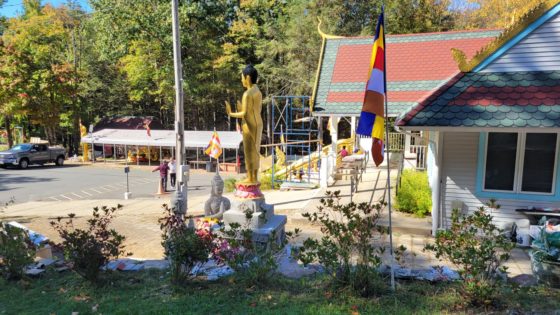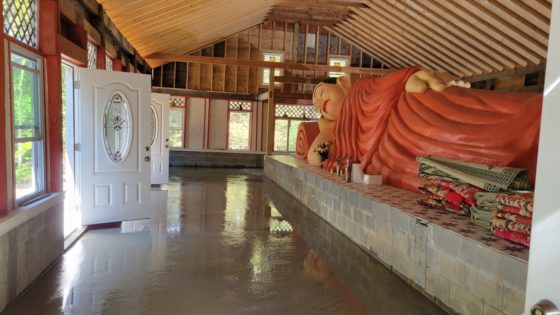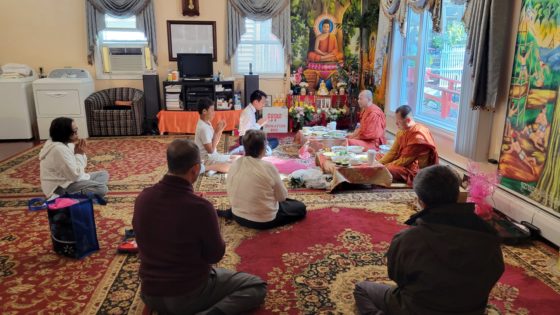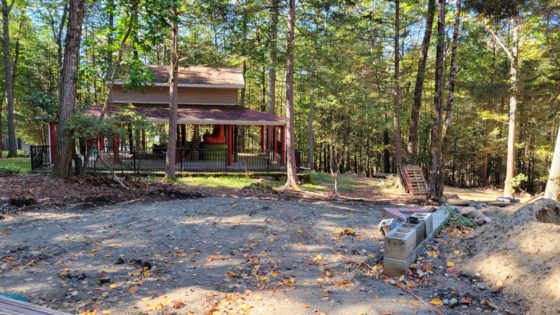យោគាវចរក្នុងសម្នាក់ព្រះធម្មាចារ្យ ពុទ្ធសត្ថា និងព្រះធម្មាចារ្យ ឥន្ទជោតោ ប្រចាំឆ្នាំ២៥៦៧/២០២៣
Meditation students at Wat Kiryvongsa Bopharam for 2023
វគ្គសិក្សាសមាធិកម្មដ្ឋានក្នុងរយៈពេលចំនួន ១០ថ្ងៃ បានប្រព្រឹត្ដឡើងនៅវត្ដគិរីវង្សាបុប្ផារាម អាស្រមសមាធិសន្ដិភាព ក្រោមអធិបតីភាពព្រះធម្មាចារ្យ ពុទ្ធសត្ថា គ្រូសមាធិកម្មដ្ឋាន និងព្រះធម្មាចារ្យ ឥន្ទជោតោ គ្រូសមាធិកម្មដ្ឋាន និងជាព្រះចៅអធិការ នាថ្ងៃ ៤កើត ដល់ ១៥កើត ពេញបូណ៌មី ថ្ងៃសីល
ខែបឋមាសាឍ ឆ្នាំថោះ បញ្ចស័ក ពុទ្ធសករាជ ២៥៦៧ ត្រូវនឹងថ្ងៃទី២១ ខែមិថុនា ដល់ថ្ងៃទី២ ខែកក្កដា គ្រិស្ដសករាជ ២០២៣
A 10-Day Samādhi Retreat at the Kiryvongsa Bopharam Buddhist Temple, the Peace Meditation Center presided by Bhikkhu Buddhasāttha, Meditation Teacher and Bhikkhu Indajoto, Meditation Teacher & Abbot on the 4th Waxing Moon to 15th Waxing Moon, Holy Day, of Pathamasadh Buddhist Era 2567 equivalent to June 21 – July 2, A.D.2023
Māgha Pūjā at Wat Kiryvongsa Bopharam on Februay 24, 2567/2024
ពិធីបុណ្យមាឃបូជាប្រារព្ធនៅវត្ដគិរីវង្សាបុប្ផារាម អាស្រមសមាធិសន្ដិភាព នាថ្ងៃសៅរ៍ ១៥កើត ពេញបូណ៌មី ថ្ងៃសីល ខែមាឃ ឆ្នាំថោះ បញ្ចស័ក ពុទ្ធសករាជ ២៥៦៧ ត្រូវនឹងថ្ងៃទី២៤ ខែកុម្ភៈ គ្រិស្ដសករាជ ២០២៤
Māgha Pūjā held at Wat Kiryvongsa Bopharam, the Peace Meditation Center on Saturday the 15th Waxing Moon of Māgha, Buddhist Era 2567 equivalent to February 24, A.D.2024
Funeral service of Mrs. Kim Heang Keo on February 23 & 24, 2024
ពិធីបុណ្យឈាបនកិច្ចអ្នកស្រី កែវ គិម ហ៊ាង ជន្មាយុ ៧២ឆ្នាំ
ពិធីបុណ្យឈាបនកិច្ចអ្នកស្រី កែវ គិម ហ៊ាង ជន្មាយុ ៧២ឆ្នាំ ប្រារព្ធនៅវត្ដធម្មិការាម នាថ្ងៃ ១៤កើត ថ្ងៃកោរ និង ១៥កើតពេញបូណ៌មី ថ្ងៃសីល ខែមាឃ ឆ្នាំថោះ បញ្ចស័ក ពុទ្ធសករាជ ២៥៦៧ ត្រូវនឹងថ្ងៃទី២៣ – ២៤ ខែកុម្ភៈ គ្រិស្ដសករាជ ២០២៤
Funeral service of the late Mrs. Kim Heang Keo, age 72, at Wat Thormikaram in Providence, Rhode Island on February 23-24, A.D.2024.
ពិធីបុណ្យឈាបនកិច្ចអ្នកស្រី កែវ គិម ហ៊ាង ប្រារព្ធនៅវត្ដធម្មិការាម ទីក្រុងប្រាវីដិន្ស៍ រដ្ឋរ៉ូដអៃឡិន្ដ នាថ្ងៃ ១៤កើត ថ្ងៃកោរ និង ១៥កើតពេញបូណ៌មី ថ្ងៃសីល ខែមាឃ ឆ្នាំថោះ បញ្ចស័ក ពុទ្ធសករាជ ២៥៦៧ ត្រូវនឹងថ្ងៃទី២៣ – ២៤ ខែកុម្ភៈ គ្រិស្ដសករាជ ២០២៤
Funeral service of Mrs. Kim Heang Keo held at Wat Thormikaram in Providence, Rhode Island on the 14th – 15th Waxing Moon, Holy Day, of Māgha, year of the Rabbit, Buddhist Era 2567 equivalent to February 23-24, A.D.2024
The Kiryvongsa Bopharam Pagoda celebrating New Year on April 13 – 16, 20 – 21, 2024
Funeral service of Mr. Mony Heng on February 18 & 19, 2024
ពិធីបុណ្យឈាបនកិច្ចលោក ហេង មុនី ហៅវណ្ណី ជន្មាយុ ៤៦ឆ្នាំ ប្រារព្ធនៅវត្ដត្រៃរតនារាម ទីក្រុង North Chelmsford, រដ្ឋម៉ាសាឈូសិត្ដស៍ និង ឈាបនដ្ឋាន ម៉ារីម៉ាក ទីក្រុង Merrimack រដ្ឋ New Hampshire
Funeral service of the late Mr. Mony Heng (aka Vanny Heng) at the Trairatanaram Temple in N. Chelmsford, MA and Merrimack, New Hampshire
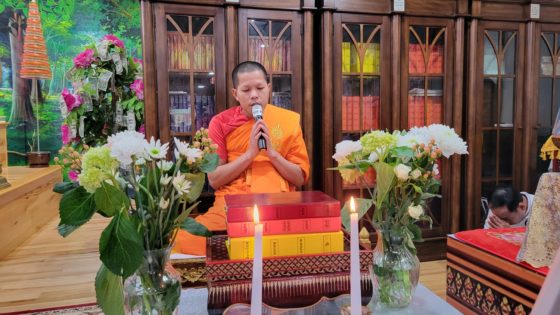
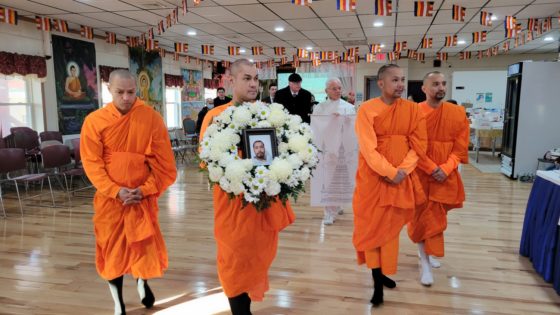
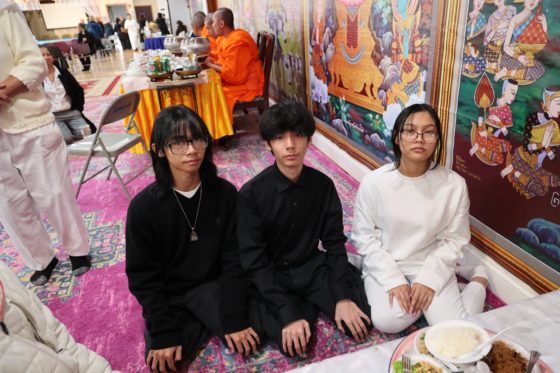
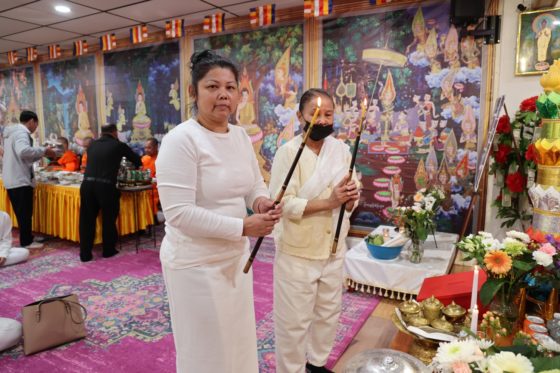
ពិធីបុណ្យឈាបនកិច្ចលោក ហេង មុនី ហៅវណ្ណី ជន្មាយុ ៤៦ឆ្នាំ ប្រារព្ធនៅវត្ដត្រៃរតនារាម ទីក្រុង North Chelmsford, រដ្ឋម៉ាសាឈូសិត្ដស៍ និង ឈាបនដ្ឋាន ម៉ារីម៉ាក ទីក្រុង Merrimack រដ្ឋ New Hampshire សហរដ្ឋអាមេរិក នាថ្ងៃ ៩ – ១០កើត ខែមាឃ ឆ្នាំថោះ បញ្ចស័ក ពុទ្ធសករាជ ២៥៦៧ ត្រូវនឹងថ្ងៃទី១៨ – ១៩ ខែកុម្ភៈ គ្រិស្ដសករាជ ២០២៤ ក្រោមព្រះអធិបតីភាពព្រះភិក្ខុ សង្ឃបណ្ឌិតោ ជាព្រះមុនីរតនវង្ស និងព្រះចៅអធិការ វត្ដត្រៃរតនារាម។
Funeral service of the late Mr. Mony Heng (aka Vanny Heng), age 46, at the Trairatanaram Temple in North Chelmsford, MA and Merrimack, New Hampshire on the 9th – 10th Waxing Moon of Māgha, Buddhist Era 2567 equivalent to February 18 – 19, A.D.2024.
Presided by Bhikkhu Sanghapandito, Muniratanavangsa and Abbot of Wat Trairatanaram.
A 10-Day Meditation Retreats in Leverett, Massachusetts
រៀនធ្វើសមាធិ និងវិបស្សនាកម្មដ្ឋាន និងអប់រំចិត្ត
INTERESTED IN LEARNING MEDITATION
A 10-Day Meditation (Samadhi) & Vipassana (Insight Meditation) Retreats
When: July 10 – 21, Buddhist Era 2568 A.D.2024
Location: The Kiryvongsa Bopharam Pagoda, the Peace Meditation Center, Leverett, Massachusetts United States
Vipassana and meditation teachers are: Bhikkhu Buddhasaddha, Bhikkhu Indajoto.
The meditation technique is taught strictly in accordance to the Buddhist Tipitaka (The Buddhist Canon).
To learn more about previous year’s program. Click on hyperlink.
Modes of Transportation
By Air: You are suggested to stop at Bradley International Airport in Connecticut. It is a 1-hour drive to the temple.
By Land: You are suggested to stop in Amherst bus station if you arrive by bus from out of state or Canada. It is about a 25-minute drive to the temple.
Please DOWNLOAD PROGRAM and REGISTRATION FORM. Complete the registration form and send it back as soon as possible.
Download Khmer PDF: Registration
Download English PDF: RegistrationEN
Contact Info:
The Kiryvongsa Bopharam Pagoda, the Peace Meditation Center
100A Cave Hill Road, Leverett, MA 01054 – 9728 U.S.A.
Tel.: 413.367.0280; E-mail: vipassanadhura@gmail.com
Advance ENROLLMENT opens
Obituary: The late Mr. Mony Heng, Age 46
Cremation Day-The late Mr. Sophane “Rasmey” Kim, Age 59
ថ្ងៃបូជា – ពិធីបុណ្យឈាបនកិច្ចលោក គិម សុផាន់ ហៅរស្មី ជន្មាយុជិត ៥៩ឆ្នាំ ក្រោមព្រះអធិបតីភាព ព្រះភិក្ខុ សង្ឃបណ្ឌិតោ ជាព្រះមុនីរតនវង្ស និងព្រះចៅអធិការវត្ដវត្ដត្រៃរតនារាម ប្រារព្ធនៅវត្ដត្រៃរតនារាម ស្ថិតនៅទីក្រុង North Chelmsford, MA និងឈាបនដ្ឋាន Merrimack ទីក្រុង Merrimack រដ្ឋ New Hampshire នាថ្ងៃសៅរ៍ ៩រោច ខែបុស្ស ឆ្នាំថោះ បញ្ចស័ក ពុទ្ធសករាជ ២៥៦៧ ត្រូវនឹងថ្ងៃទី៣ ខែកុម្ភៈ គ្រិស្ដសករាជ ២០២៤
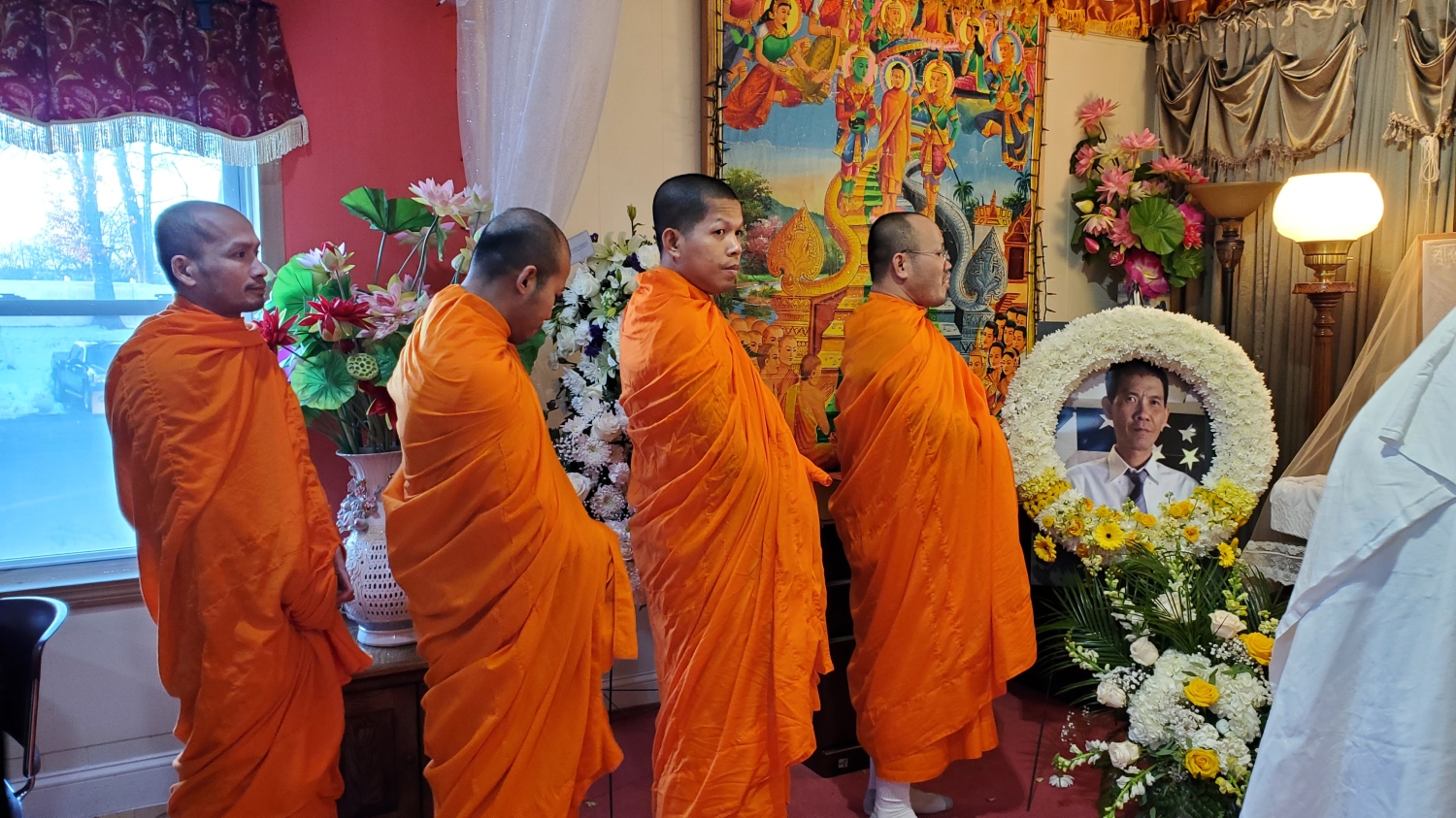
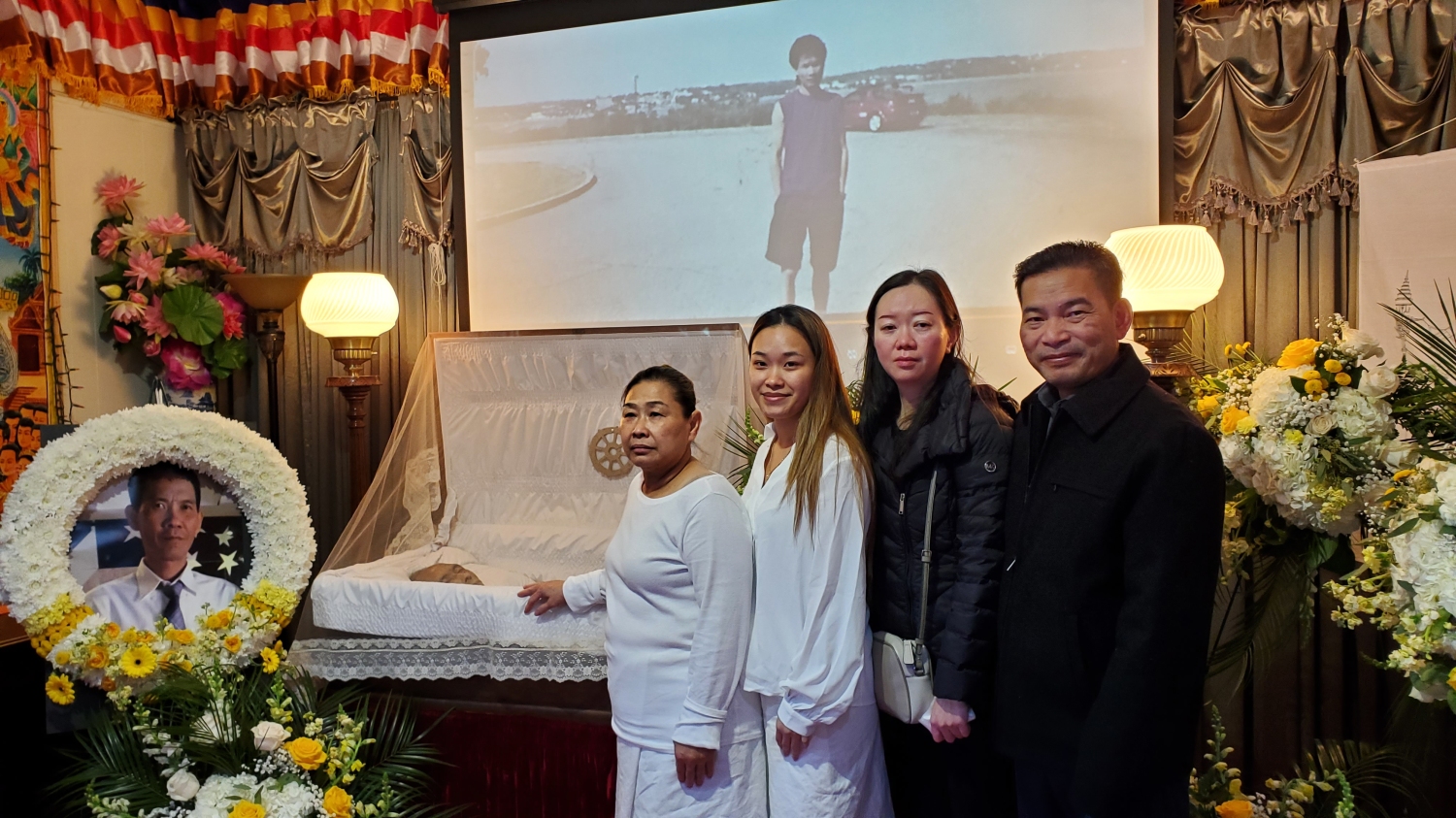
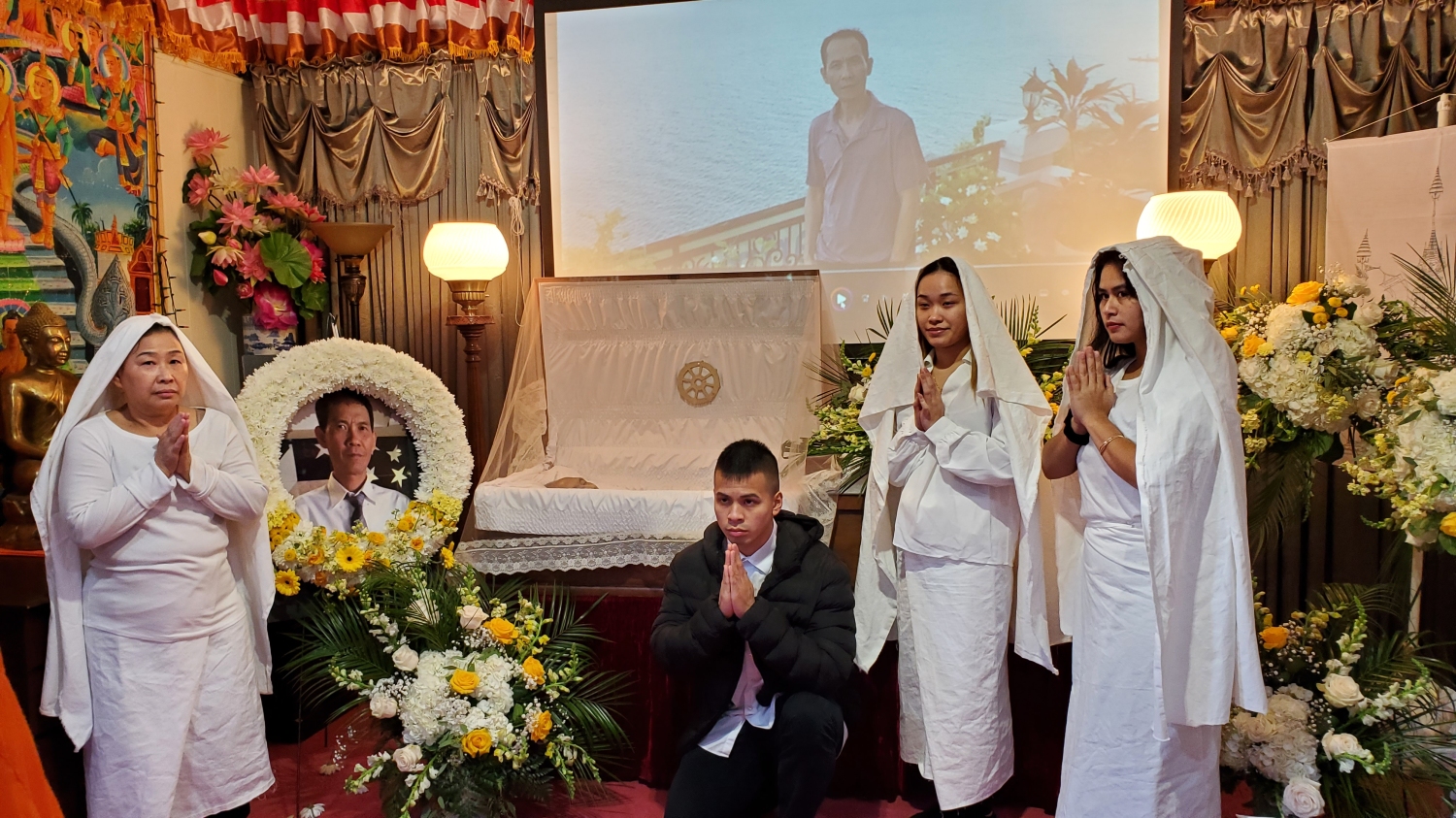
The late Mr. Sophane “Rasmey” Kim Funeral Service, presided by Bhikkhu Sanghapandito, Muniratanavangsa, Abbot of Wat Trairatanaram, held at Wat Trairatanaram in North Chelmsford, Massachusetts and at the Merrimack Cremation Service, Merrimack, New Hampshire on Saturday the 9th Waning Moon of Phussā, Year of the Rabbit, Buddhist Era 2567 equivalent to February 3, Anno Domini 2024.
លោក គិម រស្មី កើតនៅភូមិឈើទាល ឃុំកំពង់ទូក ស្រុករួមខេត្ដ ខេត្ដព្រះត្រពាំង កម្ពុជាក្រោម។
The late Mr. Rasmey Kim was born in Cheu Teal village, Kampong Touk commune, Preah Trapaing district, Preah Trapaing province, Kampuchea Krom.
Funeral Service of the late Mr. Sophane “Rasmey” Kim, Age 59
ពិធីបុណ្យឈាបនកិច្ចលោក គិម សុផាន់ ហៅរស្មី ជន្មាយុជិត ៥៩ឆ្នាំ ប្រារព្ធនៅមន្ទីរតម្កល់សព Dolan និង វត្ដត្រៃរតនារាម ស្ថិតនៅទីក្រុង North Chelmsford, MA នាថ្ងៃសុក្រ ៨រោច ថ្ងៃសីល ខែបុស្ស ឆ្នាំថោះ បញ្ចស័ក ពុទ្ធសករាជ ២៥៦៧ ត្រូវនឹងថ្ងៃទី២ ខែកុម្ភៈ គ្រិស្ដសករាជ ២០២៤
The late Mr. Sophane “Rasmey” Kim Funeral Service, approximately age 59, held at the Dolan Funeral Home and Wat Trairatanaram in North Chelmsford, Massachusetts on Friday the 8th Waning Moon, Day of Abstinence, of Phussā, Year of the Rabbit, Buddhist Era 2567 equivalent to February 2, Anno Domini 2024.
លោក គិម រស្មី កើតនៅភូមិឈើទាល ឃុំកំពង់ទូក ស្រុករួមខេត្ដ ខេត្ដព្រះត្រពាំង កម្ពុជាក្រោម។
The late Mr. Rasmey Kim was born in Cheu Teal village, Kampong Touk commune, Preah Trapaing district, Preah Trapaing province, Kampuchea Krom. (more…)
Obituary: The late Mr. Sophane “Rasmey” Kim, Age 59
The Late Maha Thera Ketodhammo
ថ្ងៃសៅរ៍ ១០រោច ខែមិគសិរ ឆ្នាំថោះ បញ្ចស័ក ព.ស.២៥៦៧ ត្រូវនឹងថ្ងៃទី៦ ខែមករា គ.ស.២០២៤
Saturday the 10th Waning Moon of Māgasira B.E.2567 equivalent to January 6, A.D.2024 Year of the Rabbit
ព្រះពុទ្ធសាសនា
ព្រះធម្មវិបស្សនា កេតុធម្មោ សំ ប៊ុនធឿន អ្នកប្រាជ្ញផ្នែកវិបស្សនាធុរៈ និងគន្ធៈធុរៈ ក្នុងព្រះពុទ្ធសាសនា នៃព្រះរាជាណាចក្រកម្ពុជា។
នៅខាងក្រោមនេះជាចំណងជេីងសៀវភៅដែលព្រះអង្គបានរៀបរៀងចងក្រង និងនិពន្ធ៖
១. សៀវភៅ សមថ និងវិបស្សនាកម្មដ្ឋាន
២. សៀវភៅ សីលកថាសង្ខេប
៣. សៀវភៅ គោលធម៌ថ្នាក់បឋម
៤. សៀវភៅ គោលធម៌ថ្នាក់មធ្យម
៥. សៀវភៅ គោលធម៌ថ្នាក់ឧត្តម
៦. សៀវភៅ គិរីមានន្ទសូត្រ
៧. សៀវភៅ បដិហារិយុបោសថ
៨. សៀវភៅ និយមសីល
៩. សៀវភៅ វិន័យសីល១០
១០. សៀវភៅ វិក្រឹត្យការគរុកោសល្យ
១១. សៀវភៅ ធុតង្គ និងបរិវាស
១២. សៀវភៅ មនុស្សចង់បានអ្វី
១៣. សៀវភៅ បឋមវិបស្សនាពិស្តារ
១៤. សៀវភៅ មធ្យមវិបស្សនាពិស្តារ
១៥. សៀវភៅ ឧត្តមវិបស្សនា ឆ្នាំទី១ ឆ្នាំទី២ (ថ្នាក់ឧត្តមវិបស្សនា ព្រះអង្គមិនទាន់ចងក្រងចប់នោះទេ ព្រោះជាអកុសលត្រូវខ្មាន់កាំភ្លើងធ្វើឃាត ព្រះអង្គ ទទួលអនិច្ចធម្មនៅថ្ងៃទី០៨ ខែកុម្ភៈ គ្រិស្ដសករាជ ២០០៣) ។
Dhamma Talk on Vedana by the late His Holiness Dr. Maha Ghosananda
ធម្មទេសនារបស់សម្តេចព្រះសង្ឃរាជ សម្ដេចបណ្ឌិតព្រះមហាឃោសានន្ទ ស្ដីពី វេទនាធម៌
ថ្ងៃចន្ទ ៥រោច ខែមិគសិរ ឆ្នាំថោះ បញ្ចស័ក ព.ស.២៥៦៧ ត្រូវនឹងថ្ងៃទី១ ខែមករា គ.ស.២០២៤
Monday the 5th Waning Moon of Māgasira B.E.2567 equivalent to January 1, A.D.2024 Year of the Rabbit
ប្រភព៖ ឆេង រដ្ឋា១ Chheng Ratha1
Funeral Service of the late Mrs. Samrang Meas
ពិធីបុណ្យឈាបនកិច្ចអ្នកស្រី មាស សំរ៉ង ជន្មាយុ ៨៦ឆ្នាំ នឹងប្រារព្ធនៅថ្ងៃសៅរ៍ ៣រោច ខែមិគសិរ ឆ្នាំថោះ បញ្ចស័ក ព.ស.២៥៦៧ ត្រូវនឹងថ្ងៃទី៣០ ខែធ្នូ គ.ស.២០២៣ នាឈាបនដ្ឋាន Carpenter-Jenks Funeral Home & Crematory
Funeral Service of the late Mrs. Samrang Meas, age 86, on Saturday the 3rd Waning Moon of Māgasira, Buddhist Era 2567 equivalent to December 30, A.D.2023 at the Carpenter-Jenks Funeral Home & Crematory, 659 E Greenwich Ave, West Warwick, RI 02893
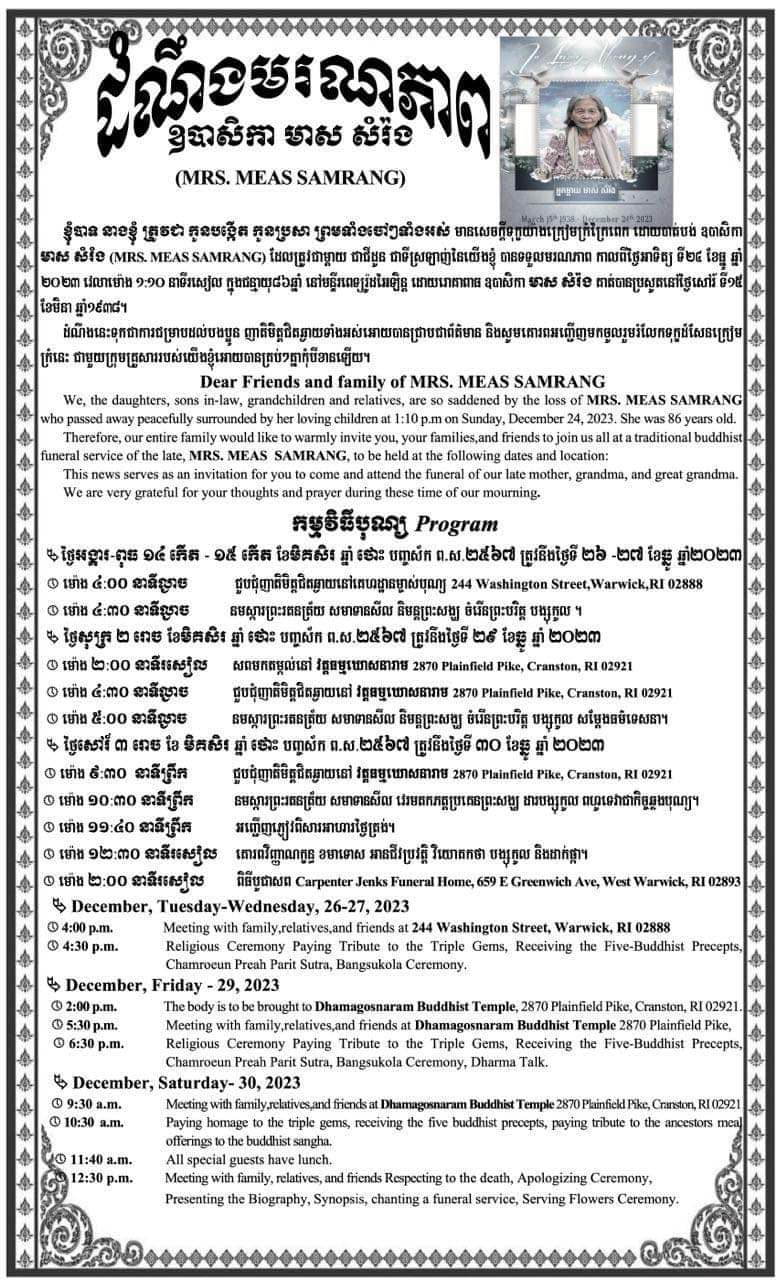
Māgha Pūjā at Wat Kiryvongsa Bopharam on FEB 24, 2567/2024
វត្ដគិរីវង្សាបុប្ផារាម អាស្រមសមាធិសន្ដិភាព នឹងប្រារព្ធពិធីបុណ្យមាឃបូជា នៅថ្ងៃសៅរ៍ ១៥កើត ពេញបូណ៌មី ថ្ងៃសីល ខែមាឃ ឆ្នាំថោះ បញ្ចស័ក ព.ស.២៥៦៧ ត្រូវនឹងថ្ងៃទី២៤ ខែកុម្ភៈ គ.ស.២០២៤
The Kiryvongsa Bopharam Pagoda, the Peace Meditation Center to observe the Māgha Pūjā on Sunday the 15th Waxing Moon of Māgha, Day of Abstinence, Buddhist Era 2567 equivalent to February 24, A.D.2024.
Venue: The Kiryvongsa Bopharam Pagoda, the Peace Meditation Center
100A Cave Hill Road, Leverett, MA 01054 – 9728
Tel.: 413.367.0280, 978.408.7030, 978.437.0632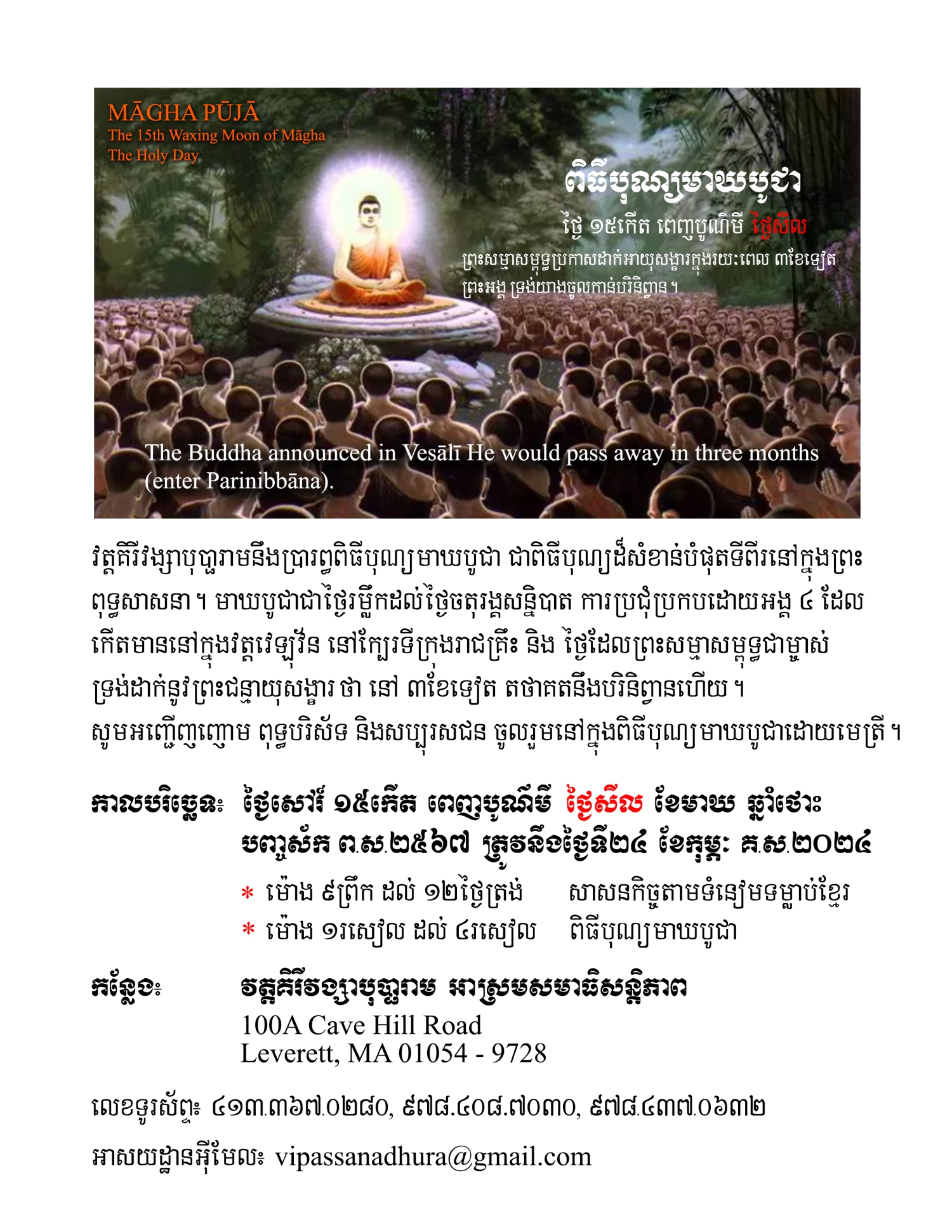
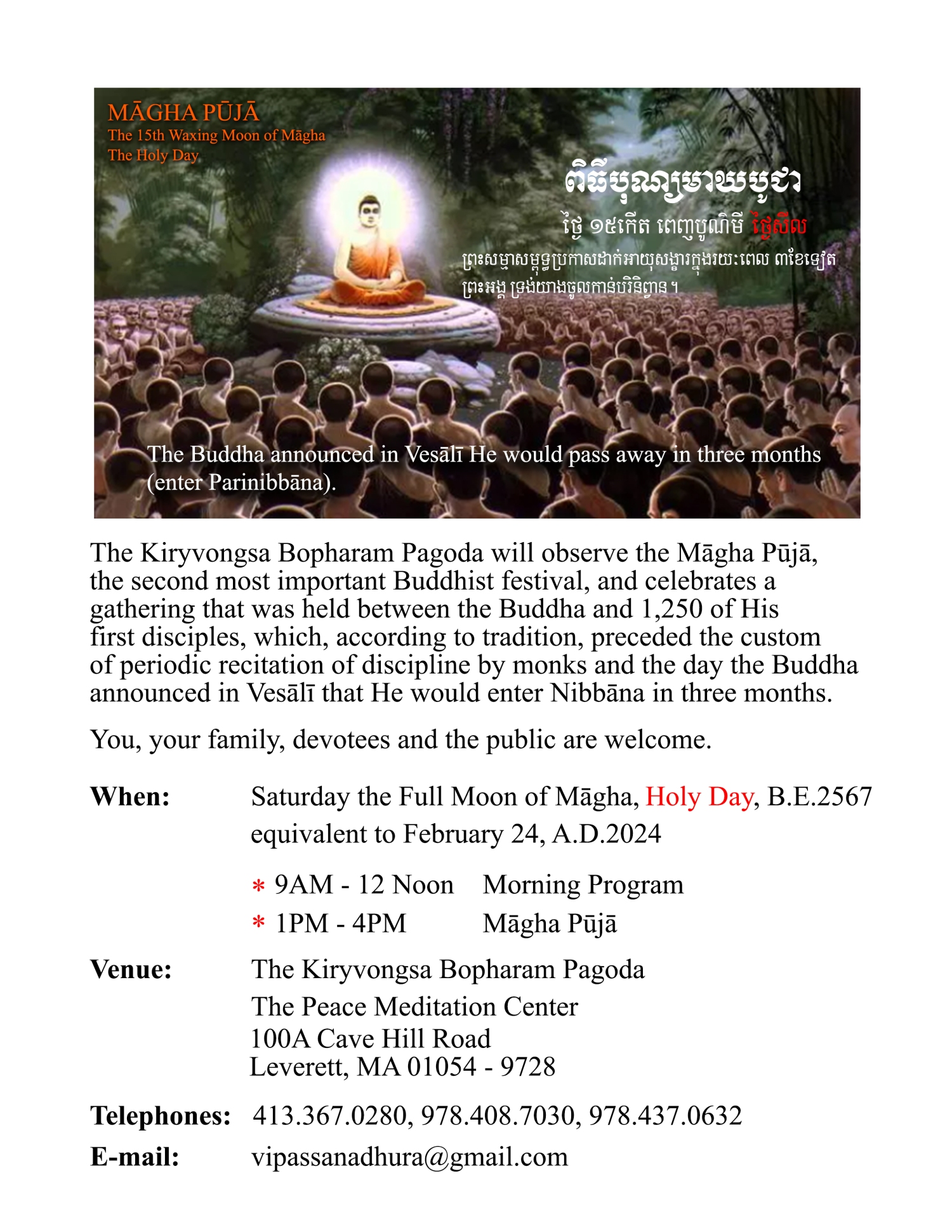
Background on មាឃបូជា Māgha Pūjā
Māgha Pūjā is the second most important Buddhist festival, celebrated on the full moon day of the third lunar month in Cambodia, Laos, Thailand, Sri Lanka and on the full moon day of Tabaung in Myanmar. It celebrates a gathering that was held between the Buddha and 1,250 of his first disciples, which, according to tradition, preceded the custom of periodic recitation of discipline by monks. On the day, Buddhists celebrate the creation of an ideal and exemplary community, which is why it is sometimes called Saṅgha Day, the Saṅgha referring to the Buddhist community, and for some Buddhist schools this is specifically the monastic community. In Thailand, the Pāli term Māgha-pūraṇamī is also used for the celebration, meaning ‘to honor on the full moon of the third lunar month’. Finally, some authors have also referred to the day as the Buddhist All Saints Day.
Celebration of Māgha Pūjā is a public holiday in many Southeast Asian countries and is an occasion when Buddhists go to the temple to perform merit-making activities, such as alms giving, meditation and listening to teachings. It has been proposed as a more spiritual alternative to the celebration of Valentine’s Day.
Māgha is derived from the name of the third month in the traditional Indian lunar calendar, on which the celebration is held. It is also the name of a star, which during this period is close to the full moon. Māgha Pūjā is held on the full moon day. In a leap year, the celebration will be postponed to the full moon day of the fourth lunar month.
Māgha Pūjā day marks an event occurring at the Veḷuvana grove, near Rājagaha (present Rajgir) in northern India, ten months after the enlightenment of the Buddha. The traditional story goes that a meeting is held in the afternoon, that has four characteristics:
1,250 disciples come to see the Buddha that evening without being summoned; These are mostly pupils from the Buddha’s recently converted disciples, such as the three Kassapa brothers, and the monks Sāriputta and Mogallāna.
All of them are Arahants, enlightened disciples;
All have been ordained by the Buddha himself, and therefore are his direct spiritual descendants;
It is the full-moon day of the third lunar month.
Because of these four factors, Māgha Pūjā is also known as the Fourfold Assembly Day. On this occasion, the Buddha teaches those arahants a summary of Buddhism, called the Ovādapatimokkha. In these, three principles are given:
“The non-doing of evil / the full performance of what is wholesome / the total purification of the mind.”
This is followed by a formulation of Buddhist ideals:
“Patience (and) forbearance are the highest austerity. The awakened ones say nibbāna is the highest. One is certainly not a wanderer if one injures others; one is not an ascetic if one harms another.”
Finally, the last stanza is about the path of religious practice:
“Not abusing, not injuring, and restraint under the rules of discipline, and knowing moderation in eating, and secluded lodgings, and exertion in respect of higher thought, this is the teaching of the awakened ones.”
According to the traditional Pāli commentaries, the Buddha continued to teach this summary for a period of twenty years, after which the custom was replaced by the recitation of the monastic code of discipline by the Saṅgha themselves. On Māgha Pūjā, Buddhists celebrate the creation of an ideal and exemplary community.
Māgha Pūjā is also the day that the Buddha is believed to have announced in Vesālī he would die in three months, after which a miraculous earthquake followed. Moreover, in Sri Lanka, it is considered the day that the Buddha appointed his two main disciples, the monks Sāriputta and Moggallāna. Apart from the religious meaning, Māgha Pūjā also reflects the Southeast Asian agricultural year, as it is celebrated after the harvest.
It is unknown how traditional Buddhist societies celebrated this event in pre-modern times, but in Thailand, the first known instance was during the reign of the Thai king Rama IV (1804–68), who instituted it. He first held it in the palace only. In the evening, 31 monks would recite the Ovādapatimokkha, lit lanterns around the ubosot (ordination hall), and give a sermon about the same Ovādapatimokkha. A recitation text used for this occasion is attributed to Rama IV. Rama IV’s successor Rama V (A.D.1853 – A.D.1910) expanded the practice and organized it as a national celebration in the Temple of the Emerald Buddha. From Thailand, the practice spread to neighboring countries. Already in A.D. 1937, the ceremony was widely held and observed in Thailand.
Māgha Pūjā is a day that laypeople make merit. Monastics and devotees will hold processions, light candles, and make offerings. Māgha Pūjā is celebrated most extensively in Cambodia and Thailand, but it is a national holiday in most Southeast Asian countries, such as Laos, Myanmar and Cambodia.
In Thailand, Māgha Pūjā was instituted by Rama IV. It is currently designated as a national holiday, on which sale of alcohol is strictly prohibited. On the evening of Māgha Pūjā, most temples in Thailand hold a candlelight procession. Furthermore, people will make merit by going to temples and by joining in with activities, such as listening to teachings, giving alms, etc. At times, special events are also held, such as a recital of the entire Buddhist scriptures and ceremonies for avowing oneself as a Buddhist lay person. In A.D.2006, the government of Thailand made an announcement that Māgha Pūjā should be celebrated as a “national day of gratitude.” Māgha Pūja was therefore presented as a day of spiritual love and gratitude instead.
In Sri Lanka and Cambodia, Māgha Pūjā is also observed. In Chinese communities, as well as in Myanmar, a similar festival as Māgha Pūjā is observed. The Burmese people celebrate this on the full moon of the month Tabaung according to their traditional calendar. Fifteen days before this full moon day, a Shwedagon Pagoda Festival is held, on which a ceremony is held for offerings to the 28 Buddhas (from Taṇhaṅkara to Gotama Buddha), followed by a 10-day, continuous recital of Buddhist texts. Burmese devotees make merits and meditate during this period.
Māgha Pūjā has also become a popular event among Western Buddhist converts in the West. Wikipedia
ផ្សាយនៅថ្ងៃចន្ទ ៦កើត ខែមិគសិរ ឆ្នាំថោះ បញ្ចស័ក ព.ស.២៥៦៧ ត្រូវនឹងថ្ងៃទី១៨ ខែធ្នូ គ.ស.២០២៣
Monday the 6th Waxing Moon of Māgasira B.E.2567 equivalent to December 18, A.D.2023 Year of the Rabbit
Free Copy: The 2568 2024 Khmer Calendar
ប្រតិទិនខ្មែរ ឆ្នាំរោច បញ្ចស័ក ព.ស.២៥៦៧ គ.ស.២០២៤ មានប្រគេន និងជូននៅទីនេះដោយឥតគិតថ្លៃ
The Khmer Calendar for Buddhist Era 2568 A.D.2024 Year of the Dragon is free of charge
ថ្ងៃអាទិត្យ ៥កើត ខែមិគសិរ ឆ្នាំថោះ បញ្ចស័ក ព.ស.២៥៦៧ ត្រូវនឹងថ្ងៃទី១៧ ខែធ្នូ គ.ស.២០២៣
Sunday the 5th Waxing Moon of Māgasira B.E.2567 equivalent to December 17, A.D.2023 Year of the Rabbit
Download Free PDF: Khmer Calendar 2567-2568 || ប្រភព៖ ព្រះភិក្ខុ ឥន្ទជោតោ (ខ្ញុំព្រះករុណាខ្ញុំបានបន្ថែមព័ត៌មានបន្ដិចបន្ដួច)

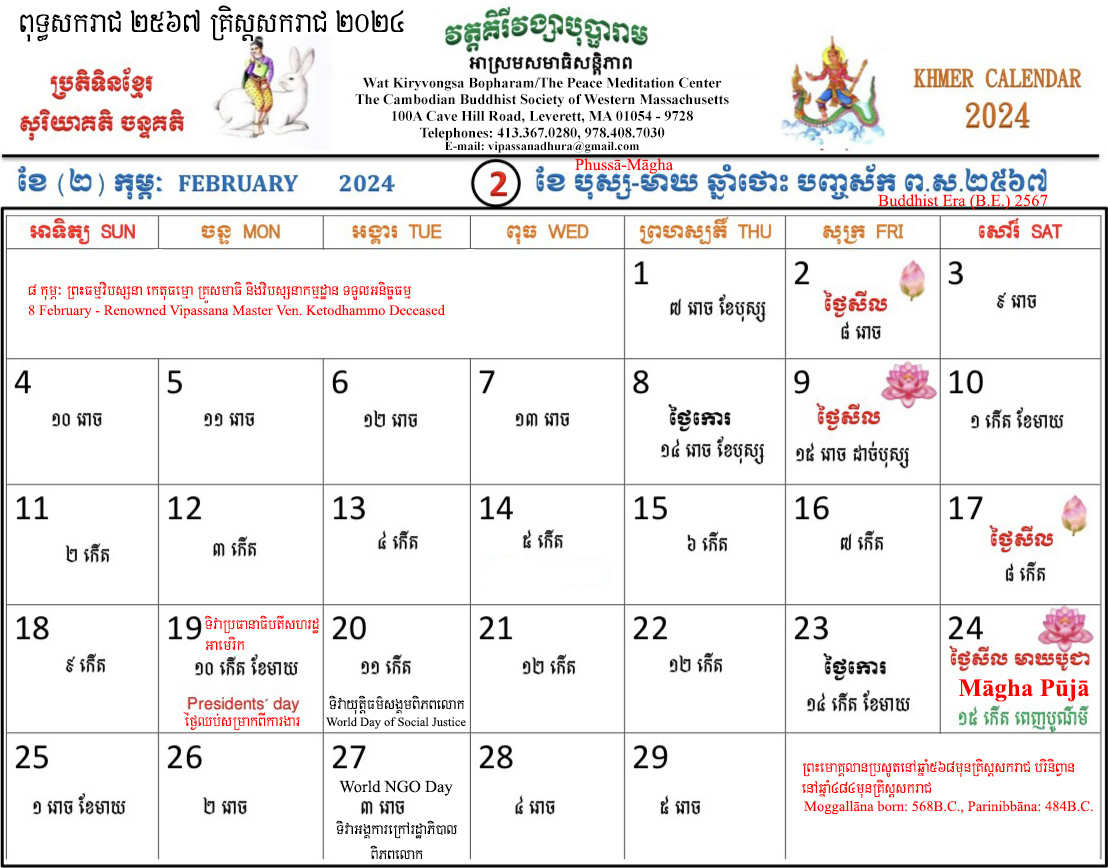
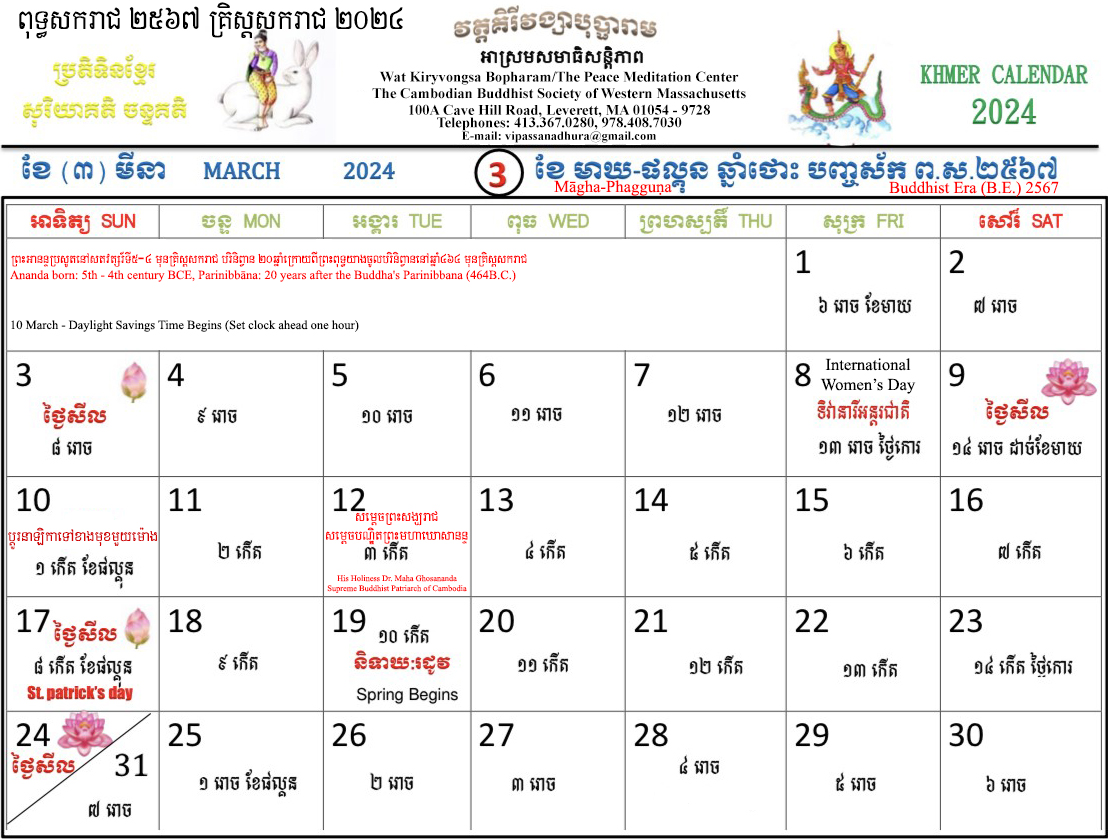
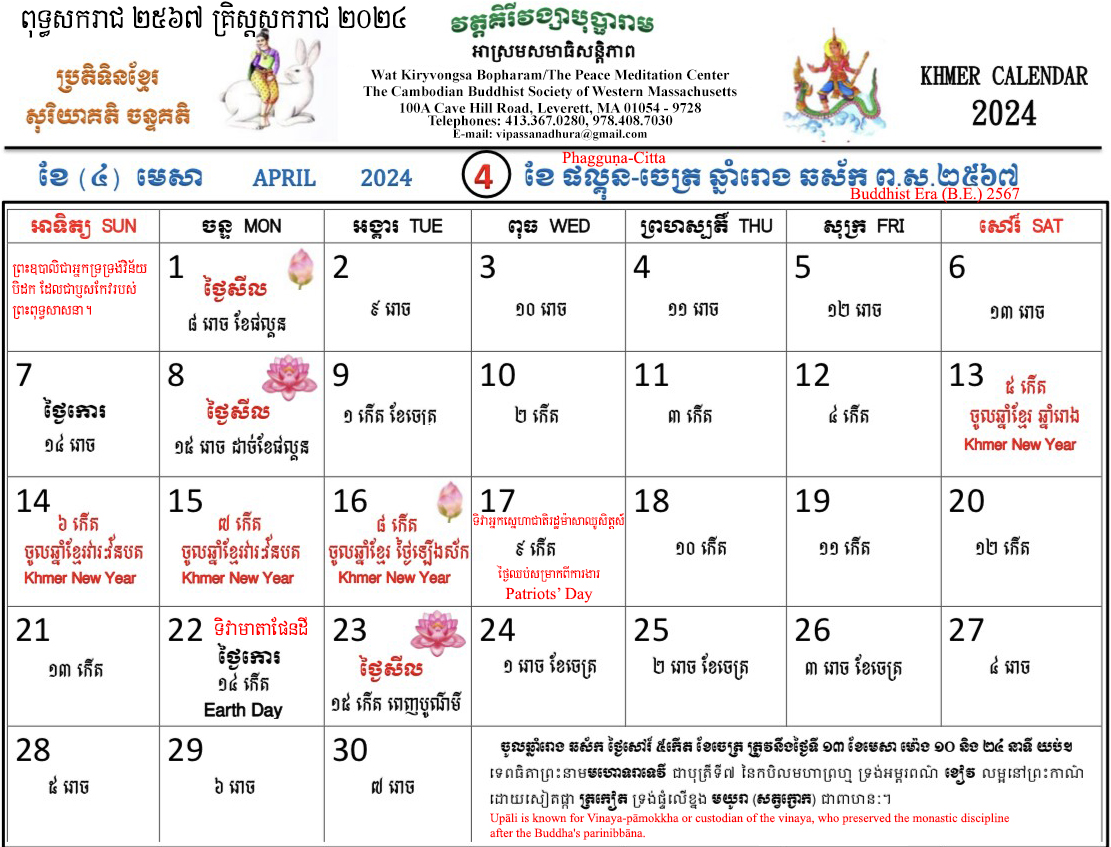
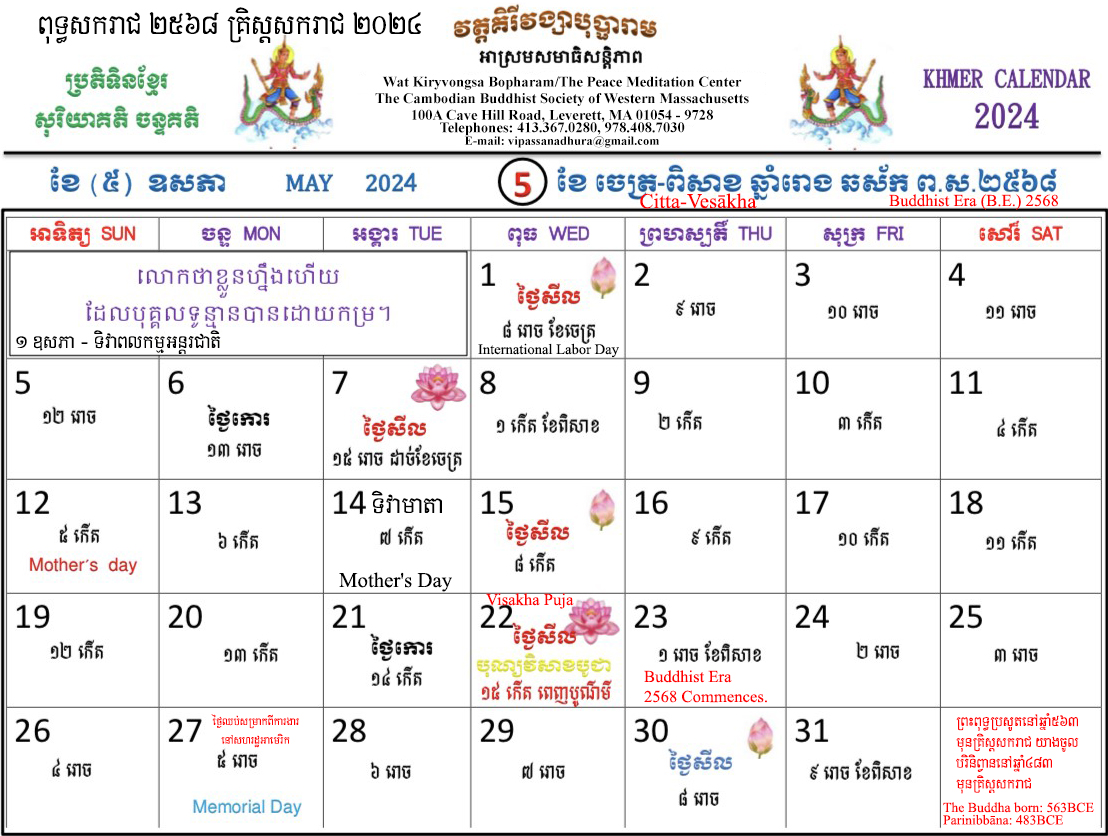
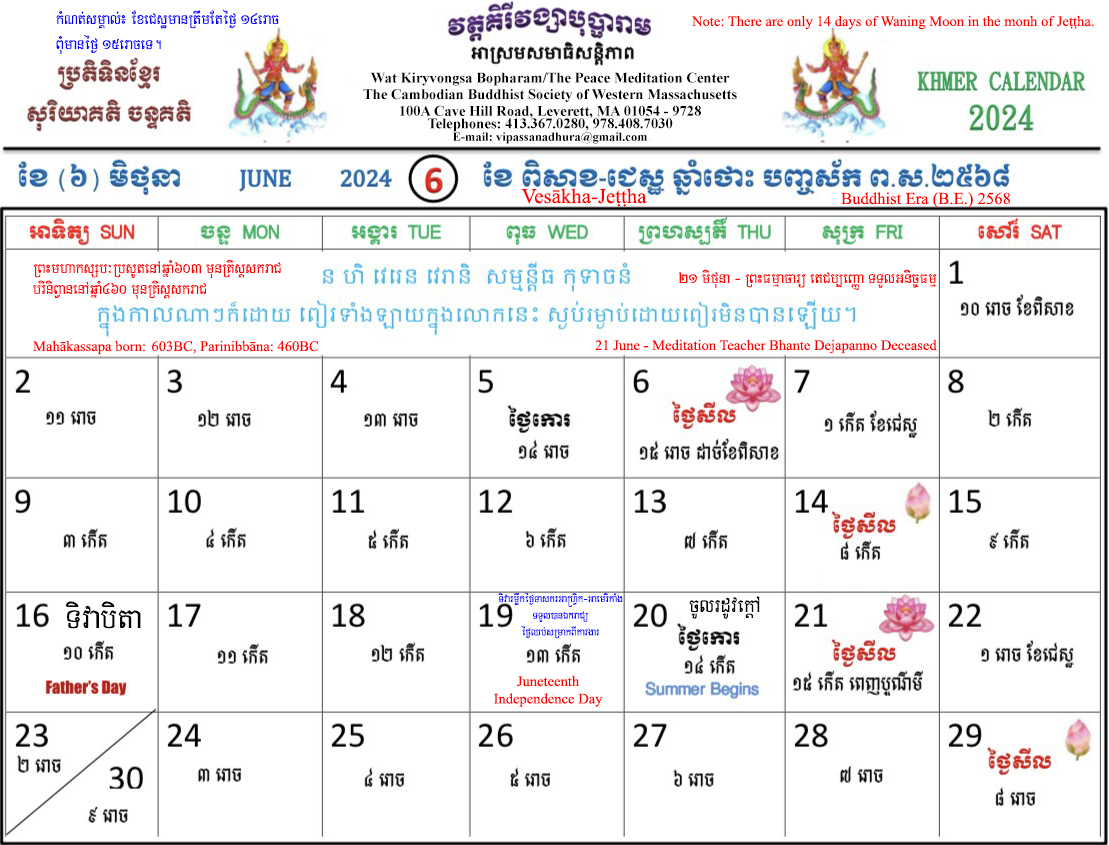
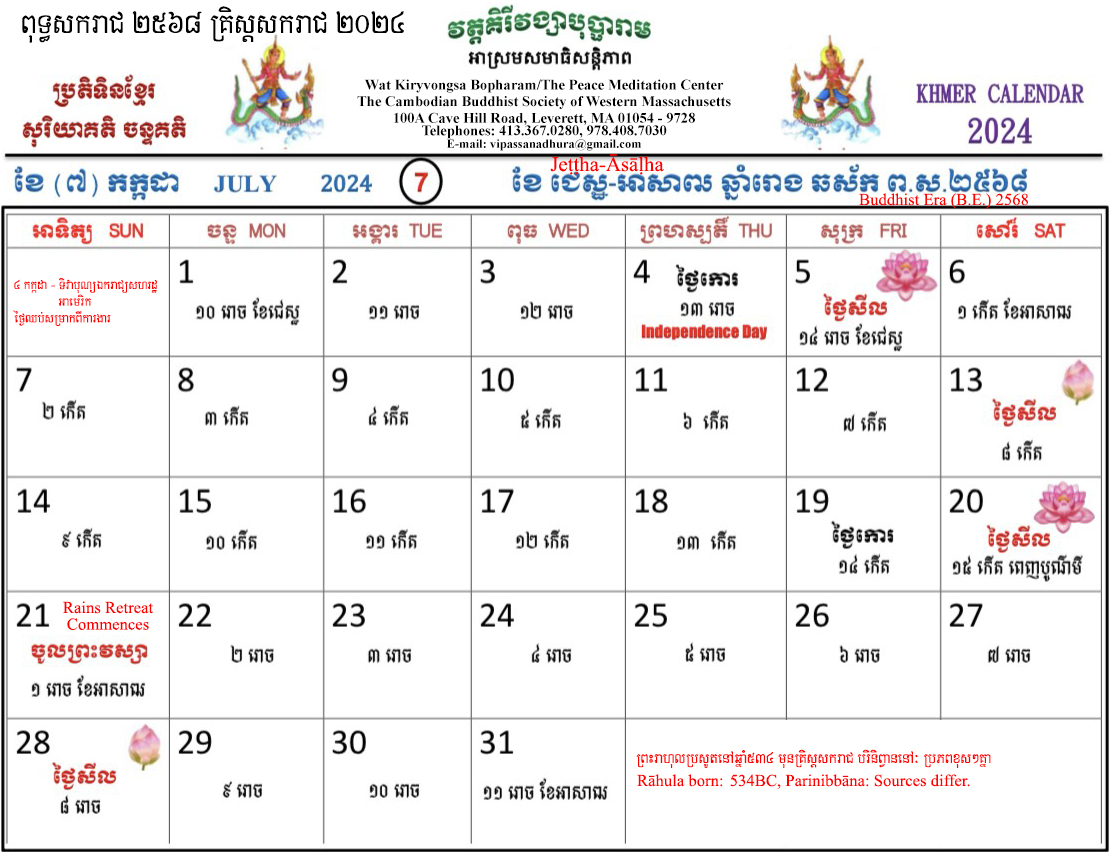
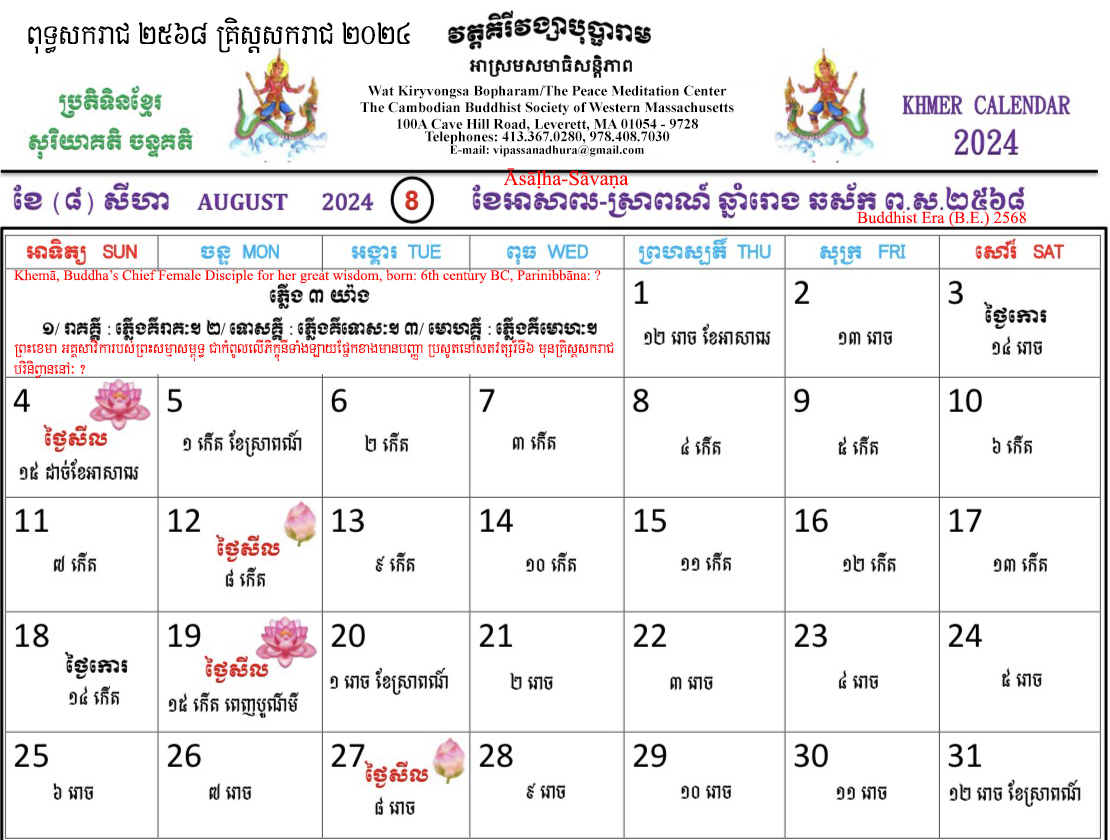
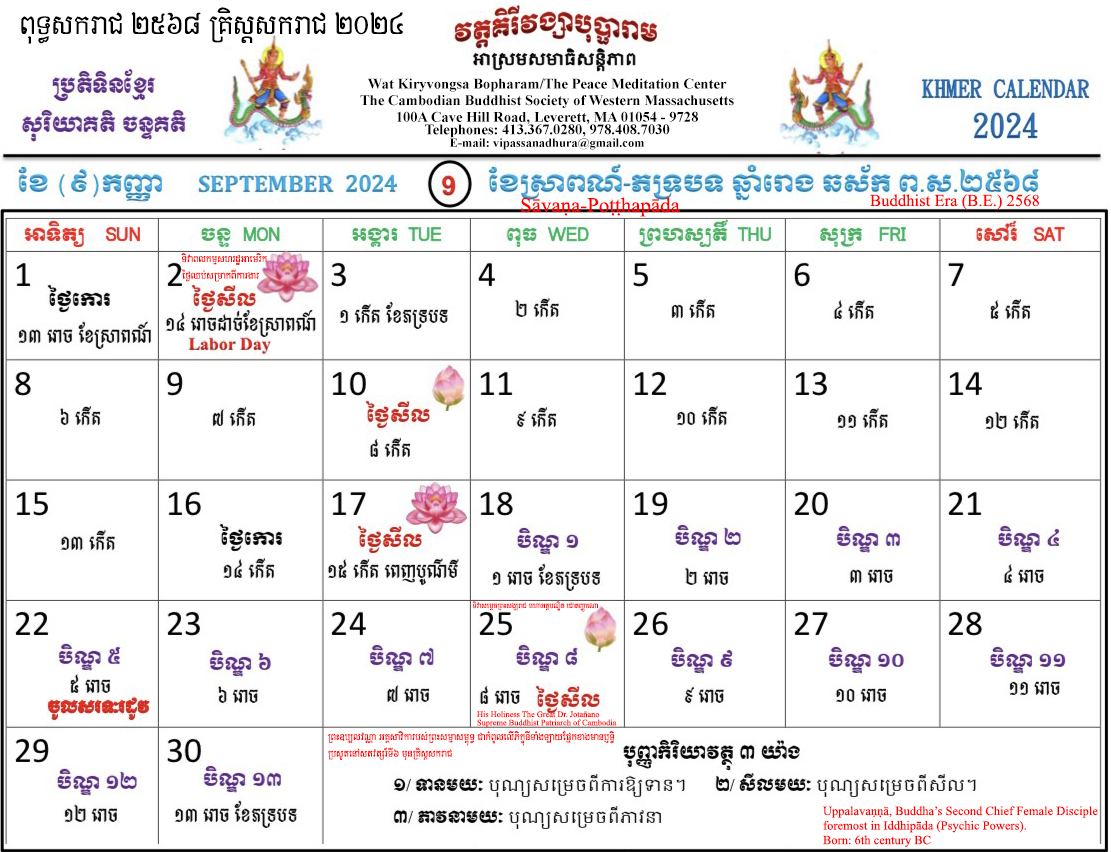
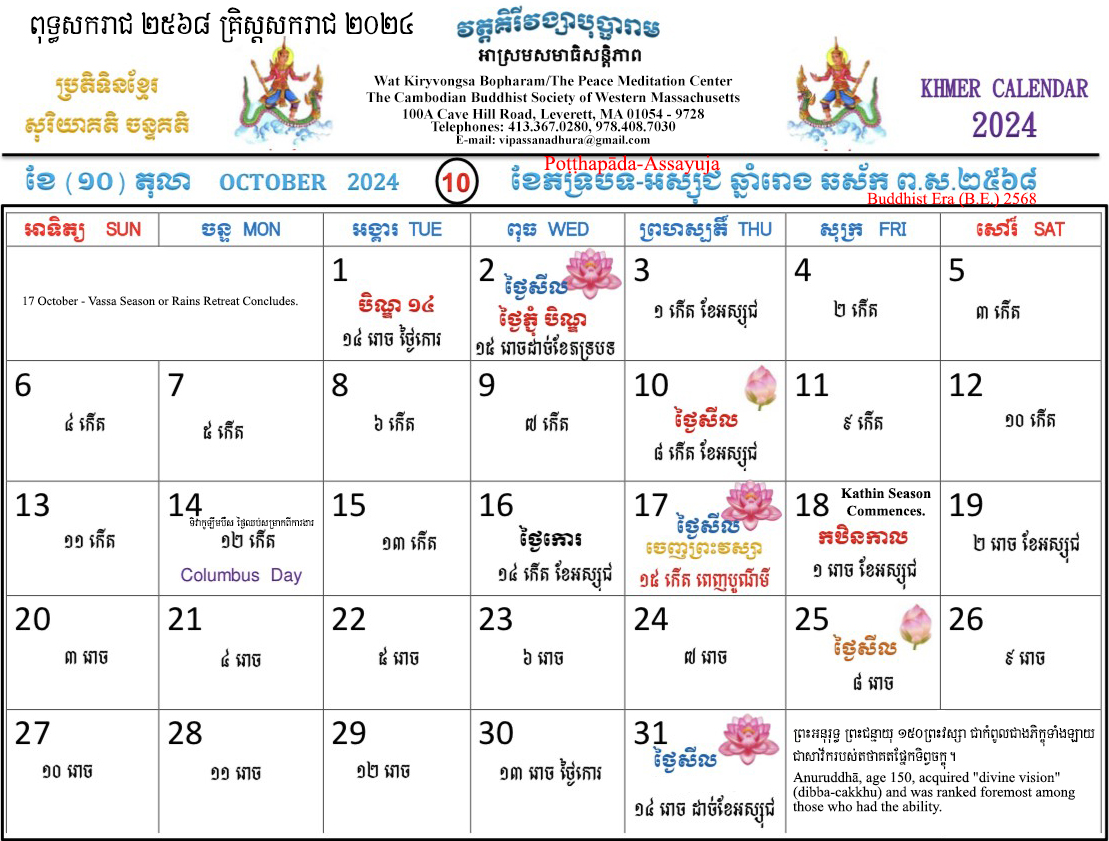
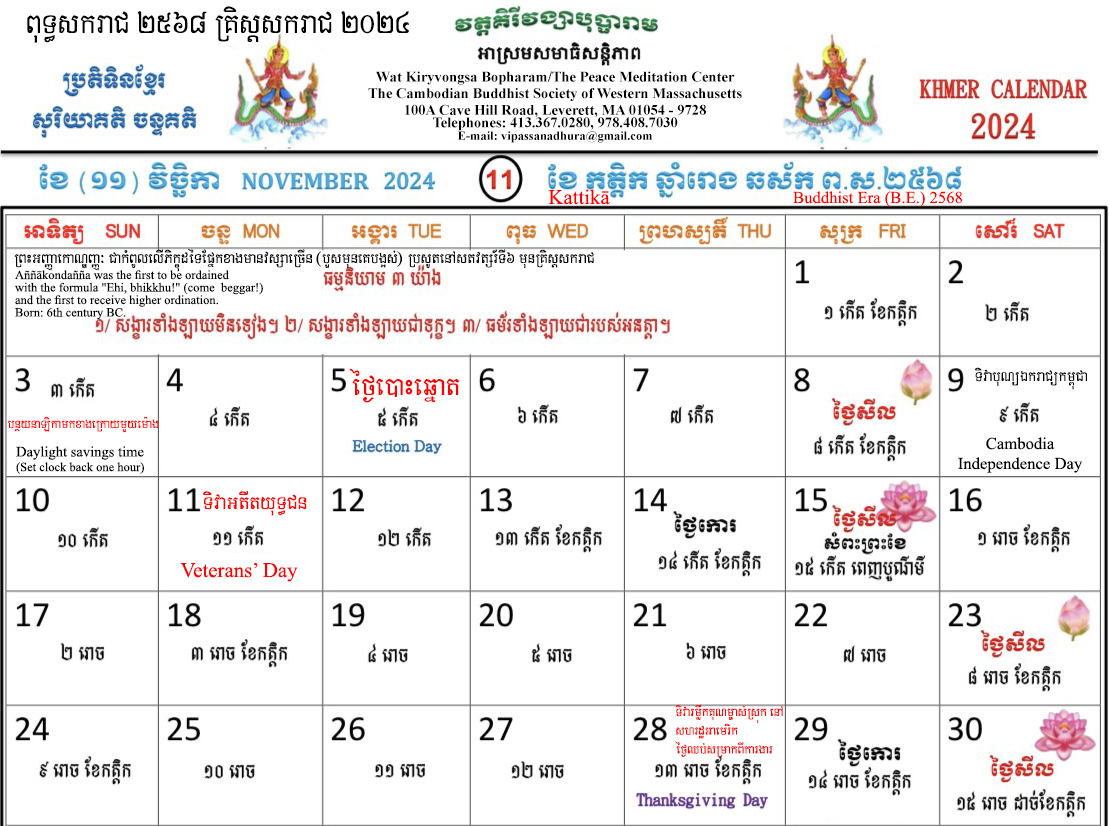
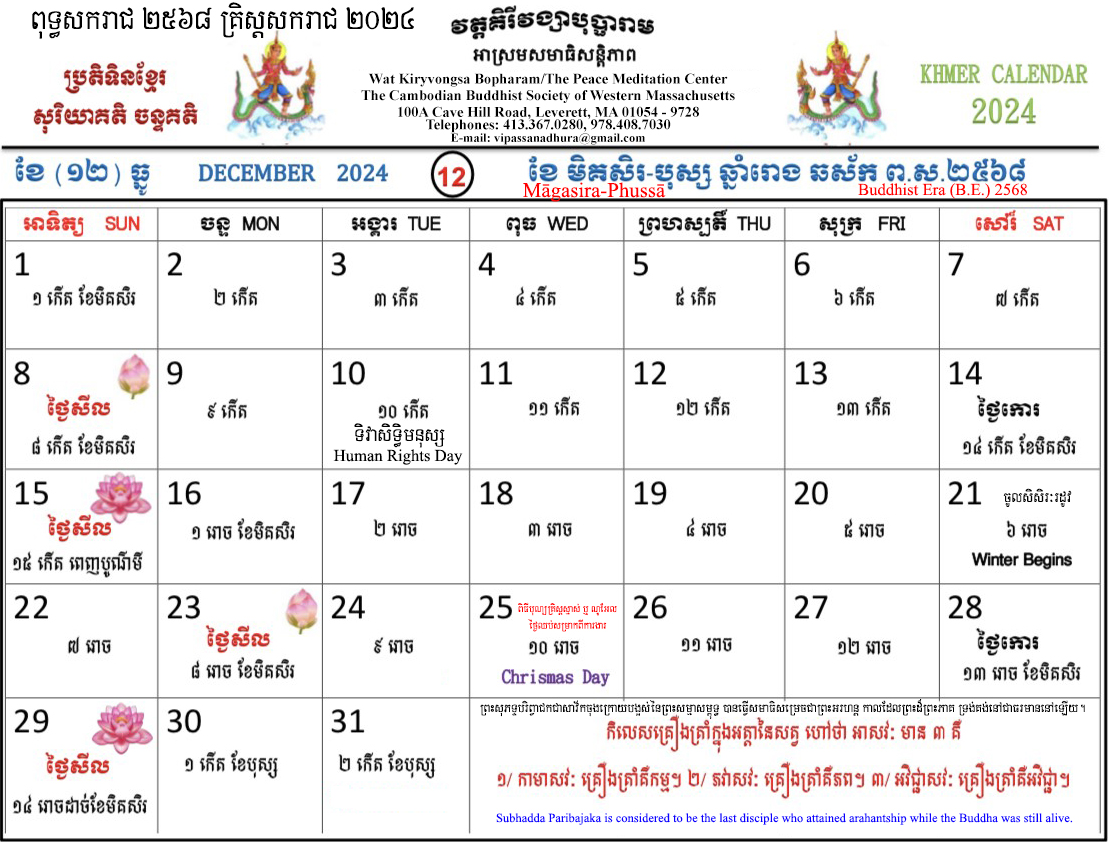
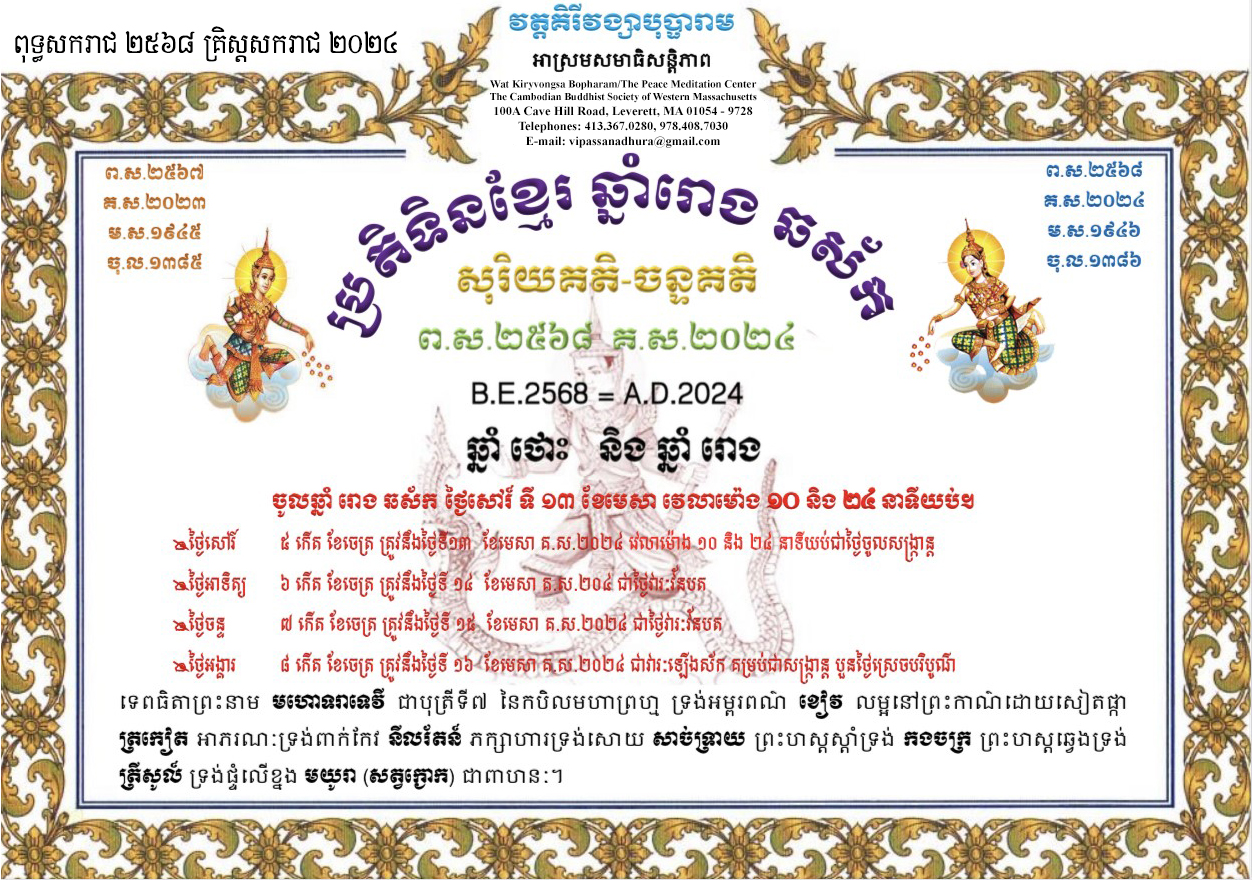
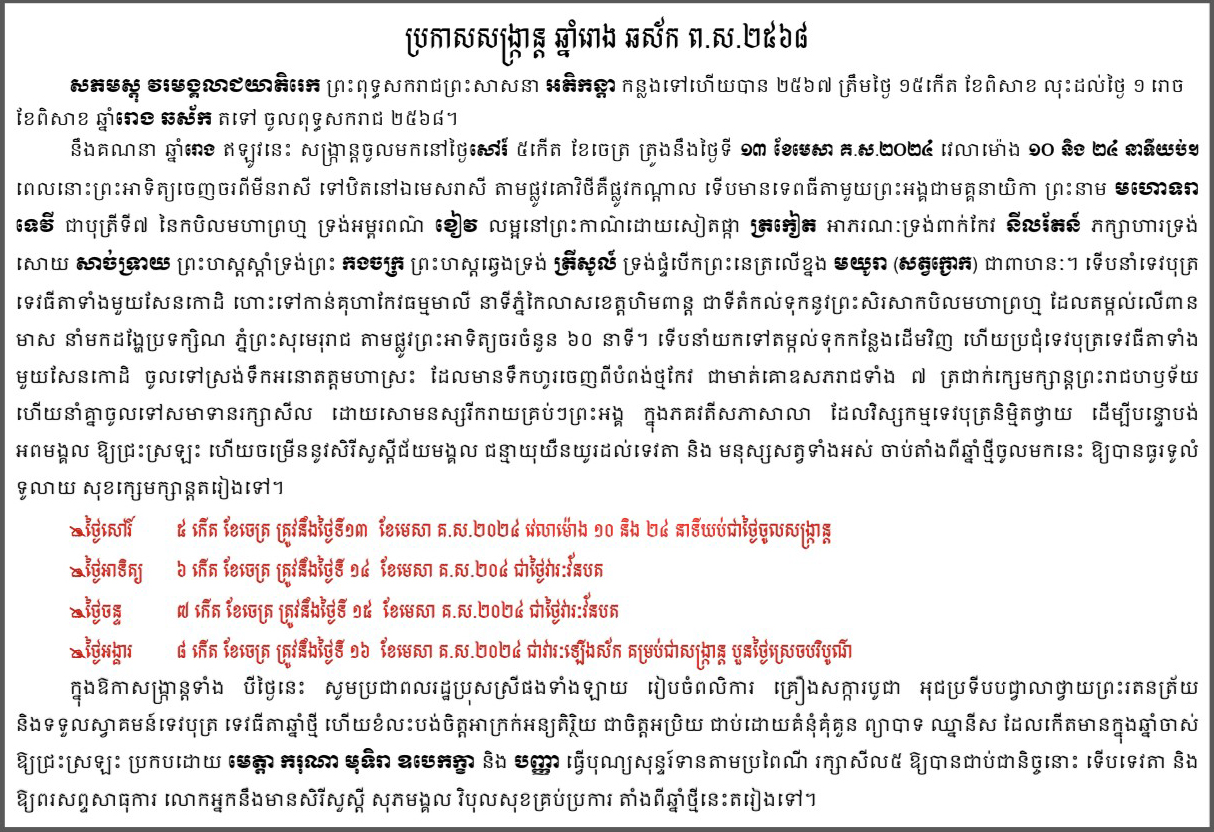
ពិធីបុណ្យកឋិនទាន នៅវត្ដគិរីវង្សាបុប្ផារាម អាស្រមសមាធិសន្ដិភាព ថ្ងៃទី១៩ ខែវិច្ឆិកា ២៥៦៧/២០២៣
Kathina Dana ceremony at the Kiryvongsa Bopharam Pagoda, the Peace Meditation Center, Leverett, Massachusetts, presided by the Maha Thera Sappanno of Wat Ratanaram of Bristol, Connecticut, on the 7th Waxing Moon of Kattika, Buddhis Era 2567 equivalent to November 19, A.D.20223
ពិធីបុណ្យកឋិនទាន នៅវត្ដគិរីវង្សាបុប្ផារាម អាស្រមសមាធិសន្ដិភាព ក្រោមអធិបតីភាពព្រះមហាថេរៈ សប្បញ្ញោ ដែលគង់នៅវត្ដរតនារាម ស្ថិតនៅរដ្ឋខនណិកធីខិត នាថ្ងៃ ៧កើត ខែកត្ដិក ឆ្នាំថោះ បញ្ចស័ក ព.ស.២៥៦៧ ត្រូវនឹងថ្ងៃទី១៩ ខែវិច្ឆិកា គ.ស.២០២៣
ពិធីបុណ្យកឋិនទាន នៅមជ្ឈមណ្ឌលសហគមន៍ព្រះសង្ឃខ្មែរអន្ដរជាតិ ថ្ងៃទី០៥ ខែវិច្ឆិកា ២៥៦៧/២០២៣
Kathina Dana ceremony at the International Community of Khmer Buddhist Monks Center in Pelham, Massachusetts on November 5, A.D.2023
ពិធីបុណ្យកឋិនទាន នៅមជ្ឈមណ្ឌលសហគមន៍ព្រះសង្ឃខ្មែរអន្ដរជាតិ ទីក្រុងផេលឡឹម រដ្ឋម៉ាសាឈូសិត្ដស៍ នាថ្ងៃ ៧រោច ខែអស្សុជ ឆ្នាំថោះ បញ្ចស័ក ព.ស.២៥៦៧ ត្រូវនឹងថ្ងៃទី០៥ ខែវិច្ឆិកា គ.ស.២០២៣
Ancestors Memorial Festivity on October 14, 2567/2023
ពិធីបុណ្យភ្ជុំបិណ្ឌប្រារព្ធនៅវត្ដគិរីវង្សាបុប្ផារាម អាស្រមសមាធិសន្ដិភាព នាថ្ងៃសៅរ៍ ១៥រោច ថ្ងៃសីល ដាច់ខែភទ្របទ ព.ស.២៥៦៧ ត្រូវនឹងថ្ងៃទី១៤ ខែតុលា គ.ស.២០២៣
Ancestors Memorial Festivity (Pjom Binda) at Wat Kiryvongsa Bopharam, the Peace Meditation Center on Saturday the 15th Waning Moon, Day of Abstinence, of Poṭṭhapāda, Buddhist Era 2567 equivalent to October 14, A.D.2023
ព្រះពុទ្ធប្បដិមាថ្មី នៅវត្តគិរីវង្សាបុប្ផារាម និង បូជនីយដ្ឋានព្រះពុទ្ធបរិនិព្វានដែលទើបសាងសង់ហើយ
ព្រះពុទ្ធប្បដិមាថ្មី នៅវត្តគិរីវង្សាបុប្ផារាម និង បូជនីយដ្ឋានព្រះពុទ្ធបរិនិព្វានដែលទើបសាងសង់ហើយ។ នៅថ្ងៃចន្ទ ១០រោច ខែភទ្របទ ឆ្នាំថោះ បញ្ចស័ក ព.ស.២៥៦៧ ត្រូវនឹងថ្ងៃទី០៩ ខែតុលា គ.ស.២០២៣ (បិណ្ឌទី១០) ពុទ្ធបរិស័ទបានយកចង្ហាន់មកប្រគេនព្រះភិក្ខុសង្ឃ នៅវត្តគិរីវង្សាបុប្ផារាម អាស្រមសមាធិសន្តិភាព។
Kathin at Kiryvongsa Bopharam Pagoda on NOV 18 – 19
ពិធីបុណ្យកឋិន នឹងប្រារព្ធនៅវត្ដគិរីវង្សាបុប្ផារាម នាថ្ងៃទី១៨ ដល់ ១៩ ខែវិច្ឆិកា ព.ស.២៥៦៧ គ.ស.២០២៣
Kathin to be held at the Kiryvongsa Bopharam Pagoda on November 18 - 19, B.E.2567 A.D.2023
ផ្សាយនៅថ្ងៃពុធ បិណ្ឌ ៥ ៥រោច ខែភទ្របទ ឆ្នាំថោះ បញ្ចស័ក ព.ស.២៥៦៧ ត្រូវនឹងថ្ងៃទី៤ ខែតុលា គ.ស.២០២៣
Posted on Wednesday the 5th Waning Moon of Poṭṭhapāda B.E.2567 equivalent to October 4, A.D.2023 Year of the Rabbit
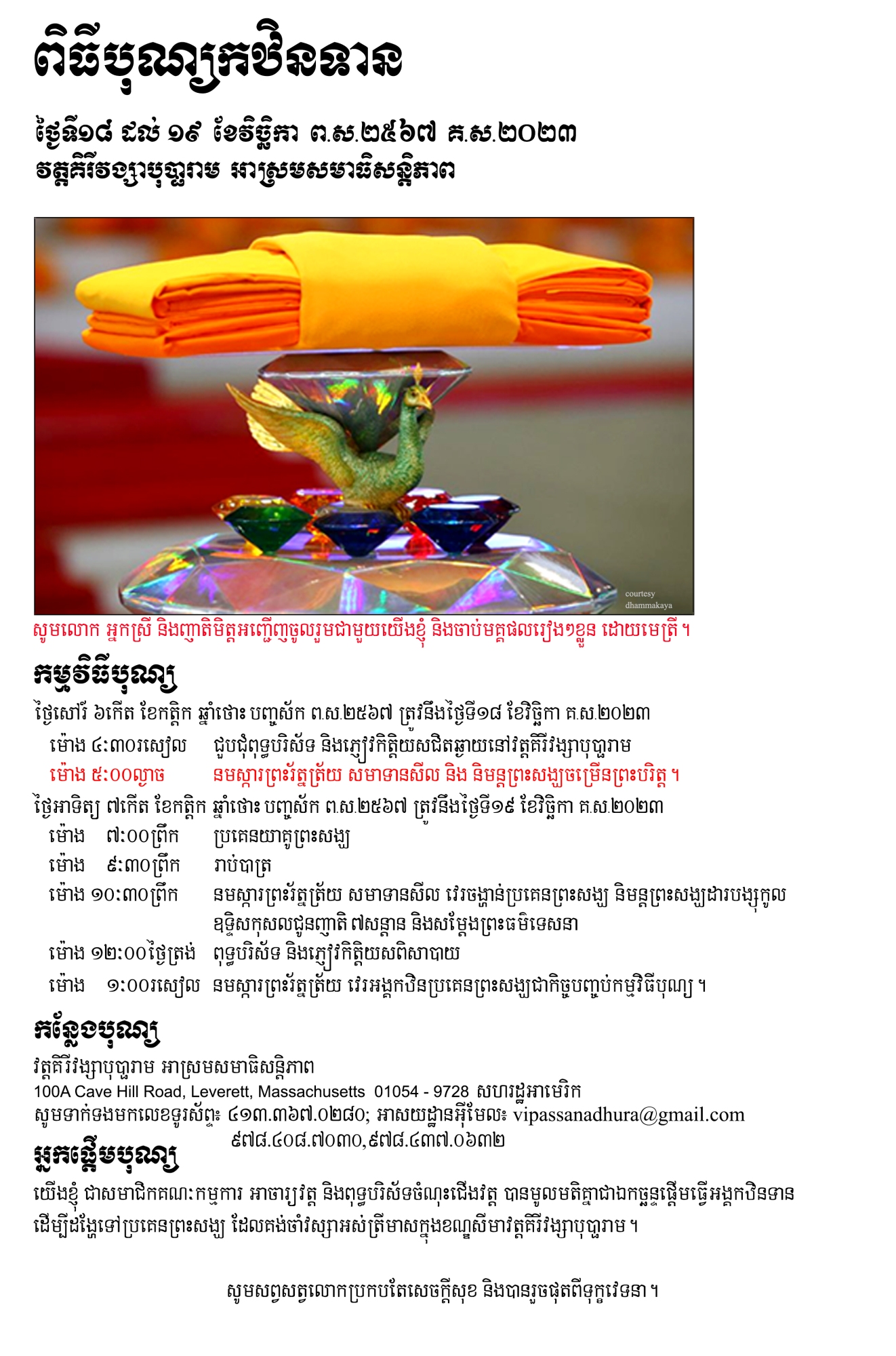
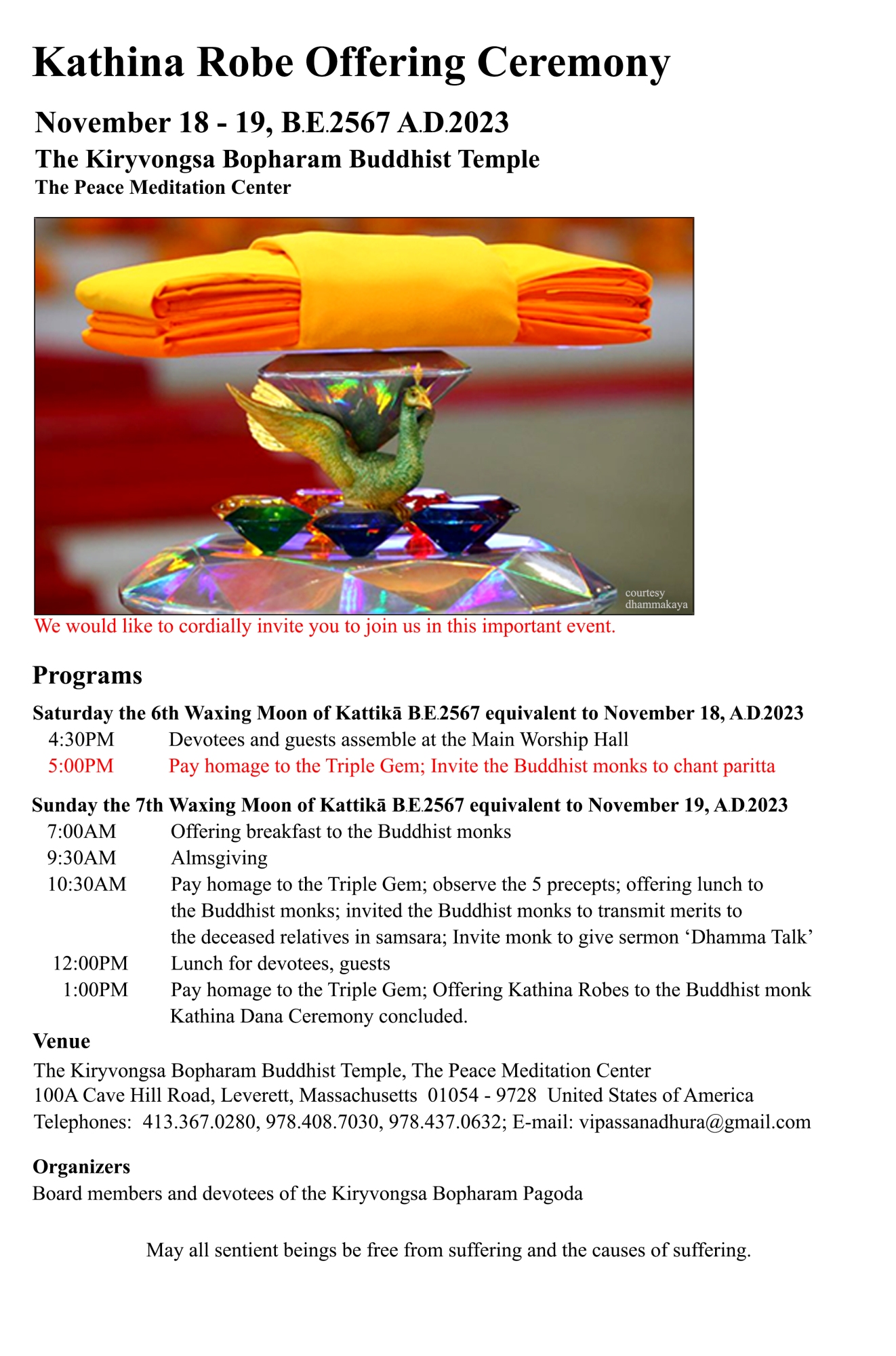
(more…)
MEDITATION DOCUMENTARIES
DHAMMA TALK BY VEN. KETODHAMMO
ព្រះធម្មទេសនាសំដែងដោយ ព្រះធម្មវិបស្សនា កេតុធម្មោ សំ ប៊ុនធឿន
Dhamma talk by the late and renowned Cambodian Vipassana Buddhist Master Ven. Ketodhammo Som Bunthoeun.
TEMPLENEWS TV SHOWS
Watch our shows on LTC – Channel 95
Broadcast hours | Fridays: 4 – 5 pm, 8 – 9 pm
Tuesdays 11 am - 12 pm
Email: templenewscast@yahoo.com
Phone: 978.853.9623
Website: templenews.org
Youtube: www.youtube.com/templenewstv
To find out more, including how to control cookies, see here: Cookie Policy
